Cancer
Diaries
Part Eight:
The Twisted Golden Rule
|
Written by
Rick Archer
January 2014
Many of us assume the
Golden Rule, "Do Unto Others As You Would Have Them do Unto
You", originated in the Christian faith.
Such is not the case.
A similar maxim appears in practically all the world's religions and
ethical traditions.
Considering just how
widespread this concept is across the world, what a shame the Golden
Rule is not observed more often.
There is a cynical
corollary to the Golden Rule that goes something like this:
"He Who
Owns the Gold Makes the Rules".
As you will read, this
twisted version of the Golden Rule completely explains why America
is stuck with one of the world's most mediocre health systems.
|
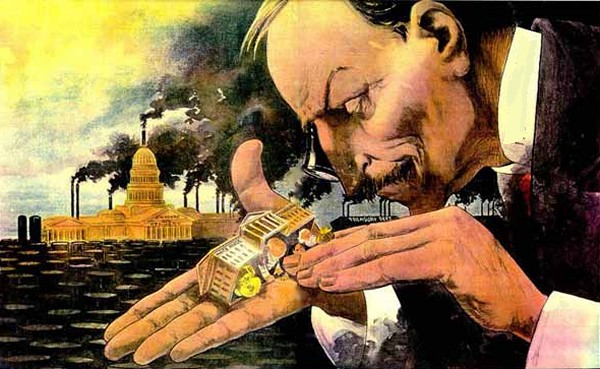 |
Keep in mind my "Cancer
Diaries" began as an
investigation into what seems to be the deliberate suppression of
several potential "alternative" cures
to cancer over the past century. Just the thought that
someone would deliberately deprive the human race of a remedy to
this dread scourge is difficult to accept, but I have come to
believe that is exactly what has happened.
During my research, I
have discovered the reprehensible action of deliberately
sabotaging promising cancers cures is just one
part of a widespread 'disease' that extends throughout America's
entire Medical Industry.
While I continue to
believe that America has many of the finest doctors, hospitals
and research facilities in the world, I am flabbergasted to
learn that health care in America has become far too expensive
for most of the people it was meant to serve. It isn't
just the poor who cannot afford to get sick, now the middle
class is just as terrified. 60% of all bankruptcies in
America today are related to the inability to pay for
catastrophic illnesses. One single illness can
effortlessly wipe out someone's entire life savings.
I am convinced that
the problems in finding a cure for cancer are actually just
another symptom of a medical system that is unbelievably
corrupt, ridiculously inefficient, and insanely profitable for
those "insiders" who benefit from rigging the game.
Let us begin our
look at the problems in American medicine with the following
story.
|
Our Broken American Medical
System
|
Why Medical Bills Are Killing Us
By Steven Brill, TIME Magazine
27 February
2013
|
When Sean Recchi, a 42-year-old from
Lancaster, Ohio, was told in March
2012 that he had non-Hodgkin's lymphoma, his wife Stephanie
knew she had to get him to MD Anderson Cancer Center in Houston.
Stephanie's father had been treated there 10 years earlier, and she
and her family credited the doctors and nurses at MD Anderson with
extending his life by at least eight years.
Because Stephanie and her husband had recently started their own
small technology business, they were unable to buy comprehensive
health insurance. For $469 a month, or about 20% of their income,
they had been able to get only a policy that covered just $2,000 per
day of any hospital costs. "We don't take that kind of discount
insurance," said the woman at MD Anderson when Stephanie called to
make an appointment for Sean.
Stephanie was then told by a billing clerk that the estimated
cost of Sean's visit - just to be examined for six days so a
treatment plan could be devised - would be $48,900, due in advance.
Stephanie got her mother to write her a check. "You do anything you
can in a situation like that," she says.
The Recchis flew to Houston, leaving
Stephanie's mother to care for their two teenage children.
About a week later, Stephanie had to ask her mother for
$35,000 more so Sean could begin the treatment the doctors had
decided was urgent. His condition had worsened rapidly since he had
arrived in Houston. He was "sweating and shaking with chills and
pains," Stephanie recalls. "He had a large mass in his chest that
was ... growing. He was panicked."
Nonetheless, Sean was held for about 90 minutes in a reception
area, she says, because the hospital could not confirm that the
check had cleared. Sean was allowed to see the doctor only after he
advanced MD Anderson $7,500 from his credit card. The hospital says
there was nothing unusual about how Sean was kept waiting. According
to MD Anderson communications manager Julie Penne, "Asking for
advance payment for services is a common, if unfortunate, situation
that confronts hospitals all over the United States."
The total cost, up
front payable in advance, for Sean to get his treatment plan
and initial doses of chemotherapy was $83,900.
There was no insurance. This money would have to come out of
his pocket. Otherwise he could just go home and continue
dying.
The first of the 344 lines printed
out across eight pages of his hospital bill - filled with
indecipherable numerical codes and acronyms - seemed
innocuous.
Here is one
item. It read, "1 ACETAMINOPHE TABS 325 MG."
The charge was only $1.50, but it was for a generic
version of a Tylenol pill.
You can buy 100 of them on Amazon
for $1.49 even without a hospital's purchasing power...
in other words, a 100% markup. That set the tone for
all that followed.
Dozens of midpriced items were embedded with similarly
aggressive markups, like $283.00 for a "CHEST, PA AND LAT
71020." That's a simple chest X-ray, for which MD Anderson
is routinely paid $20.44 when it treats a patient on
Medicare, the government health care program for the
elderly.
Every time a nurse drew blood, a "ROUTINE VENIPUNCTURE"
charge of $36.00 appeared, accompanied by charges of $23 to
$78 for each of a dozen or more lab analyses performed on
the blood sample.
In all, the charges for blood and other
lab tests done on Recchi amounted to more than $15,000.
Had Recchi been old enough for
Medicare, MD Anderson would have been paid a few hundred
dollars for all those tests.
By law, Medicare's payments
approximate a hospital's cost of providing a service,
including overhead, equipment and salaries.
On the second page of the bill, the
markups got bolder. Recchi was charged $13,702 for "1
RITUXIMAB INJ 660 MG." That's an injection of 660 mg of a
cancer wonder drug called Rituxan. The average price paid by
all hospitals for this dose is about $4,000, but MD Anderson
probably gets a volume discount that would make its cost
$3,000 to $3,500. That means the nonprofit cancer center's
paid-in-advance markup on Recchi's lifesaving shot would be
about 400%.
When I asked MD Anderson to comment on the charges on
Recchi's bill, the cancer center released a written
statement that said in part, "The issues related to
health care finance are complex for patients, health care
providers, payers and government entities alike ... MD
Anderson's clinical billing and collection practices are
similar to those of other major hospitals and academic
medical centers."
The hospital's hard-nosed approach
definitely pays off. Although it is officially a
"nonprofit" unit of the
University of Texas, MD Anderson
is hardly a non-profit operation.
MD Anderson
has revenue that exceeds the cost of the world-class care it
provides by so much that its operating profit for the fiscal
year 2010, the most recent annual report it filed with the
U.S. Department of Health and Human Services, was $531
million.
That's a profit margin of 26% on
revenue of $2.05 billion, an astounding result for such a
service-intensive enterprise.
The president of MD Anderson is paid like someone running a
prosperous business. Ronald DePinho's total compensation
last year was $1,845,000.
That does not count outside
earnings derived from a much publicized waiver he received
from the university that, according to the Houston
Chronicle, allows DePinho to maintain unspecified "financial
ties with his three principal pharmaceutical companies."
DePinho's salary is nearly two and
a half times the $750,000 paid to Francisco Cigarroa, the
chancellor of entire University of Texas system, of which MD
Anderson is a part.
This pay structure is emblematic of
American medical economics and is reflected on campuses
across the U.S., where the president of a hospital or
hospital system associated with a university - whether it's
Texas, Stanford, Duke or Yale - is invariably paid much more
than the person in charge of the university.
|
Rick Archer's Note: While you read
about the misery of Sean Recchi's dilemma - death,
bankruptcy, or both! - keep in mind that study after study
confirms the USA has one
of the most miserable health systems in the world.
Yes, it is true that if you are rich, you can get excellent
health care in America. But how many of us are rich?
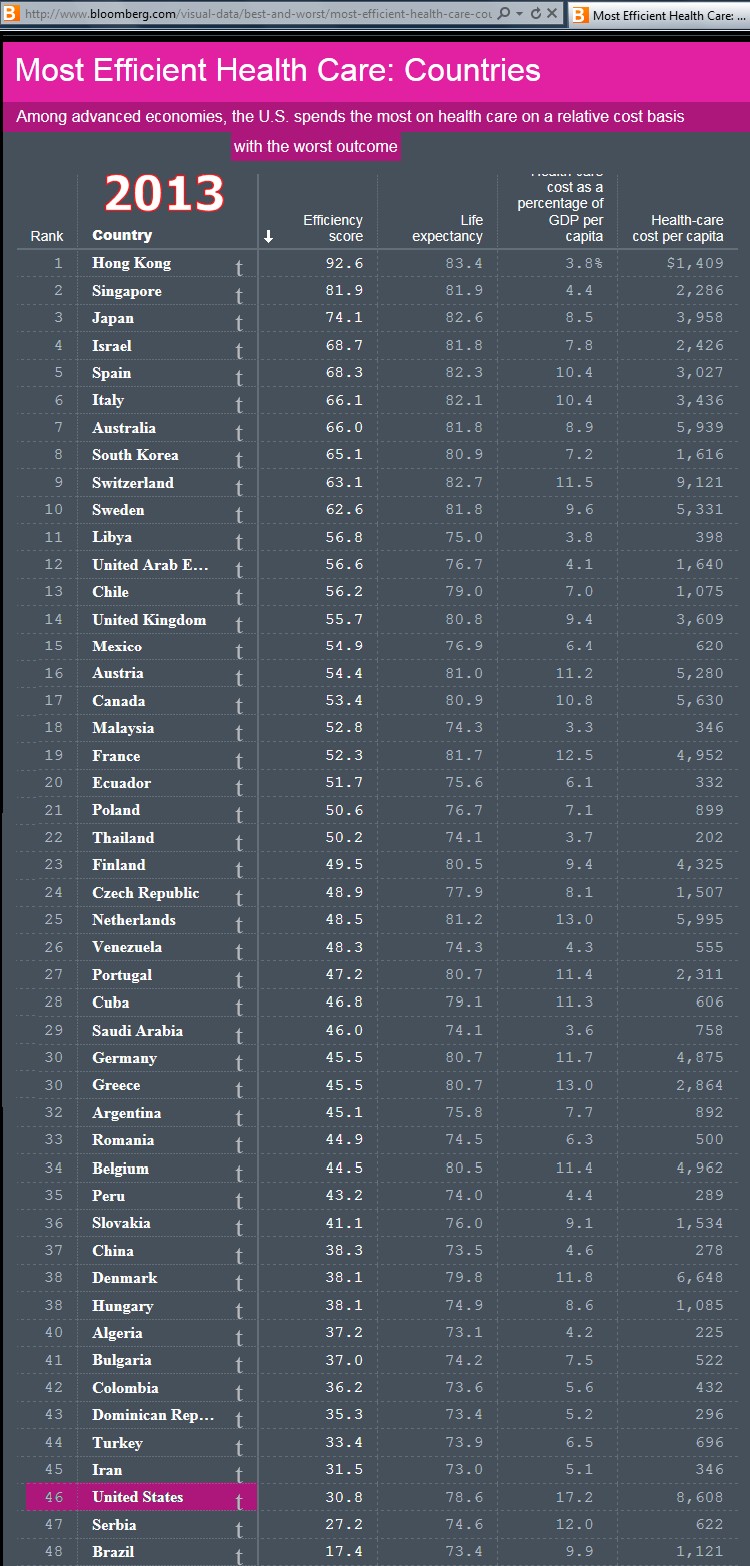
According to this chart, only one country
in the world pays more per person than the USA. That
would be Switzerland. Before you feel too sorry for
Switzerland, this country is rated as one of the Top Ten
best health care systems in the world.
In the
USA, we
pay $8,608 per person. According to this chart, you could go
to Iran and get better treatment for $346.
17% of
our earnings go to medical care. No other nation is
even close!
It is
absurd to think how much we pay and how little we get in
return.
That
"$8,608 per person" is a legitimate statistic. At age
64, I pay $830 a month in insurance. That means I pay
close to $10,000 a year up front. That is a stiff
price for a person like me who is retired. THEN there
is the $2,500 deductible....
What
is darkly fascinating is that America is clearly slipping in
the rankings. In 2006, the USA was #37. Now we
are #46! All that hype about America with its finest
doctors, the finest hospitals, the greatest medical
schools... well, some of it may be true... but our actual
national system of medical delivery to the citizens is
completely and totally broken.
|
|
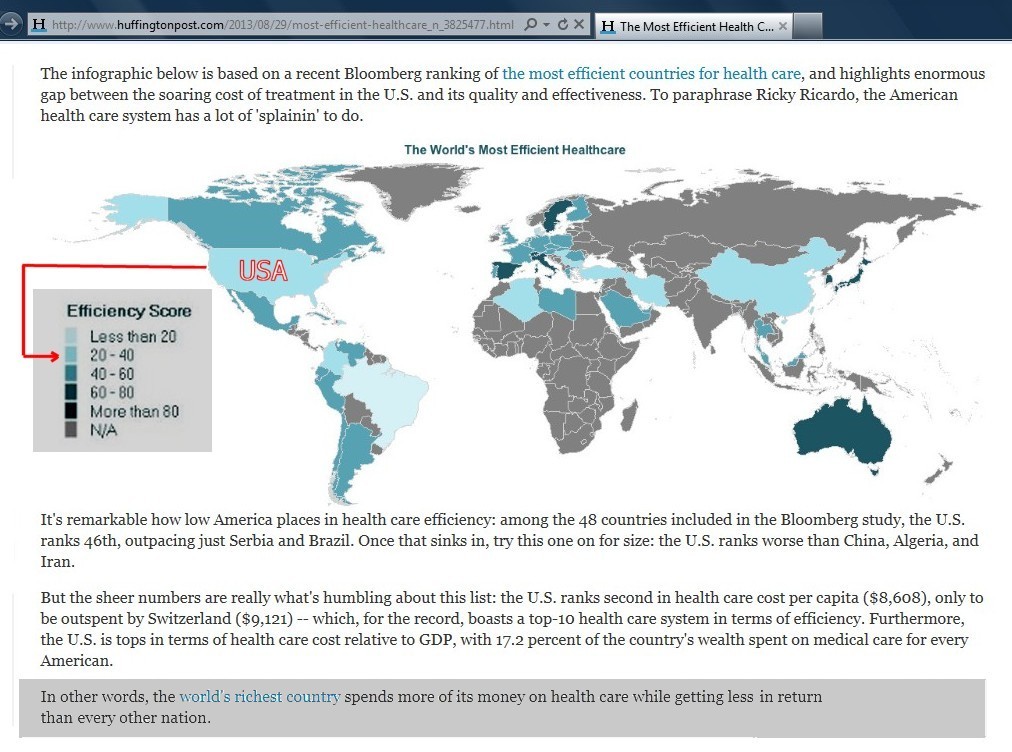
|
The Texas Medical Center
(Steven Brill's Article
continued)
Steven Brill, the
writer for Time Magazine:
I
got the idea for this
health care article when I was
visiting
Houston's Rice University last
year.
|
 |
As I was leaving the
campus, which is just outside the central business district
of Houston, I noticed a group of glass skyscrapers about a
mile away lighting up the evening sky.
The scene looked like Dubai. I was looking
at the Texas Medical Center, a nearly 1,300-acre, 280-building
complex of hospitals and related medical facilities, of which MD
Anderson is the lead brand name.
Medicine had obviously become a huge business
in Houston. One look at that endless array of imposing
structures was all it took to make this clear.
In fact, of Houston's top 10 employers,
five are hospitals, including MD Anderson with 19,000 employees;
three, led by ExxonMobil with 14,000 employees, are energy
companies.
How did that happen, I wondered. Where's
all that money coming from? And where is it going?
|
Why
was Sean Recchi's bill so expensive?
(Brill's Article continued)
I have spent the past seven months trying
to find out by analyzing a variety of bills from hospitals like MD
Anderson, doctors, drug companies and every other player in the
American health care ecosystem.
When you look behind the bills that Sean Recchi and other
patients receive, you see nothing rational - no rhyme or reason -
about the costs they faced in a marketplace they enter through no
choice of their own. The only constant is the sticker shock for the
patients who are asked to pay.
Yet those who work in the health care industry and those who
argue over health care policy seem inured to the shock. When we
debate health care policy, we seem to jump right to the issue of who
should pay the bills.
While this is an
important question, it ignores what
should be the first
question:
Why exactly are the bills so high?
What are the reasons, good or bad, that cancer means a
half-million- or million-dollar tab? Why should a trip to the
emergency room for chest pains that turn out to be indigestion bring
a bill that can exceed the cost of a semester of college? What makes
a single dose of even the most wonderful wonder drug cost thousands
of dollars? Why does simple lab work done during a few days in a
hospital cost more than a car? And what is so different about the
medical ecosystem that causes technology advances to drive bills up
instead of down?
Recchi's bill and six others examined line by line for this
article offer a closeup window into what happens when powerless
buyers - whether they are people like Recchi or big health-insurance
companies - meet sellers in what is the ultimate seller's market.
The result is a uniquely American gold rush for those who
provide everything from wonder drugs to canes to high-tech implants
to CT scans to hospital bill-coding and collection services. In
hundreds of small and midsize cities across the country - from
Stamford, Conn., to Marlton, N.J., to Oklahoma City - the American
health care market has transformed tax-exempt "nonprofit" hospitals
into the towns' most profitable businesses and largest employers,
often presided over by the regions' most richly compensated
executives.
And in our largest cities, the system
offers lavish paychecks even to midlevel hospital managers, like the
14 administrators at New York City's Memorial Sloan-Kettering Cancer
Center who are paid over $500,000 a year, including six who make
over $1 million.
Taken as a whole, these powerful institutions and the bills
they churn out dominate the nation's economy and put demands on
taxpayers to a degree unequaled anywhere else on earth. In the U.S.,
people spend almost 20% of the gross domestic product on health
care, compared with about half that in most developed countries. Yet
in every measurable way, the results our health care system produces
are no better and often worse than the outcomes in those countries.
According to one of a series of exhaustive studies done by
the McKinsey & Co. consulting firm,
the USA spends more on health care
than the next 10 biggest spenders combined: Japan, Germany, France,
China, the U.K., Italy, Canada, Brazil, Spain and Australia.
The Lobbyists and the Politicians
(Steven Brill's Article continued)
We may be shocked at the $60 billion price
tag for cleaning up after Hurricane Sandy.
Our nation spent almost that much last
week on health care... and then again and again
and again every week of the year. We spend more every year on
artificial knees and hips than what Hollywood collects at the box
office. We spend two or three times that much on durable medical
devices like canes and wheelchairs,
in part because a heavily lobbied Congress
forces Medicare to pay 25% to 75% more for this equipment than it
would cost at Walmart.
The Bureau of Labor Statistics projects that 10 of the 20
occupations that will grow the fastest in the U.S. by 2020 are
related to health care. America's largest city may be commonly
thought of as the world's financial-services capital, but of New
York's 18 largest private employers, eight are hospitals and four
are banks. Employing all those people in the cause of curing the
sick is, of course, not anything to be ashamed of. But the drag on
our overall economy that comes with taxpayers, employers and
consumers spending so much more than is spent in any other country
for the same product is unsustainable. Health care is eating away at
our economy and our treasury.
The health care industry seems to have the will and the means to
keep it that way. According to the Center for Responsive Politics,
the pharmaceutical and health-care-product industries, combined with
organizations representing doctors, hospitals, nursing homes, health
services and HMOs, have spent $5.36 billion since 1998 on lobbying
in Washington. That dwarfs the $1.53 billion spent by the defense
and aerospace industries and the $1.3 billion spent by oil and gas
interests over the same period. That's right: the
health-care-industrial complex spends more than three times what the
military-industrial complex spends in Washington.
When you crunch data compiled by McKinsey and other
researchers, the big picture looks like this:
Americans are likely to spend $2.8
trillion this year on health care.
That $2.8 trillion is likely to be $750
billion, or 27%, more than we would spend if we spent the same per
capita as other developed countries, even after adjusting for the
relatively high per capita income in the U.S. vs. those other
countries.
Of the total $2.8 trillion that will be
spent on health care, about $800 billion will be paid by the federal
government through the Medicare insurance program for the disabled
and those 65 and older and the Medicaid program, which provides care
for the poor. That $800 billion, which keeps rising far faster than
inflation and the gross domestic product, is what's driving the
federal deficit. The other $2 trillion will be paid mostly by
private health-insurance companies and individuals who have no
insurance or who will pay some portion of the bills covered by their
insurance. This is what's increasingly burdening businesses that pay
for their employees' health insurance and forcing individuals to pay
so much in out-of-pocket expenses.
|
The Effects of
Rising Health Care Costs
on Middle-Class Economic Security (source:
AARP)
Harriet Komisar
Georgetown University
EXECUTIVE SUMMARY
Health care costs, including costs for long-term services and
supports, are a growing burden for middle-class families across all
age groups. Wages have not kept up with increases in health care
costs, and more middle-class families are struggling to cope with
higher health insurance premiums and higher out-of-pocket expenses
when they have an illness. Rising health care costs are crowding out
other important priorities for workers, such as saving for their own
retirement or for their children's college
education.
Employers have responded to higher health
care costs by scaling back wage increases, shifting cost increases
to their employees, or changing the type of insurance they offer.
If these trends continue, many people who had been middle-class
throughout their working years will be at risk of not having enough
financial resources to maintain a middle-class lifestyle during
their retirement years. Increased out-of-pocket costs to Medicare
beneficiaries and the often catastrophic costs of long-term services
and supports are major threats to middle-class security for retirees
and family members, who often end up in caregiving roles.
Key Findings
This report documents the impact of rising health care and long-term
services and supports costs for middle-class workers and retirees.
Some key findings are as follows:
•
National health care
spending in the United States averaged $8,402 per person in
2010¡X72 percent higher than a decade earlier when it was
$4,878, and nearly triple the 1990 level of $2,854.
•
Health care spending has
been growing faster than inflation and the overall economy.
Between 2000 and 2010, health care spending per person grew at
an average rate of 5.6 percent per year, outpacing inflation
(2.4 percent per year) and the growth in gross domestic product
per person (2.9 percent per year).
• Over
the past decade, the average amount that middle-income
households spent on health care increased by 51 percent¡,
nearly double the growth in their incomes (30 percent)
and three times the rate of growth in their spending for all
other products and services.
•
With rising health
care costs, more people under 65 are burdened with high health
care spending. In 2009, 21 percent of middle-income people under
65 reported spending more than 10 percent of their incomes on
health care expenses, compared to 15 percent
of middle-income people in 2001.
•
One in five people are
in families that have problems paying medical bills. Many of
these families have experienced serious financial stress, such
as problems paying for other necessities (e.g., food, clothing,
and housing) or medically related bankruptcy.
•
Health insurance
premiums for employer-sponsored insurance nearly doubled over
the past decade, with total premiums (employers and workers
shares) increasing from an average of $7,601 per year in 2001 to
$15,073 in 2011 for family coverage. Rising premiums contributed
to a rise in the proportion of people without health insurance.
•
Employers have
responded to rising health care costs by shifting more health
insurance costs to employees, offering high-deductible health
plans with lower premiums but higher cost sharing, and limiting
wage growth.
•
Health-related
expenses absorb a large share of incomes for people age 65 and
older, and that share is projected to grow over time. The share
of household income spent on health care expenses is projected
to reach 18 percent for future retirees, compared to 8 percent
for today's retirees.
|
Whoever has the Gold, Makes
the Rules
|
Rick Archer's Note:
Are you depressed yet? Hey, I better
warn you: this article gets much worse.
Before I get into the specifics of how the
Twisted Golden Rule affects our medical system, first I need to
demonstrate how this rule is applied here in America. It
didn't take me long to find two examples of how the Twisted Golden
Rule works.
Twisted
Golden Rule, Example 1
2013:
Monsanto's Genetically Modified Wheat
"The strange case of
genetically engineered wheat on a farm in Oregon remains as
mysterious as ever. If anything, it's grown more baffling.
As we reported almost two months ago, the presence of this wheat
was revealed earlier this spring when a farmer in eastern Oregon
sprayed a field with the weedkiller glyphosate, or Roundup. Most
vegetation died, as the farmer intended, but clumps of green
wheat stalks kept growing. They apparently had sprouted from
grain that was leftover in the field from last year's crop.
It was such a strange sight that the farmer wondered if this
wheat might be genetically modified to be resistant to
glyphosate, just like the popular Roundup Ready versions of corn
and soybeans. He called a weed scientist named Carol
Mallory-Smith at Oregon State University to ask her opinion.
"I said I didn't think so," recalls Mallory-Smith. The biotech
company Monsanto had developed such wheat years earlier, and
carried out field trials of it, but those trials ended at least
eight years ago. Monsanto never asked for government approval to
sell such wheat, and growing it without a permit from the U.S.
Department of Agriculture actually would violate the law.
"So I was pretty skeptical, but I said, 'If you send me some
samples, I'll test it,' " Mallory-Smith says.
To her surprise the tests came back positive. She passed the
samples on to the USDA, which confirmed her results and launched
an investigation.
The USDA is trying to answer two big questions about this wheat.
First, where else can it be found? Second, how did it get into
this farmer's field?"
[Source:
NPR]
In May 2013,
genetically-modified (G.M.) wheat that was never approved for sale
inexplicably turned up in a field in Oregon. A farmer found the crop
when it miraculously survived a dousing of Roundup weedkiller.
Astounded by the crop's resistance, the farmer took samples to a lab
to be tested. The wheat was revealed to be an illegal strain.
The indestructible wheat had been genetically modified to resist pesticides by Monsanto,
the biotech corporation that owns the patents to both the pesticide
AND the genetically-modified wheat.
One of the new genes
inserted into Monsanto's G.M. wheat had made it resistant to the
herbicide Roundup Ready, which ironically is also manufactured by
Monsanto. (now isn't that curious??)
No one at Monsanto could
explain how this random crop of Roundup-resistant wheat showed up in
Oregon. It had been over ten years since Monsanto last tested
its wheat in the area. No normal seeds should last more than
two years, especially in a place like Oregon with hard winter
freezes.
Another strange
phenomenon is that 24 different strains of giant super-weeds seem to have
acquired a similar immunity to Roundup. In an eerie parallel
to the disease MRSA, a new strain of bacteria highly
resistant to some antibiotics, scientists wonder if the weeds have
developed their immunity by
somehow absorbing the same genes that Monsanto's G.M. wheat possess.
There remains a great
deal of suspicion towards G.M. food in the world community.
Europe wants nothing to do with it. Thanks in large part to
the French writer Marie-Monique Robin and her book The World
According to Monsanto: Pollution, Corruption, and the Control of the
World's Food Supply, many Europeans do not trust Monsanto. Neither does Japan and
South Korea. No one is quite sure just how safe or just how
dangerous this genetically altered wheat is. It could be
a ticking time bomb. It might take a generation or more for
any sinister effects to appear.
What people do know is
there is an increasing suspicion that America's widespread use of
toxic chemicals might be responsible for the growing rate of cancer.
When we ask our
doctors if these chemicals might be responsible for the
greater incidence, we are frequently told that "cancer is on the rise because people live longer
and cancer preys on the old".
Maybe so, but another
equally valid possibility might be the
pesticides on your food, chemicals that have been leaked into your
water AND soil AND air AND into your clothes
AND into your home, into your
household cleaning products and into the lotions and potions you spray
and rub onto your skin, and into the vaccines injected into your body.
|
 |
"The numbing irony is that
the same corporations that produce carcinogenic chemicals,
including agricultural ones,
are also running the cancer treatment industry and selling
chemotherapy drugs.
Now that's what I call
vertical integration!"
- Ken Ausubel
|
In other words, when it
comes to any situation involving certain American chemical giants,
the trust level in the developed countries is not very high.
Sure enough, immediately after this illegal wheat discovery in
Oregon, Japan and South Korea cancelled enormous shipments of wheat
from Oregon, citing fears that the wheat crop could be tainted with
this suspicious seed.
Immediately farmers
across America reacted in anger because the price of wheat dropped
precipitously due to the bad news. Several lawsuits were filed
citing Monsanto's sloppiness in allowing this accident to happen,
thereby affecting their livelihood.
Monsanto dismissed the
lawsuit as “a wild swing that is unlikely to connect.”
Citing the fact that the wheat was growing randomly, like a weed, it
seems likely that this was a case of accidental contamination (or
perhaps deliberate sabotage), rather than a deliberate planting of
the illegal crop. “There was no negligence. Tractor-chasing
lawyers have prematurely filed suit without any evidence of fault
and in advance of the crop’s harvest,” said Monsanto’s general
counsel.
In the past, the USDA
has shown little sympathy for farmers whose crops have been
inadvertently contaminated by Monsanto. Last year, the agency
dismissed complaints by conventional and organic farmers that GM
seeds intermingle with their own strains, simply advising they buy
insurance to recoup their financial losses.
Humorist Stephen
Colbert had a "field day" with this news.
Calling the
strange crop "Zombie Wheat" because nothing could kill it
and it lived forever, he said the lyrics in "America the
Beautiful" would have to rewritten... “amber waves of
frankengrain”.
Then Colbert
suggested the networks release a sequel to the popular
"Walking Dead" series with "the Return of the Walking
Bread".
Colbert poked
fun at Monsanto for saying it is "mystified by the
appearance of the wheat", noting that "at this point, [the
wheat itself] can probably talk" and solve the mystery.
(Colbert
on Zombie Wheat)
|
 |
On the same show,
Colbert hosted science journalist Laurie Garrett.
Ms. Garrett brought up a curious point when she pointed out that
Senator Roy Blount had introduced a bill called the Farmer Assurance
Provision that makes it impossible to sue manufacturers of
genetically modified crops. This law went into effect in March
two month prior to the strange Oregon wheat discovery.
Colbert, "So how
long does that law last?"
Garrett: "Six
months".
Colbert: "Are we
in the middle of that right now?
Garrett: "It
went into effect two months ago in March."
Colbert: "So
first this crop came out of nowhere and Monsanto said they
have no idea where it came from. And yet this crop just
happened to appear during the time where Monsanto got this
get out of jail free card?"
Garrett's
answer: "Go figure."
|
 |
That's quite a
coincidence. Or maybe not.
As it turns out,
Senator Roy Blunt is
considered to be Monsanto's "Man in
Washington".
Tom Philpott, writing
for the muckraking journal
Mother Jones, spoke of the same
bill that Laurie Garrett told Stephen Colbert about.
"A recent Senate
bill came with a nice bonus for the genetically modified seed
industry: a rider, wholly unrelated to the underlying bill, that
compels the USDA to ignore federal court decisions that block
the agency's approvals of new GM crops.
The admission shines
a light on Blunt's ties to Monsanto, whose office is located in
the senator's home state. According to OpenSecrets, Monsanto
first started contributing to Blunt back in 2008, when it handed
him $10,000. At that point, Blunt was serving in the House of
Representatives. In 2010, when Blunt successfully ran for the
Senate, Monsanto upped its contribution to $44,250. And in 2012,
the GMO seed/pesticide giant enriched Blunt's campaign war chest
by $64,250.
Blunt is also a magnet for PAC money from the agribusiness
industry as a whole, OpenSecrets data shows. In 2012, agribiz
PACs gave him $51,000—more than any other industry save for
finance, insurance, and real estate (FIRE). In 2010, the year of
his Senate run, agribiz PACs handed him over $243,000, more than
any other besides the FIRE and energy industries.
In a profile of
Blunt published the year before, the Washington Post's
Thomas B. Edsall wrote that Blunt had "converted what had been
an informal and ad hoc relationship between congressional
leaders and the Washington corporate and trade community into a
formal, institutionalized alliance." According to Edsall,
Blunt's relationship to the DC lobbying scene rivaled that of
DeLay's, who would later be hounded out of the House after being
indicted for ethical lapses.
Thomas Edsall writes
in the
Washington Post:
Both "Blunt
Inc." and "DeLay Inc." reflect the growing importance of
commanding multimillion-dollar funds and having reliable
loyalists in Washington's lobbying community. Blunt and
DeLay are fundraising powerhouses. Their political
organizations use multiple fundraising committees, have
rewarded family members and have provided an avenue to
riches for former aides now in the private sector.
"He Who Has the Gold, Makes the Rules"
- Ancient
Proverb
|
...........
The Twisted
Golden Rule, Example 2
2009:
The Texas Home That Crumbled
The story of Bob and
Jane Cull's fallen home took place in Mansfield, Texas, a well-to-do
suburb just south of Fort Worth.
The Culls were an upper middle class couple who had decided to build
their dream home next to a golf course. They were fortunate to have
the time and money to take five years searching for the perfect lot
to build on. They found the plans they wanted and hired a builder.
In 1996, they moved into their home and were very happy with it for
six weeks.
Then some serious
foundation problems began. When a main structural beam weakened,
they hired an engineer. The engineer told them the bad news -
their home was ruined. The Culls' new home was undergoing
"foundation heave."
The clay soil underneath
was expanding and contracting like a sponge as it got wet and dried
out. The edges of the foundation began lifting, and the wooden frame
began to bow under the stress.
The builder of their
home refused to correct the problem.
This began a 13-year odyssey.
The Culls hired a lawyer and
started legal proceedings against their former builder, Perry Homes.
They knew they faced an uphill struggle, especially in Texas.
In Texas, the legal system is never for the average person. Texas is
renowned to forgo legal protection to ensure a healthy business
climate.
In this case, the Culls
went to arbitration as the law demanded. They won and the builder
was instructed to pay the Culls a settlement of $800,000, remarkable
by Texas standards.
The homebuilder
refused to pay.
Bob Perry just happened to be the richest
and most politically connected builder in the state. Rather than pay
the settlement, he spent his money stalling. He abused the legal
process by appealing, and appealing, and appealing. He appealed for
years through the court system. The case finally ended up
before the Texas State Supreme Court, whose membership choose not to
recuse themselves despite what seemed to many to be a conflict of
interest. It should be noted that every member of the high
court had received contributions from Bob Perry — more than $260,000
from Bob Perry, his family and his political committees.
One has to wonder about
the impartiality of having one's case being judged by men who to
some extent owe their jobs to the man who appears before them.
The Texas Supreme Court
voted 5 to 4 to throw out the $800,000 Cull judgment, stating that
the case should not have gone to arbitration. By sending the case
back to district court in Fort Worth, in so doing, the Texas State
Supreme Court
overturned two lower courts and reversed 13 years of legal
decisions.
Hence, after 13 years
of court challenges, the Culls would now have to start the whole
process
again from scratch.
Imagine how disheartened
the Culls must have been. 13 years of neverending legal fees
and court manipulations for nothing. It was all down the
drain. Now they had to start over. These were not young
people either. They didn't have the luxury of waiting much
longer.
Further, even if they won
the next round, they
might possibly have to face a new state agency just created
by Governer Rick Perry. In a bizarre twist, this new agency
was headed by the SAME ATTORNEY hired by Perry Homes to appeal the Cull's
original
case.
Now how did that happen?
How did John Krugh, lead attorney become the head of the new regulatory
agency?
Bob Perry, Rick Perry -
Are they related? No, not by blood, but they are definitely
used to agreeing with one another.
So who is Bob Perry? (Bio) Back in 2004, Bob Perry was the largest single
contributor to "Swift Boat Veterans for Truth", the attack campaign
that sunk John Kerry's Presidential election bid.
And talk
about local Texas connections!
Since January 2000, Mr.
Perry donated more than $5.2 million to state candidates and causes,
making him by far the most prolific giver in Texas over that time,
according to campaign records reviewed by The Dallas Morning News.
Chunks of his money, coming sometimes in a flurry of $25,000 checks,
have gone to support anti-lawsuit, pro-business groups ($320,000)
and the state Republican Party ($980,000).
Last year, he provided $600,000 to 23 GOP candidates for the
Legislature, helping lift Republicans to their first takeover of the
Texas House since Reconstruction.
He also has given $175,000 to Gov. Rick Perry, $215,000 to Lt. Gov.
David Dewhurst and $437,500 to Attorney General Greg Abbott. He is
the largest individual contributor to almost every statewide
officeholder, all Republicans.
At the time of the Texas Supreme Court decision in 2009 involving
the Culls, Bob Perry was still contributing to the campaign funds of
Governor Rick Perry, the aforementioned various Texas State Supreme
Court candidates, and President George W. Bush as well. In
other words, Bob Perry knew the "right people".
Bob
Perry's maneuvers didn't stop there. The owner of Perry Homes was
able to lobby for and obtain passage by the Texas Legislature of a
law to ensure more protection for homebuilders. Not home
owners, but HOME BUILDERS. Yes, Bob Perry felt that
homebuilders needed more protection from frivolous homeowner
lawsuits. Fortunately, Governor Rick Perry heard Bob Perry's pain.
Rick Perry indeed created the very agency Bob Perry had asked for...
and installed Bob Perry's lawyer as the director.
A builder's best
friend: In June 2003
Governor Rick Perry helped push through a bill creating the
Texas Residential Construction Commission, a new government
agency that was supposed to protect homebuyers from unethical
builders.
In reality, the bill
was written by the housing industry with the help of John Krugh,
a lobbyist for the homebuilder and GOP money man Bob Perry (no
relation to Rick Perry). That September, after getting a $100,000 check from
Perry, Governor Rick Perry appointed John Krugh to the TRCC.
Consumer groups
fought back. After six years, they got the agency abolished in 2009.
[source:
Mother Jones]
The Culls were stunned.
13 years is a long time to see wasted, especially for
people who are retired and advancing in years.
The Culls had played by the
rules and gone through an arduous process as prescribed by law.
But the law had not worked for them even though they had a solid
case.
Why not? This strange decision had seemed drawn straight from the golden rule
playbook: "He who has the gold makes the rules."
Now what? For one
thing, now that 13 years had passed, the Culls could not possibly sell their home because it would not
pass inspection. Furthermore, their savings were so tapped out
with lawyer's fees they couldn't possibly afford the hundreds
of thousands of dollars needed to fix their dream home.
However, all was not
completely lost. Bob Perry was still not off the hook.
All the Texas Supreme Court had done was tell the Culls that the
arbitration decision was wrong; their decision had not vindicated
Bob Perry, but they had bought the man more time. If the Culls
wanted to start over, they were still welcome
to sue again in
the lower court.
And that is exactly what
they did. The Culls sued again. This time they
won. [source:
Georges Clark 2009]
2010
FOOTNOTE: Political moneyman Bob Perry ordered to pay $51
million
DALLAS
2010 – The Law Offices of Van Shaw announces a $51 million
jury verdict on behalf of a Mansfield , Texas, homeowner following a
13-year dispute with homebuilder Perry Homes to correct construction
defects to their home.
The jury agreed unanimously that Perry Homes acted knowingly and
intentionally, with “malice” and in bad faith in its dealings with
homeowners Bob and Jane Cull, who first complained of construction
defects shortly after they moved into their new home in 1996.
Additionally, jurors agreed that Warranty Underwriters Insurance
Company knowingly committed unfair and deceptive trade practices.
The panel found that the actions of both companies amounted to
fraud.
The unanimous verdict against Perry Homes and Warranty Underwriters
included a total of more than $14 million in actual damages and more
than $44 million in punitive damages.
The Culls were
represented by Van Shaw. Mr. Shaw says Perry Homes has aggressively
fought the Culls' claims and chose to spend far more to avoid blame
in this lawsuit than to properly address the Cull's initial
concerns. In 2002, the Culls were awarded $800,000 following an
arbitration hearing, but Perry Homes refused to pay and appealed the
award all the way to the Supreme Court of Texas, where all nine of
the justices have received campaign contributions from Perry Homes
president Bob Perry.
The fight between Perry
and the Culls underscores the difficulty that some homeowners have
in trying to get builders to fix their mistakes – especially
politically well-connected businessmen with deep pockets. The Culls
began their fight against Perry Homes a decade ago after cracks and
other problems developed in their $230,000 home in Mansfield. The
Culls said Perry Homes applied some cosmetic fixes, but didn’t
repair the house. Instead, Perry launched a long battle in court
that the Culls say was apparently designed to wear them down. Perry
is the biggest campaign contributor to Gov. Rick Perry, who has
supported the homebuilder’s efforts to limit lawsuits against
business and who helped create a state agency that critics say was
designed to protect homebuilders against complaints from homebuyers.
The Legislature last session abolished the agency.
“We're grateful that the
jurors in this case recognized the despicable treatment the Culls
suffered at the hands of Perry Homes and Warranty Underwriters,” Mr.
Shaw says. “Unfortunately, this kind of bullying treatment is not
unusual for homeowners trying to correct construction defects. I'm
hopeful that this verdict will send a message that homebuilders can
be held accountable for their actions.”
Rick Archer's Note: I think the story of the
defective home demonstrates clearly that whoever owns the gold makes
the rules... or, in the Cull case, at least tries to make
the rules.
However, here in
America, you never know... sometimes the underdog can still
win. And that is why there is still hope for our
country.
But how many
people have the deep pockets of the Culls or the tenacity to
stick to the fight for 13 years?
Most people I
know simply cower at the thought of being buried by these
tactics. The intimidation games played by the rich and
privileged are definitely nasty.
Isn't it strange
the games that rich people play?
It seems like Bob
Perry spent more money trying to avoid his
responsibility than he would have spent simply fixing the
problem in the Cull's
home in the first place.
It reminds us
again the extraordinary lengths certain people will go to win.
|
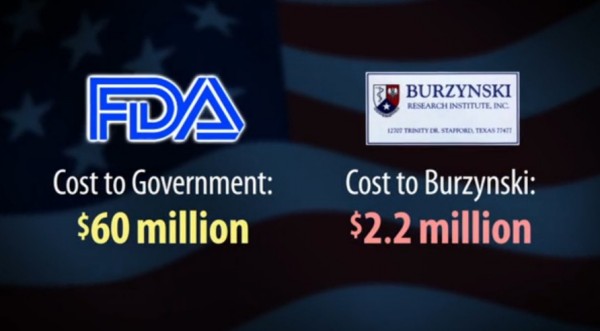
In 1996, the US Government spent $60
Million Dollars in a wasted attempt to convict cancer
researcher Stanislaw Burzynski on a crime. And what
was that crime? Burzynski had allowed his cancer
patients to take his cancer treatment home with them.
The government said this action violated Federal law.
(source)
|
| |
Sicko
|
Michael Moore's Documentary
on America's Health Care System
Rick Archer's
Note: We all know
something is wrong with America's Medical System. How
can a nation which spends as much money as the USA rank 46th
in the world for health care efficiency?
How can
America, the wealthiest nation in the world, a country which
spends more money per person than any other country, rank 51st in the world for
life expectancy? (CIA
data) Gee, if we want to live longer, does
this mean we should move to a poor country? Or
maybe we should just go to Canada. If we did, we would
probably live three more years. By the way, Canada
ranks 13th in the world.
It would be one thing
to pay top dollar if we received a superior medical system in
return.
But in America's case, well...
we don't get much in return. Something is
very wrong.
|
I honestly don't
feel like I have to twist the reader's arm to convince you
that our system is broken. Every single one of us has
some sort of bitter experience dealing with the American
medical system. The bitterness we all feel towards the
tactics of the health insurance companies is profound.
The exorbitant charges of the doctors and hospitals just
make our bitterness even worse.
For this section
of my article, I am going to turn to Michael Moore and his
documentary Sicko. I understand that many
people cannot stand Michael Moore. Be that as it may, when Moore speaks about our health care problem, the man makes sense.
I found several of Moore's arguments about what is wrong with
our medical system to be quite compelling. For your
own good, you should
at least hear what the man had to say.
Michael Moore
began his documentary with stories of people who did not
have health insurance to cover their injuries and illnesses.
Every one of these people were left devastated by the
astronomical medical cost they were faced with.
The case study
which caught my eye involved an Oregon man named Rick... not
me, of course, but another Rick... a Rick who somehow managed
to slice off the tops of two fingers while he used a power saw.
Rick
did not have
health coverage. So
the hospital gave him a choice.
1. Reattach the middle finger for
$60,000.
2. Do
the ring finger for $12,000.
Rick chose to reattach the ring
finger for the bargain price of 12
grand. He threw the middle finger
tip in
the dumpster.
There are 50 million Americans
with no health insurance.
Every day
they awake and
pray
they don't get sick.
Or they pray that don't have an accident like Rick from Oregon did.
Later in the
Sicko documentary, Michael Moore caught up with Brad, a
young Canadian who lives in London, Ontario.
Brad cut all
five fingers off in a power saw accident very similar to
Rick's. Brad explained that as the blade went through,
it caught the glove he was wearing and pulled his entire
hand over the blade which promptly sliced through the entire
group
of 5 fingers, completely severing every one of them from his
hand.
So now Moore went to interview the Canadian doctor who
performed the reattachment operation of all 5 fingers.
(Surgeon):
If you're looking at five fingers, you're looking at a
24-hour operation.
There actually were four surgeons, three plus myself, as
well as all the nurses.
We had two different anesthetists to carry out an
operation of that magnitude.
When Brad came in, we didn't have to worry about whether
he could afford it.
He needed help and we could concentrate on the best way
to bring him through it.
(Moore): Doctor, I
met this American named Rick. He had cut off the ends of two of his
fingers with a saw.
So when he arrived at the
hospital, they told him one finger's gonna cost $60,000,
and the other one was gonna be $12,000.
He had to choose which finger he could afford.
(Surgeon) We've never told someone that they
couldn't put a finger back on because the system
wouldn't allow it.
I'm very glad I work within a system that allows me the
freedom to look after people and not have to make
difficult choices like that.
|


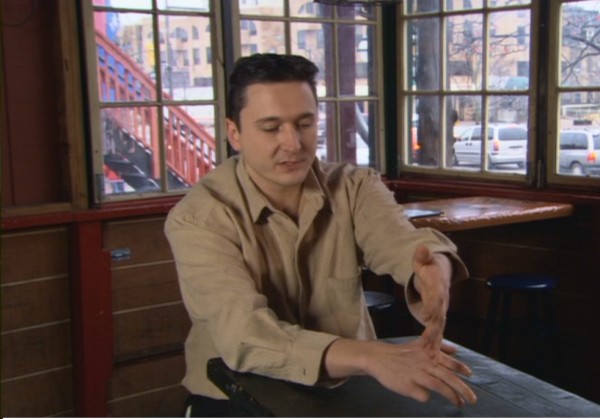
 |

The
Canadian Health System
To see what
Canadians thought of their health system, Michael Moore
drove over to a clinic. He interviewed several
different people in the waiting room. Here is the
transcript:
|
(Moore)
After meeting the doctor who reattached Brad's fingers,
it seemed nothing I had been told back in America about
the Canadian system was true.
Maybe I was just in
the wrong part of town. So I went across the city
to visit a crowded hospital waiting room. Except that it
wasn't very crowded.
There were
maybe 20 people in the room and most were more than
willing to speak to me on camera.
(Moore)
How long did you have to wait here to get help?
Patient 1 - 20 minutes.
Patient
2 - 45 minutes.
Patient 3
- I got helped right away.
Patient 4 - They really do an
amazing job.
(Moore) Did you
have to get permission to come to this hospital?
- No.
- No. We just drop in.
- We can go anywhere
we want.
(Moore) You don't have
to get the visit preapproved by your insurance company?
- Oh, heavens, no.
(Moore)
Can you choose your doctor?
- Oh, yes.
(Moore) What's
your deductible?
Patient 1 - Nothing.
Patient 2 - I don't
think we have any.
Patient 3 - I don't know.
Patient 4 - I don't think
there is any, as far as I know.
(Moore) So what
did this visit today cost?
Patient 1 - Nothing.
Patient 2 - We know
in America people pay for their healthcare, but I guess
we don't understand that because we don't have to deal
with that. And we're dealing with Parkinson's,
stroke, heart attack. We're very, very lucky. Really we
are.
I mean, we complain. People complain
about everything, right?
(Moore) Right, you're Canadian. That's goes
without saying.
-
But on the whole, it's a fabulous system for making sure
that the least of us and the best of us are taken care
of.
|
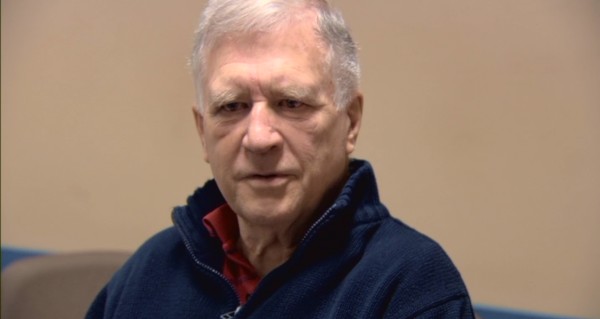

 |
| Australia |
81.4 |
4.2 |
2.8 |
9.7 |
3,137 |
8.7 |
17.7 |
67.7 |
| Canada |
81.3 |
4.5 |
2.2 |
9.0 |
3,895 |
10.1 |
16.7 |
69.8 |
| France |
81.0 |
4.0 |
3.4 |
7.7 |
3,601 |
11.0 |
14.2 |
79.0 |
| Germany |
79.8 |
3.8 |
3.5 |
9.9 |
3,588 |
10.4 |
17.6 |
76.9 |
| Japan |
82.6 |
2.6 |
2.1 |
9.4 |
2,581 |
8.1 |
16.8 |
81.3 |
| Sweden |
81.0 |
2.5 |
3.6 |
10.8 |
3,323 |
9.1 |
13.6 |
81.7 |
| UK |
81.0 |
4.8 |
2.5 |
10.0 |
2,992 |
8.4 |
15.8 |
81.7 |
| USA |
78.1 |
6.9 |
2.4 |
10.6 |
7,290 |
16.0 |
18.5 |
45.4 |
|
As one can see, this chart
from Year 2000 suggests that Canada's system is more
effective than our own.
The
"per capita expenditure on health" differential is the most
telling. The chart suggests that the USA spends nearly
twice as much money per person as Canada. 3,895
to 7,290 is quite a disparity.
Health care in Canada is delivered through a publicly funded
health care system, which is mostly free at the point of use
and has most services provided by private entities. It is
guided by the provisions of the Canada Health Act of 1984.
So
why is health care less expensive in Canada? The
Wikipedia article makes several suggestions.
Canada's provincially based Medicare systems are
cost-effective partly because of their administrative
simplicity. In each province each doctor handles the
insurance claim against the provincial insurer. There is no
need for the person who accesses health care to be involved
in billing and reclaim. Private health expenditure accounts
for 30% of health care financing.
Competitive
practices such as advertising are kept to a minimum, thus
maximizing the percentage of revenues that go directly
towards care.
In general,
costs are paid through funding from income taxes. In British
Columbia, taxation-based funding is supplemented by a fixed
monthly premium which is waived or reduced for those on low
incomes.
There are no
deductibles on basic health care and co-pays are extremely
low or non-existent (supplemental insurance such as Fair
Pharmacare may have deductibles, depending on income).
Family
physicians are chosen by individuals. If a patient wishes to
see a specialist or is counseled to see a specialist, a
referral can be made by a GP. Preventive care and early
detection are considered important and yearly checkups are
encouraged.
2012 saw a record year for number of doctors with 75,142.
The gross average salary was $328,000.
Canadians strongly support the health system's public rather
than for-profit private basis. A 2009 poll by Nanos
Research found 86.2% of Canadians surveyed supported or
strongly supported "public solutions to make our public
health care stronger."
A
Strategic Counsel survey found 91% of Canadians prefer their
healthcare system instead of a U.S. style system.
70%
of Canadians rated their system as working either "well" or
"very well". (Wikipedia)
 |
Rick Archer's Note: In the
interest of fairness, I ran across an
article by John Stossel of Fox News that
strongly contradicts Michael Moore's rosy picture of
Canadian health care.
I suppose it all comes to
down to which source you choose to believe.
For example, the CIA says you will
live 3 years longer if you live in Canada. But who
would ever believe anything the CIA says? (CIA
data)
|
|
| |
Another Example of America's Broken Health Care System
After
surgery, $117,000 bill from doctor he never saw
By Elisabeth Rosenthal, NEW YORK TIMES
September 20, 2014
Surgical consultants have become the source of hefty
fees via what some in the industry call drive-by
doctoring.
When Peter Drier, 37, agreed to surgery in December, he
was not in a good position to bargain or shop around.
Several weeks earlier, he had woken up to excruciating
pain in his upper back. A scan showed that one of the
disks that normally serve as cushions between vertebrae
was herniated and pushing on a nerve. He was living on
painkillers.
Before
his three-hour neck surgery for herniated disks in
December, Drier signed a pile of consent forms.
A bank technology
manager who had researched his insurance coverage, Drier
was prepared when the bills started arriving: $56,000
from Lenox Hill Hospital in Manhattan, $4,300 from the
anesthesiologist and even $133,000 from his orthopedist,
who he knew would accept a fraction of that fee.
He was blindsided, though, by a bill of about $117,000
from an "assistant surgeon," a neurosurgeon based in
Queens, N.Y., whom Drier had never met.
"I thought I understood the risks," Drier, who lives in
New York City, said later. "But this was just so wrong -
I had no choice and no negotiating power."
Drive-by doctoring
In operating rooms and on hospital wards across the
country, physicians and other health providers typically
help one another in patient care.
But in an increasingly common practice that some medical
experts call drive-by doctoring, assistants, consultants
and other hospital employees are charging patients or
their insurers hefty fees. They may be called in when
the need for them is questionable. And patients usually
do not realize they have been involved or are charging
until the bill arrives.
The practice increases revenue for physicians and other
health care workers at a time when insurers are cutting
down reimbursement for many services. The surprise
charges can be especially significant because, as in
Drier's case, they may involve out-of-network providers
who bill 20 to 40 times the usual local rates and often
collect the full amount, or a substantial portion.
"The notion is you can make end runs around price
controls by increasing the number of things you do and
bill for," said Dr. Darshak Sanghavi, a health policy
expert at the Brookings Institution until recently. This
contributes to the nation's $2.8 trillion in annual
health costs.
Insurers, saying the surprise charges have proliferated,
have filed lawsuits challenging them. Multiple state
health insurance commissioners have tried to limit
patients' liability, but lobbying by the health care
industry sometimes stymies their efforts.
"This has gotten really bad, and it's wrong," said James
Donelon, the Republican insurance commissioner of
Louisiana. "But when you try to address it as a
policymaker, you run into a hornet's nest of financial
interests."
In Drier's case, the primary surgeon, Dr. Nathaniel
Tindel, had said he would accept a negotiated fee
determined through Drier's insurance company, which
ended up being about $6,200. (Drier had to pay $3,000 of
that to meet his deductible.)
But the assistant, Dr. Harrison Mu, was out of network
and sent the $117,000 bill. Insurance experts say
surgeons and assistants sometimes share proceeds from
operations, but Tindel's office says he and Mu do not.
Mu's office did not respond to requests for comment.
The phenomenon can take many forms. In some instances, a
patient may be lying on a gurney in the emergency room
or in a hospital bed, unaware that all of the people in
white coats or scrubs who turn up at the bedside will
charge for their services.
Can't fight back
At times, a fully trained physician is called in when a
resident or a nurse, who would not charge, would have
sufficed. Services that were once included in the daily
hospital rate are now often provided by contractors, and
even many emergency rooms are staffed by out-of-network
physicians who bill separately.
When insurers intervene in a particular case, they say
they have limited ability to fight back. Insurance
examiners "are not in the room on the day of surgery to
see the second surgeon walk into the room or why they
were needed," said Clare Krusing, a spokeswoman for
America's Health Insurance Plans, an industry group. And
current laws do not require hospitals that join an
insurance network to provide in-network doctors, labs or
X-rays, for example.
When Drier complained to his insurer, the company cut a
check to Mu for $116,862, the full amount.
So sometimes insurers just pay - to protect their
customers, they say - which encourages the practice.
(Source)
Two
Letters to the Editor regarding the Peter Drier
Story
Broken system
Regarding "'Drive-by' doctors add shock to bills"
(Page A4, Sunday), for many of us, our medical
system seems like legalized theft. Granted, we have
the best care in the world; however, there seems to
be a lack of ethics in the quest for money.
As your article showed, doctors apparently think
nothing of dropping in on surgery and then charging
$39,000 per hour to "assist."
In this
Peter Drier example, the actual doctor
performing the three-hour surgery agreed to operate
for $6,200 total, while the "drive-by" doctor made
$117,000 for dropping in and assisting, with the
patient having no prior knowledge, or consenting to
this.
This is similar to asking your insurance company
what a procedure will cost at a doctor's office and
being told either $40 or $1,800 depending on how
it's coded. Or getting a bill from a doctor's office
for $1,700 after having the receptionist tell you
"don't worry it's just a $40 co-pay." Or having the
ambulance service call and say you owed $1,000 for a
trip to the hospital and then you tell them you paid
$600 months ago and they say thanks and hang up.
These are just some of the experiences my family has
had. This medical system is broken, the bureaucracy
makes it impossible to get a straight, honest
answer, and the costs are outrageous.
It would be nice if some of these doctors and
insurance companies were called on the carpet for
some of these types of behaviors.
Mike
Donnelly, Pearland, Texas
Punish predators
The story of hospitals, doctors and other health
care providers sneaking outrageous overcharges into
bills for medical procedures and services is
certainly not a new one.
The natural outcome of this practice would be the
blatant disregard for simple humanity demonstrated
by the "assistant surgeon" told of in the story, a
predator who literally snuck in the back door -
unbidden, unwanted and unneeded - to add $117,000 to
the patient's bill. To say that this practice is
fraudulent is an understatement, which raises the
question: Why are the people who do things like this
not in jail?
Pete Smith, Houston,
Texas
Rick Archer Note: As one can gather, the
insurance company passes on the additional cost to the
consumer who now pays increasingly higher healthcare
premiums. We speak of how "capitalism" drives down
costs through increasted efficiency, but in the world of
healthcare there seem to be no market forces in operation.
And why is that? The answer of course is the
Twisted Golden Rule. Not only do the doctors, the
lawyers, and the health insurance companies all have the
politicians in their pocket, there doesn't seem to be much
you or I can do about it.
You don't believe me? Well, read on and see what you
think.
|
| |
Socialism versus Capitalism
I understand
very clearly that the word "socialism" has deeply negative
connotations here in America.
That said, based
on Michael Moore's documentary, I came to the conclusion
that the
"socialist" Canadian health system is far superior to the
American health system. For that matter, based on what
was shown in the documentary, I concluded that the "socialist"
English health system and the "socialist" French health
system are also superior to the American system.
I am no "enemy"
of the capitalist system. I understand that the
capitalist model of seeking excellence through competition
has its virtues. I also understand the value of an
incentive. Any man will work harder if he expects a
reward for his hard work and the right to keep the fruit of
his efforts.
I myself have
been well rewarded for pursuing the capitalist dream.
Many years ago, I had an original idea that a dance studio
could emphasize group dance lessons over the traditional
"private lesson" model that was the established business
practice at the time.
I parlayed this
idea into creating the largest social dance studio in the
country. As a successful businessman, I paid salaries,
I paid rent, I paid taxes, I paid insurance, I paid health
care, and I worked damn hard every step of the way for
thirty years.
I think this
experience qualifies me as a card-carrying member of the
American business community.
When it
comes to taxes, I am no different than anyone else - I hate
taxes. Like everyone else, I do not enjoy seeing taxes take a huge cut out
of my earnings. Today I pay $20,000 a year in property
taxes alone. I continue to work well past retirement age
simply in order to pay those property taxes. And do you think I
am alone? Many other Americans continue to work well past
retirement age for the exact same reason.
So I understand
why everyone fears any "socialist" medical system that would
take an even larger cut out of our earnings.
But what
if a "socialist" medical system turned out to be
more cost-effective? Let's look at that
chart again.
Unless
that chart is lying to us ... look for yourself in
Wikipedia... American citizens pay far more
than the evil "socialist" systems and get far less
in return!
Think
about it. The American health care system is
the laughingstock of the entire world. How can
anyone look at that chart and not wonder if there is
a possibility that the American people have been
fooled on this issue??
|
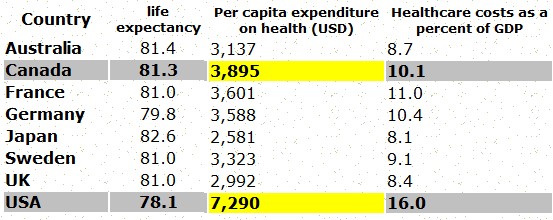 |
Furthermore, I want the
reader to understand something else. Everyone screams about
the evils of Obamacare, but most people don't realize
they are already paying a hidden health care tax.
As the number of
Americans without health insurance continues to rise, so too
do the costs borne by those who have coverage. The
people with insurance face what might be called a "hidden
health tax." Private health insurance premiums are higher,
at least in part, because uninsured people who receive
health care often cannot afford to pay the full amount
themselves. The costs of this uncompensated care are shifted
to those who have insurance, ultimately resulting in higher
insurance premiums for businesses and families.
When the uninsured do obtain care, they struggle to pay as
much as they can afford. Often, however, the uninsured
cannot afford to pay the entire bill, and a portion of it
goes uncompensated. To make up for these uncompensated care
costs, doctors and hospitals charge insurers more for the
services provided to patients who do have health coverage.
In turn, the costs that are shifted to insurers are passed
on in the form of higher premiums to consumers and
businesses that purchase health coverage. (source)
This cost shift to health insurance premiums is a "hidden
health tax." In other words, if you are insured, you
are already funding the poor. Why not just shift to a
universal health care system and level the entire playing
field just like every other civilized country in the world?
They say if it
ain't broke, don't fix it. Well, my dear readers, our
American health care system is broken.
It isn't just
broken, it is broken badly. We have to do something.
I happen to
think the "socialist" Canadian health system, English health
system, and French health system are all superior to the
American health system. And those systems aren't just
"a little bit
better"... I say those health systems are vastly superior.
|
Take a quick
look at that chart. That chart is not Michael Moore
propaganda. That chart is from
Wikipedia, heretofore a staunch defender of the
American Medical Association.
The chart shows
quite clearly that something badly went wrong with our
health system starting around 1978. The chart also
shows that things really began to spiral even more out of
control in 2004. Although the chart ends at
2007, we all know that things have only gotten worse since
then.
It is beyond
pathetic for American citizens to pay the most money of any
society in the world and yet have our system ranked among
the most mediocre.
How could things have gotten this
bad?
I am hardly an
expert, but I have my suspicions. For starters, I
happen to think that "Capitalism" is the wrong approach to
health care.
And now I will
make my case.
|
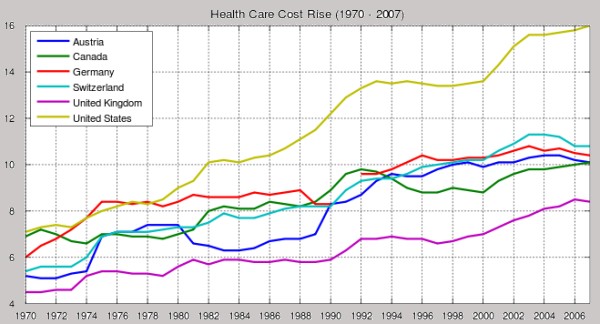
As one
can readily see, health costs in the USA are rising much
faster than in other countries.
Wikipedia
|
|
The
Role of Government
Whether is it
the central government or the local government, I think we
can all agree there are certain areas that belong
in the hands of centralized authority.
High on the list
is National Defense. On the local level we have
the police and the fire department. Then we have
education, but local and national. Then there are roads and infrastructure
that must be built and maintained.
Let's not forget
about Social Security. Or Medicare. Or the other
social safety net programs like unemployment benefits, welfare
payments, and food stamps.
And let us not
forget about NASA. For defense reasons and the
advancement of mankind, this program is a vital part of our
NATIONAL identity. NASA is an integral part of being
American.
Each citizen
helps to pay for these things through tax dollars.
Now I understand
that the government spends too much. Yes, I get that.
No argument from me. And like any household that
overspends, arguments must be raised as to where to cut back
or how to find more money. I completely agree that
government spending is out of control. But this is an
issue for a different article; let's stick to healthcare for
now.
My point is
simply this: we all seem to agree that at least some
"collective" things are better left to the government.
And I think
healthcare is one of them...
Why? Because
when a medical plan attempts to make "profit" off "health
care", the customer generally gets short-changed.
You and I are
the customer. We are being short-changed.
|

 |
| |
|
Profit Over People -
Patient Dumping
Note: "Patient
dumping" is the transfer of a patient from one hospital
(typically a private hospital) to a public hospital because
of the patient's lack of insurance or inability to pay. The
uninsured are the most vulnerable to patient dumping. This
deplorable practice is one of the truly disgusting
features of our "capitalism-based" medical system.
|
Video Catches Hospital 'Dumping' Incident
by Ina Jaffe,
NPR
2006 - For many months, Los
Angeles city officials have complained that regional
hospitals are dropping off their indigent patients in the
city's tough Skid Row area. On Wednesday, officials at a
homeless shelter released a videotape that allegedly catches
one hospital in the act. The incident has become part of an
ongoing investigation that could result in criminal or civil
penalties.
Security cameras outside the Union Rescue Mission, the
city's largest homeless shelter, show a taxi pulling a
U-turn in front of the building. Several seconds later, an
elderly woman in a hospital gown shuffles into view. She
appears to have only hospital socks on her feet, and walks
in the street for a while before turning back to the mission
entrance.
Mission worker Regina Chambers met the woman outside, later
identified as Carol Reyes, a homeless resident of the city
of Gardena, a dozen miles south of downtown Los Angeles.
"When I first approached her, she was very disoriented,
didn't know where she was or what she was doing," Chambers
says. "All she knew is that she had been to a hospital."
It was later determined that Reyes was released from
Kaiser Permanente hospital, a
privately-owned facility in the city of Bellflower, 16
miles southeast of the mission.
Los Angeles goes
after Vegas hospital for dumping 1500 patients
USA Today
May 20, 2013 18:43
The city of Los Angeles is pursuing a criminal investigation
of a psychiatric hospital in Las Vegas, which has allegedly
put 1,500 patients on buses and sent them out of state over
the past five years.
About one third of these patients, some of which were
homeless, were given one-way bus tickets to cities in
California. About 200 of the 1,500 mentally ill patients
were sent to Los Angeles County, 150 of whom arrived in
downtown L.A. Since 2008, patients were bused to cities in
every continental US state, even though some had no family,
friends or housing at their destination. After the
Sacramento Bee published an exposé on the dumping practices
of the Rawson-Neal Psychiatric Hospital, the city of
Los Angeles announced it would launch a probe investigating
the matter.
“It’s just an abhorrent practice,” Gil Cedhillo, a candidate
for the L.A. City Council and a former state senator, told
the Bee. “You can’t just take someone from a facility and
dump them downtown.”
L.A. has one of the strictest patient-dumping laws in the
US, which was adopted in 2007 after a homeless schizophrenic
was found walking the streets in his hospital gown while
still connected to a catheter bag.
The Bee obtained bus receipts from the Nevada Division of
Mental Health and Developmental Services and found that the
hospital sent its patients away on Greyhound buses, equipped
with a small supply of medication and several bottles of a
nutritional supplement that only lasted a few days.
Health officials claim that most of the patients were sent
off to cities where they had a place to stay, but the Bee
discovered several cases in which mentally ill patients were
forced to go to cities that they had no connection to.
One example would be James Flavy Coy Brown, a
48-year-old homeless man who had received treatment at
Rawson-Neal.
Brown
was put on a bus that dropped him off in Sacramento – even
though he had never been there and knew no one in the city.
The former psychosis patient had only been treated
for three days before doctors sent him out of state, despite
his protests.
Equipped with a $306 one-way bus ticket, six Ensure
nutrition shake bottles, and a three-day supply of
psychiatric medications, he was sent away, only to end up on
the streets of Sacramento – without medication.
The man had no Social Security
card, food stamp card or Medicaid card, and checked into a
homeless shelter, feeling the effects of medication
withdrawal and the return of his psychosis.
“If I don’t take my medicine, I get really confused and I
start hearing voices in my head, and they tell me to, like,
jump off a bridge. When things get
too bad, I break something or to do something to
purposefully get arrested or go to prison or jail,”
Brown said.
|

Taxi pulls
up, but then moves off camera

A
homeless woman appears out of nowhere and begins wandering
around.

Mission worker Regina Chambers meets
the woman outside and learns what the
situation is.
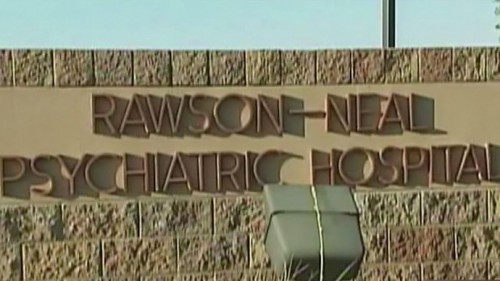
Rawson-Neal Psychiatric Hospital
is located in Las Vegas, Nevada.
It is publicly funded by the State of Nevada.
|
| |
|
Hollywood Presbyterian Medical Center
In February 2007, an investigation was launched
after a hospital official allegedly "dumped" 54-year-old
Gabino Olvera, a paraplegic patient, on a Skid Row street.
According to witnesses, Olvera was removed from a hospital
van and left writhing in a gutter, wearing nothing more than
a soiled gown and a broken colostomy bag.
The
man was terribly disoriented and
was trying to propel himself along
with his hands.
He was carrying a plastic bag of his belongings in
his teeth and trailing a broken colostomy bag.
The man was still wearing his
wristband from the Hollywood Presbyterian Medical Center,
matching the name on the
van that dumped him.
The hospital,
which is privately owned, agreed to pay $1 million and be
monitored for up to 5 years as part of a settlement
agreement reached in 2008.
[source]
Rick Archer's
Note: These deeply depressing stories of Patient Dumping
are part of my evidence
that our American medical system is totally and completely
broken.
Incidentally, there is no "patient dumping" in
Canada. This is a strictly AMERICAN
phenomenon.
It must be so
darned un-economic for a hospital to actually be expected to
treat someone who is sick and has no money. And the
funny thing is, some of them have NON-PROFIT STATUS.
Here you have a gigantic American
hospital corporation just trying to make a decent few
billion bucks or so in "non-profits",
and these
riffraff insist on showing up in its
emergency rooms all dirty, screaming
in distress and, worst of all,
penniless.
What's a forward-thinking megacorporation to do?
Why, dump 'em, of course.
After all, it's the American Way!!
|
 |
|
| |
|
Profit Over People -
Non-Profit Hospitals
The University of Pittsburgh
Medical Center (UPMC) -- named one
of the ten best hospitals in the nation by U.S. News
-- cares for the sick and saves lives.
As a nonprofit organization, it also receives a tax
break. But in recent months there have been questions
raised as to whether the hospital acts more like a
corporation, reaping big profits and driving up health
care costs.
According to an audited financial statement, UPMC made $948
million in profits from 2011-2012. And while tax returns
show it spends just two percent of its yearly budget on
charity care, the hospital receives a state and federal tax
break of about $200 million, according to city estimates.
Pittsburgh Mayor Luke Ravenstahl is
suing to revoke its nonprofit status. His city stands to
gain $20 million a year.
"I think they're going to be hard pressed to prove how
they're operating the same way as the Little Sisters of the
Poor or the Catholic Church, true genuine nonprofits. UPMC?
I'm afraid not," Ravenstahl told "CBS This Morning."
The mayor said he was also surprised to learn that UPMC's
CEO, Jeffrey Romoff, makes almost $6 million a year. That
makes him the highest paid CEO of any large nonprofit
hospital in the U.S., according to a recent analysis by
TIME. Romoff also has more than a dozen administrators
that take in annual salaries of over $1 million, and
according to the city, he has access to a private chef,
chauffeur, and a jet, as well as one of the most expensive
office spaces in Pittsburgh.
Professor Martin Gaynor of Carnegie Mellon has published
papers on hospitals that enjoy nonprofit status but do
not always function like charities.
"There's a lot of concern here in the community," Gaynor
told "CBS This Morning."
"They've taken some actions that don't appear to be
consistent with an organization whose mission is to benefit
the community."
Some of UPMC's funds are directed at facility improvement,
but Gaynor has concerns about even some of that spending. He
likened the new, state-of-the-art pediatric center to a
palace.
"It's a tremendous asset to the community," he said. "On the
other hand...one has to ask whether it was so important to
make it so beautiful, or whether some of those dollars
could've been used to better purpose -- to offer lower
prices to members of the community, to offer more charity
care."
While nonprofits are required to serve the community,
UPMC has closed hospitals in poorer neighborhoods and
opened them in more affluent ones, claiming the hospitals
they closed were underutilized.
Some of the concerns in Pittsburgh have been echoed across
the country. America's hospitals have been growing. The
bigger they get, the more power they have -- to set prices
and force insurers to pay more. Patients foot the bill via
higher premiums, copays, and deductibles.
This is
one factor behind the nation's increasing health care costs.
[source]
|
| |
|
| |
|
Profit Over People -
Deny Deny Deny!!!
|
John Grisham's 'The
Rainmaker'
The
Rainmaker is a work of fiction. The plot of The
Rainmaker
revolves around a pitiful young man with leukemia whose
insurance company has denied him a bone marrow transplant.
The young man has a willing donor and a doctor's statement
that this is his only chance to survive, but that doesn't
matter.
Treatment denied. The insurance company has flatly
refused to pay for his medical treatments.
An
idealistic young lawyer named Rudy comes across the leukemia
case and meets the patient's grief-stricken mother.
Seeing the callous way that her son's claim has been treated
by an insurance company, Rudy winds up taking on her case as a
matter of principle.
Only one problem - this young, inexperienced lawyer suddenly
realizes he is taking on a powerful law firm representing
the corrupt insurance company. Rudy gulps in terror
when he sees an array of one dozen highly-trained, well-paid
lawyers facing him with one single purpose - they want to
crush him.
Rudy is terrified. Rudy
knows he is in way over his
head, plunged into a nightmare of lies and legal
maneuverings. He is about to go head-to-head with some of
the best defense attorneys -- and powerful industries -- in
America. This story turns into a David versus Goliath
case that involves a frightening war of nerve and the legal
skill of a rookie against this heavyweight team of lawyers.
|
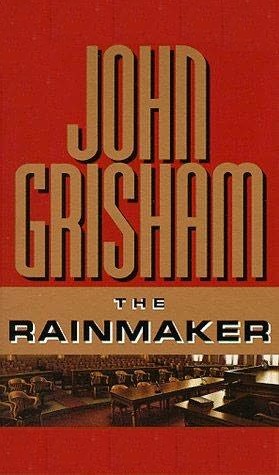 |
Rick Archer's Note: Grisham's suspenseful novel of legal intrigue and corporate
greed is riveting for one simple reason - the story is
totally believable. Insurance companies play the same
game as Perry Homes in my earlier "He who owns the gold
makes the rules". Some companies refuse to pay on a
claim and then hide behind a team of lawyers. Raise
your hands if you have heard that story before.
This story is compelling because many of us feel like the
little guy. How many of us have the guts to face teams of
lawyers hell-bent on finding some pathetic legal loophole
that will serve as a way to escape payment? How many
of us have the money and the patience to fight? Most
of us just give up. You can't fight them. They
are too big and have deep pockets. They are sure to
outlast us.
|
| |
|
Profit Over People:
We are Talking About
People's Lives!!
The
Rainmaker was a work of fiction, but this next story is
the real thing. In the Sicko documentary, four
women were profiled with a similar horror - they were denied
treatment.
Each woman had health insurance.
Each woman was sick.
And all four women were denied treatment by their health
insurance companies.
Here is the
transcript of what these women said:
(Michael
Moore) A quarter billion Americans are still able to
get health insurance.
Let's meet some of these happy insured customers.
- Diane
has Horizon BlueCross.
- Maria
has BlueShield.
- BCS
insures Laurel.
-
Carolyn has CIGNA.
And it's a
good thing that these women are all fully covered because they
all got sick.
- Diane:
Brain tumor on the right temporal lobe.
- Maria: Brain tumor.
- Laurel: I ended up being diagnosed with retroperitoneal
cancer.
- Carolyn: Breast cancer.
(Moore) Fortunately, as they were insured, they
got the red-carpet treatment at the doctor's office.
- Diane: The way they would treat it was to remove the
tumor.
- Maria: My doctor requested for me to see a
neurologist.
- Laurel: Surgery was scheduled for December 9.
- Carolyn: There is a test that you can take that will
show whether or not you would benefit from chemo.
(Moore) They got their treatment all right. But
not before battling their insurance companies.
- Diane: "We don't consider that life-threatening."
- Maria: "It's not medically necessary"... [to receive an
MRI].
- Laurel: They investigated whether or not this was a
preexisting condition.
- Carolyn: "They claim that it's experimental."
(Michael Moore
voiceover)
Diane died from her non life-threatening
tumor.
Laurel's cancer is now spread throughout her body.
Carolyn's "experimental test" proved that she needed
chemo.
As for Maria, while vacationing in Japan, Maria became
ill. In Japan, Maria got the same MRI that
BlueShield of California had refused to approve.
The doctors in Japan told Maria she had a brain tumor.
That's odd because BlueShield had said repeatedly Maria
didn't have a tumor.
That's when Maria said: "Well, I'm pretty sure I have a
lawyer."
Rick Archer's Note: The reason these stories are
important is that these four women represent what we all
fear. Their stories could just as easily be our
stories. It is the stories of people like these four
women that explain why all of us live in constant fear of
abuse by a health insurance plan.
- Raise your
hand if you worry whether they will cover you for
whatever condition you have.
- Raise your
hand if you worry they will dig up some medical
technicality to deny you coverage.
- Raise your
hand if you worry your insurance plan will drop you like
a hot potato if you get sick.
- Raise your
hand if your insurance premiums have absolutely
sky-rocketed in the recent past.
You can be angry
at me all you want for suggesting a "socialist" health care
system, but don't forget: We are all in
this same boat together. Any one of these stories
could be you next.
|

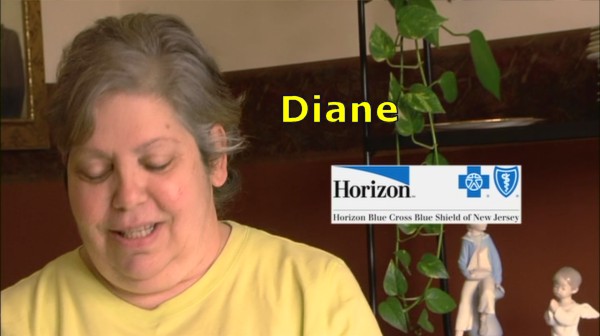


 |
| |
|
Maria Watanabe versus
Blue Shield of California
|
March 13, 2003. Partial Transcript:
Lawyer: I'm
going to direct your attention to exhibit one.
Please describe for me what it is.
Witness: It is a denial for referral to an
ophthalmologist.
Lawyer: Is it your signature on this?
Witness: Yes.
Lawyer: I'd like to direct your attention to exhibit
two.
Witness: This is a denial of a request for referral for
a magnetic resonance imaging test of the brain.
Lawyer: It has your signature?
Witness: Yes.
Lawyer: Directing your attention to exhibit three.
Please read this document.
Witness: This is a denial of a referral
to a neurosurgeon.
Note: The
letter in part stated this test could not be approved
because it was not a covered benefit.
Lawyer:
Can
you explain for me how you came to sign the denial
letter?
Witness: This is a standard signature put on all
denial letters. (deny deny deny)
Lawyer: Is it your signature or is it a stamp?
Witness: That is a stamp.
Lawyer: Did you ever see this denial letter before your
signature was stamped on it?
Witness: No, but the denial letters are fundamentally
the same. The denial letters that are sent out...
Lawyer: The answer is no, correct?
Witness: Okay, all right. No.
VERDICT:
A jury found that Blue Shield of California breached its
contract with Maria. She was not completely satisfied with
the verdict, however -- which her attorneys say was due to
an error by the presiding judge -- and Maria is appealing.
Maria Watanabe
vs. Blue Shield of California
State: California
Year: 2008
Court: California Court of Appeal, 2nd District, Division 8
Issue: California law is clear: an insurer cannot delegate
its implied covenant duties.
Blue Shield of California tried to shield itself from bad
faith liability by claiming that Maria W’s benefits were
denied by a medical group which had a contract with Blue
Shield. But California law is clear: an insurer cannot
delegate its implied covenant duties. The Know-Keene Act
does not immunize insurance companies from bad faith
liability. To allow an insurer to delegate its implied
covenant obligations would effectively allow insurers to
eliminate its bad faith liability.
Conclusion:
Absent the
threat of bad faith liability, an insurer has little
incentive to afford policy benefits. (source)
Rick Archer's Note: The underlying point here is
chilling indeed. It suggests that without "law", an
insurer has little incentive to afford policy benefits.
What does this
mean precisely? What ever happened to "Business
Ethics"? Have things gotten so bad that we
cannot trust our health insurance companies to do the right thing
because that is what they promised to do??
This situation brings us
to the fundamental problem.
The fewer the medical procedures that are
approved, the greater the profits for the
insurance company.
|
That in a
nutshell explains why "managed care" and "capitalism" are
inherently at odds with humane public heath policy.
Repeat:
Every single medical test that is denied means greater
profits for the HMO or the insurance company.
This
practice absolutely guarantees that the health of some
INSURED
customers will be in peril!
In Maria's case,
this woman is a mother of two small children. Maria is
responsible for their safety and took steps to protect her
health and her life savings by purchasing insurance... only
to see someone willy-nilly deny her claim with a stamp no
less.
In the end,
Maria nearly died in Japan and was forced to seek legal
help.
This brings up
another point. There is an old saying that everyone hates lawyers till you
need one. In a nasty game that contributes directly to
human misery, the insurance companies know that most people
won't have the guts that Maria had to fight back.
For that matter,
at first Maria didn't fight back. Originally
Maria simply accepted the insurance company's decision.
Had she not gotten sick in Japan and received the damning
evidence of the MRI, Maria probably would not have had a
case strong enough to fight back.
Meanwhile
lawyers are hired to defend the customers denied treatment.
And more lawyers are hired to defend the practices of the
insurance company. This suggests when it comes to
denying incredibly expensive medical procedures, some
companies think it is in their best interests to "deny" and
take their chances in court.
If that is indeed true,
what a truly awful game this is. As depressing as
it is to point this out, American capitalism has become so
GREEDY that we now need LAWYERS to keep the companies
honest.
Lawyers are the
big winners here. They don't want anything to change.
Why should they? They love this pathetic system of
health care because it plays right into their hands.
The LAWYERS are getting rich in the process feeding off this
deeply-flawed system of health care.
Another one of the reasons why American medical costs are so
high is the exorbitant insurance that doctors and hospitals
are forced to carry to fight back against the litigious
claims of their own dissatisfied patients.... and they pass
their costs onto you.
In the end, the
lawyers are thrilled. No matter which
side wins and which side loses, the lawyers get paid.
And we all know
who the biggest losers are - you and me.
|
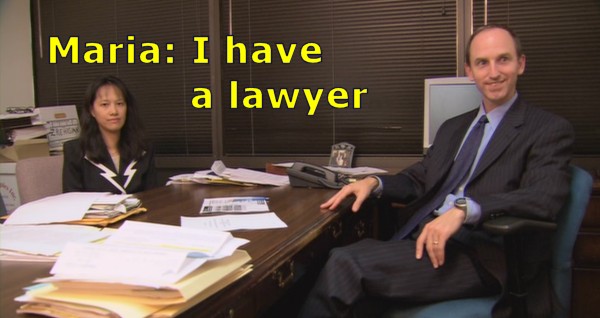
In the end, the
lawyers are thrilled with the Health Insurance "deny"
technique. No matter which
side wins and which side loses, the lawyers get paid.
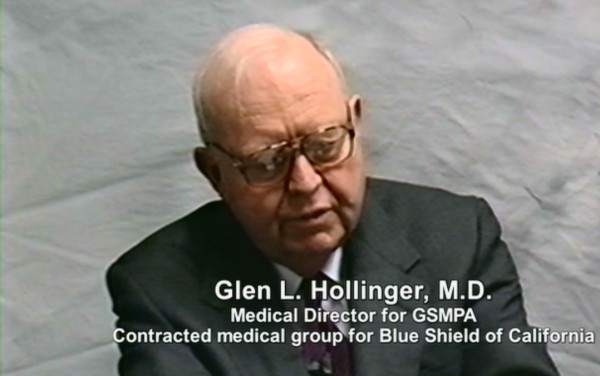
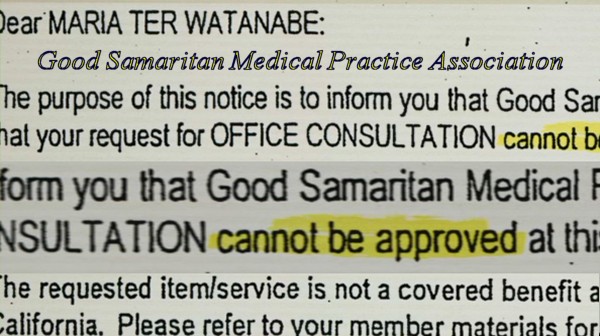
Rick
Archer' Note: The
irony of getting jerked around by the "Good Samaritan"
health plan is
unmistakable.



 |
About Japan's Health Care System
One final point
before we move on. While studying the story of Maria,
I learned that Japan is also considered to have a health system
superior to the USA. No surprise there.
Apparently everyone's health care system is better than
ours. Oops... not true. Apparently Slovenia and
Ghana are still behind the USA. My bad.
The health care
system in Japan provides healthcare services,
including screening examinations, prenatal care and
infectious disease control, with the patient accepting
responsibility for 30% of these costs while the government
pays the remaining 70%.
Payment for
personal medical services is offered through a universal
health care insurance system that provides relative equality
of access, with fees set by a government committee.
People without
insurance through employers can participate in a national
health insurance program administered by local governments.
Patients are free to select physicians or facilities of
their choice and cannot be denied coverage. Hospitals, by
law, must be run as non-profit and be managed by physicians.
For-profit corporations are not allowed to own or operate
hospitals. Clinics must be owned and operated by physicians.
(source)
Ranking Third on Bloomberg's list of health systems,
the Japanese system involves universal health care with
mandatory participation funded by payroll taxes paid by both
employer and employee, or income-based premiums by the
self-employed. Long-term care insurance is also required for
those older than 40.
Japan controls
costs by setting flat rates for everything from medications
to procedures.
This eliminates competition among insurance
providers. While most of the country's hospitals are
privately owned and operated, the government implements
smart regulations to ensure that the system remains
universal and egalitarian. (source).
|
|
|
|
The Twisted
Golden Rule, Example 4
Profits Over People:
Linda Peeno - The Humana
Insider
|
One of the most powerful features of
Michael Moore's Sicko documentary came from Dr. Linda Peeno, a physician
who was a nine-month contractor working as a medical reviewer for Humana
in the 1990s.
Dr. Peeno said she eventually left her
job because she didn't like their way of doing business. Here is her compelling testimony
before the US Congress in 1996.
My name is Linda Peeno.
I am a former medical reviewer at Humana.
I am here today to make a public confession.
In the spring of 1987, as a physician, I denied a man
a necessary operation that would have saved his life,
and thus caused his death.
No person and no group has held me accountable for this, because, in fact,
what I did was to save the company a half a million dollars for this.
And, furthermore, this particular act secured my reputation as a good
medical director, and it insured my continued advancement in the healthcare
field.
I went from making a few hundred dollars a week as a medical reviewer to an
escalating six-figure income
as a physician executive.
In all my work, I had one primary duty, and that was to use my medical
expertise for the financial benefit
of the organization for which I worked.
And I was told repeatedly that I was not denying care, I was simply denying
payment.
I know how managed care maims and kills patients.
So I'm here to tell you about the dirty work of managed care.
And I'm haunted by the thousands of pieces of paper on which I have written
that deadly word - "denied."
Thank you.
Michael Moore's was able to get
Linda Peeno to agree to an interview for his Sicko documentary.
Here is the transcript:
Dr. Peeno:
The definition of a good director was somebody who
saves the company money.
I was told when I started that I had to keep a 10% denial.
Then they were giving us reports weekly that would have all the cases we
reviewed, the percent approved and the percent denied.
This included my own actual percentage denial rate.
Then there would be another report that compared me to all the other
reviewers.
The doctor with the highest percent of denials was going to get a bonus.
Moore: Really? So you, as a doctor,
working for the HMO, if you denied more people healthcare, you got a bonus?
Dr. Peeno: That was how they set it up.
Any payment for a claim is referred to as a medical loss. That's the
terminology the industry uses.
I mean, when you don't spend money on somebody, when you deny their care, or
you make a decision that brings money in and you don't have to spend it,
then it becomes a savings to the company.
|
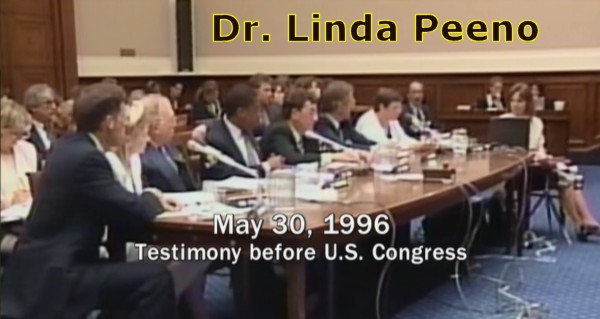


DENY DENY DENY!!!
"The
definition of a good director was somebody who saves
the company money." - Dr. Linda Peeno
"The
doctor with the highest percent of denials was going
to get a bonus." - Dr. Linda Peeno
"Any
payment for a claim is referred to as a medical
loss. That's the terminology the industry uses." -
Dr. Linda Peeno
"When
you don't spend money on somebody, when you deny
their care, or you make a decision that brings money
in and you don't have to spend it, then it becomes a
savings to the company." - Dr. Linda Peeno
|
|
Rick Archer's Note: Besides the Michael Moore
interview, on 21 June 2007 Linda Peeno was also
interviewed by Amy Goodman on Democracy Now.
Peeno recounted that while working at
Humana, the insurer refused to pay for expensive treatments
such as heart transplants for its customers, which led to
their deaths.
Peeno said that
"just within a day or so [of the refusal of the heart
transplant, I saw a sculpture being installed in the
rotunda [of Humana's headquarters]. I was told at that
time that it had cost about the same as the heart transplant
that we had denied...By the way, I later found out that that
sculpture cost $3.8 million, so it was actually equivalent
to eight heart transplants."
Peeno told Amy Goodman that when she went for her interview at
Humana, "I was asked if I could be tough, because I was
going to be telling doctors that they couldn't do things and
that I would be expected to keep a 10% denial rate."
Peeno also said
that while she worked at Humana, "we were told that the
medical reviewer that had the highest denial rate was going
to receive a bonus at Christmas." (source)
Linda Peeno is now
hailed as a whistleblower. Immediately after her
testimony before Congress in 1996, other physicians stood up
as well.
"A Call To
Action" appeared in the December 3, 1997 issue of the
Journal of the American Medical Association. It was
signed by 2,300 Massachusetts physicians.
"The time we
are allowed to spend with the sick shrinks under the
pressure to increase throughput, as though we were
dealing with industrial commodities rather than human
beings…
Doctors and nurses are being prodded by threats
and bribes to abdicate allegiance to patients, and to
shun the sickest, who may be unprofitable. Some of us
risk being fired or 'delisted' for giving or even
discussing expensive services. Many of us are offered
bonuses for minimizing care."
A Stockton,
California, gynecologist named Daniel Fisher made an even
stronger statement. He quit his practice over these
concerns.
In a letter to his 2,651 patients, Dr. Fisher wrote:
"As of
7/1/98 I am quitting the practice of medicine. The
system of HMOs, managed care, restricted hospitals and
denial of needed medications has become so corrupt, so
rotten, that I cannot stomach it any longer." (source)
|
The
Corporate Health of Humana
|
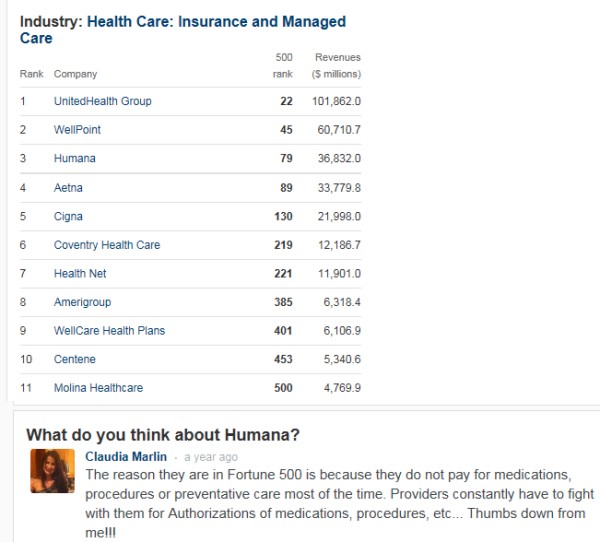 |
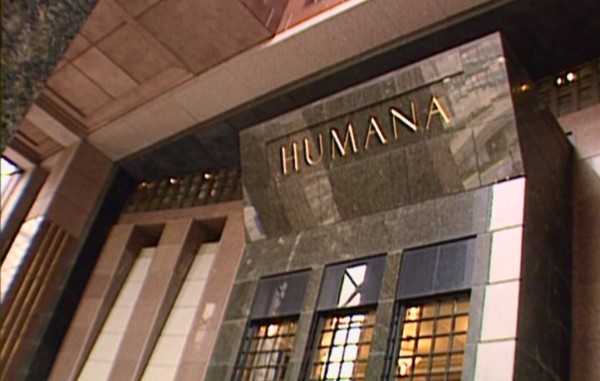
Rick Archer's
Note: Humana was the
company called out by Dr. Linda Peeno in 1996. So how
seriously did Dr. Peeno's whisteblowing hurt the company?
Apparently
Humana survived. In fact, as one can readily see, Humana is
doing quite well. As of 2012, it was the third largest
Health Insurance company in America.
|
| |
Humana: "Guidance When
You Need it Most"
Bulletin: 2013
Humana Second Quarter Profits up 18%
|
 |
|
By Jennifer
Booton
Published July 31, 2013
FOX Business
Driven by
increased premiums and services revenue, Humana revealed a
stronger-than-expected 18% rise in second-quarter profit on
Wednesday and raised its full-year outlook.
The Louisville, Ky.-based health insurer, which focuses on
private Medicare plans, reported net income of $420 million,
or $2.63 a share, compared with a year-earlier profit of
$356 million, or $2.16.
Excluding the 12 cents Humana recorded as special items, the
results topped average analyst estimates of $2.47 a share in
a Thomson Reuters poll.
Revenue for the three months ended June 30 was $9.7 billion,
up 6.4% from $9.2 billion a year ago, narrowly below the
Street’s view of $10.3 billion. Humana recorded a 7.1%
increase in Medicare Advantage membership, while premiums in
the group edged up 5.8%.
In a statement, Humana CEO Bruce Broussard attributed the
performance to “continued focus and executional discipline,”
as well as in key initiatives like its chronic care program.
Humana raised its full-year EPS guidance to a range of $8.65
to $8.75 from an earlier $8.40 to $8.60. The guidance is
mostly above the consensus view of $8.68.
Building on the successes from last quarter and a focus on
axing costs, Broussard said Humana will be well positioned
to face reform-related challenges set to hit in 2014.
The insurer is the fourth major health-services provider to
report earnings this season.
Rivals UnitedHealth,
WellPoint and Aetna all posted favorable profits
as members used fewer services.
|

Rick Archer's Note:
According to Michael Moore's
Sicko,
Humana's profits doubled in 2006. This success has
continued. The Fox Business report shows Humana did
quite well in 2013.
One way to maximize profits is to limit insurance to "The
Healthy".
Thanks
to that policy, close to 50 million Americans are uninsured.
Many of these people are the ones with "pre-existing
conditions".

If I
were running a health insurance company, I would do the same
thing!
The
purpose of a health corporation is to make a profit.
However, this points out the absurdity of expecting
self-serving corporations to SERVE THE PUBLIC GOOD.
These companies won't take care of you... they will take
take care of themselves.
|
|
|
|
| |
|
Profits Over People
Rick Archer's
Note: Oddly enough, the first thing that caught my eye
when I looked at the initial list of health care companies
and revenues on the right was the curious phrase "More
competitors". (source)
This "more
competitors" phrase bothers me for the same exact reason
that I am upset with the entire American medical system.
This phrase
suggests that Humana is more concerned about competing
against other companies than it is with the welfare of its
customers.
|
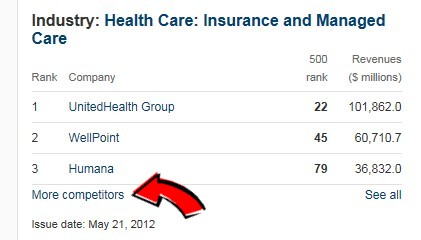 |
I begin to
wonder what steps a company like Humana might take to become
even more profitable. When
it comes to "Competition" in America, one of the first
tactics is to cut costs.
Dr. Linda Peeno
suggested the way our health care companies cut costs is to
deny coverage... coverage that you and I have paid for with
our monthly premiums.
The Fox Business
report above suggested that "Rivals UnitedHealth,
WellPoint and Aetna all posted favorable profits
as members used fewer
services."
Although the Fox
Business report didn't spell it out, one might guess "as
members used fewer services"
is CODE for deny deny deny.
"When you
don't spend money on somebody, when you deny their care,
or you make a decision that brings money in and you
don't have to spend it, then it becomes a savings to the
company." - Dr.
Linda Peeno
|
According to a
2008 article by Peter Dreier in the Huffington
Post, legendary Humana CEO Michael McCallister said this
in 2003:
"It is
important to note if we have to choose between achieving
our membership goals and achieving profitability goals,
profits will win every time."
Peter Dreier,
the writer, didn't particularly warm up to CEO McCallister's statement.
"Indeed,
Humana isn't shy about revealing its profits-over-people
philosophy.
Whoever
picked the name "Humana" for the health insurance giant
had a great sense of humor. The title suggests a
company engaged in humanitarian pursuits, or at least
one with a priority on human beings.
Had the marketing
genius in charge of picking a name for the corporation
been more honest, he would have called it "Profita," in
recognition of the company's main concern."
I say this
again: When it comes to health care, the capitalist need to
make "profits" is inherently contradictory to
serving the public good.
We haven't even begun to address the problem of the 50
million who can't even get health insurance due to
'pre-existing conditions'. Health insurance
companies like Humana will only insure people it thinks it
can make a profit on.
And the
only way to save money on the ones who are insured is to not treat people!!
- Patient dumping
- Denial of care
- Non-Profit
Hospitals move out of poor areas because there are no
profits.
- Refusal
to cover people with pre-existing conditions
I am sorry, but
I cannot accept that our capitalist Health care system based
on market share, competition, and profits can ever be
compatible with the principles of kindness, sharing and
healing.
Our American
medical system may guarantee profits to companies like
Humana, but the American taxpayer ends up paying for
everyone else anyway through our tax-funded public hospitals
(the hidden health tax). No wonder our taxes are so
high.
Who in the world
devised this ridiculous system? How on earth did
anyone manage to convince the American public that a health
system based "competition" was a a good idea?
And, better yet, can anyone think
of a better system?
Well, apparently 36
countries can think of something better. Let's explore that
idea.
Hey
Folks, Here Are 36 Countries That
Have Better Healthcare Systems Than The USA!!
Source:
Business Insider (2012)
12 years ago, the World Health
Organization released the World Health Report 2000. Inside
the report there was an ambitious task — to rank the world's
best healthcare systems.
The results became notorious — the US healthcare system came
in 15th in overall performance, and first in overall
expenditure per capita. That result meant that its overall
ranking was 37th.
The results have long been debated, with critics arguing
that the data was out-of-date, incomplete, and that factors
such as literacy and life expectancy were over-weighted.
So controversial were the results that the WHO declined to
rank countries in their World Health Report 2010, but the
debate has raged on. In that same year, a report from the
Commonwealth Fund ranked seven developed countries on their
health care performance — the US came in dead last.
|
World Health Report 2000
(source) |
From
Worst to First:
|
|
37 - United States of America,
dead last |
|
36 - Costa Rica |
24 - Cyprus |
12 - Portugal |
|
35 - Dominica |
23 - Sweden |
11 - Norway |
|
34 - Denmark |
22 -
Colombia |
10 - Japan |
|
33 - Chile |
21 -
Belgium |
09 - Austria |
|
32 - Australia |
20 -
Switzerland |
08 - Oman |
|
31 - Finland |
19 -
Ireland |
07 - Spain |
|
30 - Canada |
18 - United
Kingdom |
06 - Singapore |
|
29 - Morocco |
17 -
Netherlands |
05 - Malta |
|
28 - Israel |
16 -
Luxembourg |
04 - Andorra |
|
27 - United Arab Emirates |
15 -
Iceland |
03 - San Marino |
|
26 - Saudi Arabia |
14 - Greece |
02 - Italy |
|
25 - Germany |
13 - Monaco |
01 - France
|
| |
Now here is the
kicker. The report gave a way to view all systems at
once. I took a look...
All 36 health care systems had some sort of
Universal Health coverage!!
The USA was the
only system to depend on the private sector for its health
care.
If you don't believe me, go
look look for yourself.
The 36 Best Health Care Systems in the World
From what I
gather, at the time America was highly embarrassed by the
World Health Organization's
World Health Report 2000.
Keep in mind
that this report was probably the first time the
inadequacies of America's overall health care had been so
publicly exposed. The
American government and the American Medical Association
were furious.
After all, the
Nineties had seen a bitter fight matching Hillary Clinton
against the Republicans, the American Medical Association,
the pharmaceutical industry and the health insurance
Industry over health care reform. Many of our
government leaders had been widely quoted on how WONDERFUL
our health care system was and how wrong Hillary Clinton was
to force this awful SOCIALIST health care agenda down the
throats of the American people.
Then the
World Health Report 2000
came out and suggested the current system wasn't so
wonderful after all.
So what would
you expect our leaders to do about the criticism? Did
they take the report to heart and look for ways to improve
the system? Of course not. Instead they
unleashed their fury and denounced the report as total
nonsense.
According to
Business Insider:
"The results have long been debated, with critics arguing
that the data was out-of-date, incomplete, and that factors
such as literacy and life expectancy were over-weighted."
The World Health
Organization was understandably cowed. They backed
down and decided to keep their mouths shut from now on.
"So controversial were the results
in 2000 that the WHO declined to
rank countries in their World Health Report 2010."
However, the
U.S. fury didn't intimidate everyone. According to the
Business Insider
report, in 2010 a private foundation conducted another
comparative health study.
In that same year
(2010), a report from the
Commonwealth Fund ranked seven developed countries on their
health care performance — the US came in
dead last [again].
It is
interesting to note that Germany, the country whose economy
is probably the most similar to the USA, also has a
"socialist health care system".
|
 |
Wikipedia states:
Germany has
the world's oldest national social health insurance system,
with origins dating back to Otto von Bismarck's social
legislation from the 1880s.
As mandatory health insurance, it has gradually expanded to
cover the great majority of the population.
Approximately 92% of the population is covered by a
'Statutory Health Insurance' plan, which provides a
standardized level of coverage through any one of
approximately 1,100 public or private sickness funds.
Standard insurance is funded by a combination of employee
contributions, employer contributions and government
subsidies on a scale determined by income level.
Higher income workers sometimes choose to pay a tax and opt
out of the standard plan, in favor of 'private' insurance.
|
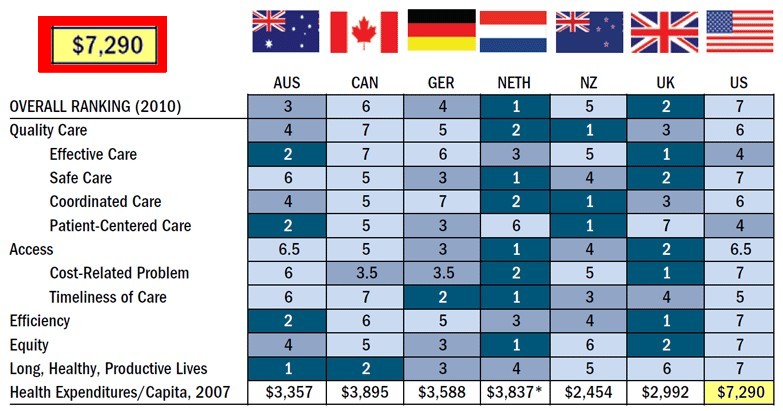
Take a
look at the price tag at the bottom. There's America
charging its citizens TWICE as much for health care and
ranking dead last in quality. We can beat all six of
those countries in Olympic Gold Medals any day of the week,
but our health care system won't even make it to the final
heat.
|
Universal Health Care
In other words, America is
practically the only developed country in the world left that
still thinks the free-market, capitalist approach to health
care is the superior approach.
And how well is that idea
working for us?
Not very well.
According to this
Bloomberg Report, the USA ranked 46th in 2013.
While you are at it, take a look at that "Health Care per
Capita"... $8,608 per person
Good grief, is
that Iran in #45? We spend
$8,600
per person and Iran spends $346
and still beats us? Doesn't it make you want to
scream: Who in the hell designed America's
health system???
Everyone in the
world has a
better system that the USA. It is called "Universal
Health Care".
|
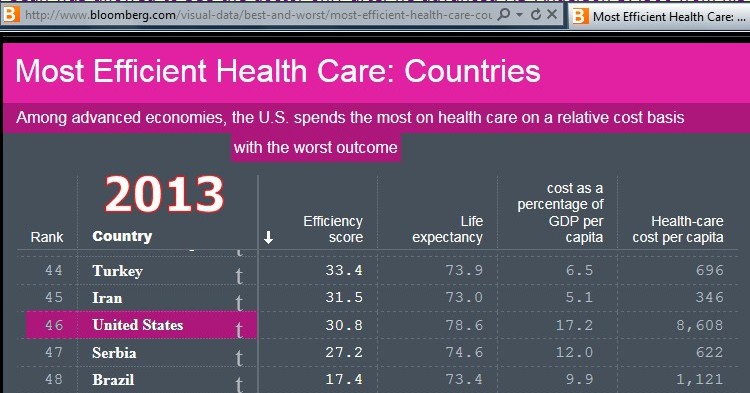 |
Earlier in the
Sean Recchi story about the inflated hospital costs at MD
Anderson, the writer Steven Brill made this statement:
According to one of a series of exhaustive
studies done by the McKinsey & Co. consulting firm,
the USA spends more on health care
than the next 10 biggest spenders combined: Japan, Germany, France,
China, the U.K., Italy, Canada, Brazil, Spain and Australia.
Out of
curiosity, I checked what Wikipedia had to say about each
system. Read for yourself.
Japan
|
| |
Payment for
personal medical services is offered through
a universal health care insurance system
that provides relative equality of access,
with fees set by a government committee.
People without insurance through employers
can participate in a national health
insurance program administered by local
governments. Patients are free to select
physicians or facilities of their choice and
cannot be denied coverage. Hospitals, by
law, must be run as non-profit and be
managed by physicians. For-profit
corporations are not allowed to own or
operate hospitals. Clinics must be owned and
operated by physicians. |
|
source |
France
|
| |
The French health
care system is one of universal health care
largely financed by government national
health insurance. In its 2000 assessment of
world health care systems, the World Health
Organization found that France provided the
"close to best overall health care" in the
world. |
|
source |
China
|
| |
China's
government, specifically the Ministry of
Health of the State Council oversees the
health services system, which includes a
substantial rural collective sector but
little private sector. Nearly all the major
medical facilities are run by the
government. |
|
source |
U.K.
|
| |
Healthcare in
England is mainly provided by England's
public health service, the National Health
Service, that provides healthcare to all
permanent residents of the United Kingdom
that is free at the point of use and paid
for from general taxation. |
|
source |
Italy
|
| |
Health care
spending in Italy accounted for 9.0% of GDP
in 2006 (about $2,600 per capita) of which
about 75% is public.
In 2000 Italy's healthcare system was
regarded, by World Health Organization's
ranking, as the 2nd best in the world after
France. Italy has
the world's 10th highest life expectancy.
Thanks to its good healthcare system,
the life expectancy at birth in Italy was
80.9 years in 2004, two years above the OECD
average. |
|
source |
Canada
|
| |
Health care in
Canada is delivered through a publicly
funded health care system, which is mostly
free at the point of use and has most
services provided by private entities. |
|
source |
|
Brazil |
| |
Primary health care
remains the responsibility of the federal
government, elements of which (such as the
operation of hospitals) are overseen by
individual states. Public health care is
provided to all Brazilian permanent
residents and foreigners in Brazilian
territory through the National Health Care
System, known as Unified Health System - SUS.
The SUS is universal and free for everyone. |
|
source |
Spain
|
| |
Under Chapter III
of the 1978 Spanish Constitution, all
Spanish citizens are beneficiaries of public
health services. Article
39: The public powers assure social,
economic and
juridical protection of the
family.
Article 43: The right to health
protection is recognized.
It is the responsibility of public
authorities to organize and act as
guardian over public
health through preventive measures
and the provision
of necessary services. |
|
source |
Australia
|
| |
Health care in Australia
is universal. The federal government pays a
large percentage of the cost of services in
public hospitals. |
|
source |
Here in
America, "Universal Health Care" is considered a code word
for "Socialism". Now I understand that Americans have
been trained to reflexively hiss and boo whenever the nasty
word "Socialism" is whispered, but just think
about this for a minute.
At its basis, "Socialism"
is simply
a philosophy that suggests some things are better regulated by the
community as a whole.
|
 |
By suggesting
America's health care be regulated by the central government,
I am hardly recommending something that is particularly
profound.
In fact, I think
it is common sense.
Public Health
Care is simply too important to be handed over to
corporations that will perpetually act in their own
self-interest.
PROFITS OVER
PEOPLE DENY DENY DENY
|
"Socialized
medicine" is a term used to describe and discuss systems of
universal health care—that is, medical and hospital care for
all at a nominal cost by means of government regulation of
health care and subsidies derived from taxation.
The idea has
been around forever. Universal health care and
national health insurance were first proposed by President
Theodore Roosevelt. President Franklin D. Roosevelt later
championed it, as did Harry S. Truman as part of his Fair
Deal.
It took master
mover and shaker Lyndon Johnson to get at least some of this
idea implemented when he created Medicare in 1965.
What do you
think Medicare is? Medicare is "socialism" in action.
It is a medical safety net for the elderly funded by all the
taxpayers.
Why do you think
we have Medicare in the first place? Before
Medicare's creation in 1965 under President Johnson,
two-thirds of people over 65 had health insurance, but guess
how much they paid...
Thanks to the
policies of the self-serving health insurance companies, older adults
were forced to pay more than three times as much for health
insurance as younger people.
Coverage was completely unavailable or unaffordable to the
rest. If a person was old AND poor, have mercy
upon their soul.
That was 40
years ago. Now today thanks again to the same ongoing
policies of our nation's health insurance companies, we are
almost in the same situation, but now our "least healthy
people" are the ones discriminated against.
50
million Americans are denied health coverage due to lack of
funds or "pre-existing conditions". In other words,
the same problems the elderly had back in Sixties has now
reached a critical point in the general population.
Our American
"Profits over People" health care system is an utter
failure.
What is the best
solution? Probably we should copy one of the systems
that other countries have successfully adopted. Take
your pick - the Canadian system, the English system, the
French system or the Japanese system. I don't care;
any one of those four systems are rated better than ours.
Hillary Care
The
World Health Report said the American system was ranked 37th in the
world... oops, those were the 2000 rankings... we have slipped
since then.
The USA is
currently ranked 46th in world by
Bloomberg.
If
something isn't done, I shudder to think what our
ranking will be in 2020.
So if we are
ranked so poorly, why doesn't someone in government do
something about it? Funny you should
ask.
|
 |
|

In 1993,
President Bill Clinton spoke to Congress about the need for
health care reform. He said:
If Americans
are to have the courage to change in a difficult time,
we must first be secure in our most basic needs.
Tonight, I want to talk to you about the most critical
thing we can do to build that security. This health care
system of ours is badly broken, and it is time to fix
it.
Despite the dedication of literally millions of talented
health care professionals, our health care is too
uncertain and too expensive, too bureaucratic and too
wasteful. It has too much fraud and too much greed.
At long
last, after decades of false starts, we must make this
our most urgent priority, giving every American health
security — health care that can never be taken away,
health care that is always there. That is what we must
do tonight.
As some of us
"older people" will
remember, at that point Clinton handed his wife the ball and
told her to run with it.
Hillary Clinton tried hard to implement health
care reform in 1993, but quickly ran into a firestorm of
opposition. Mrs. Clinton put
up a good fight, but it was all for naught. In the end she did not even come close
to succeeding. As the burning effigy suggests, Hillary
became rather unpopular in the process. In fact, I
would guess she was the most hated woman in America.
According to
Michael Moore's Sicko documentary, one of Hillary's
problems was that she ran into some considerable opposition
from the
Republican party among others.
 |
The
Republicans put out the message that
universal
health care meant more government control and less
control by the people.
This of
course led to the big scare word, SOCIALISM.
|
Attack ads
filled the TV. People were told that socialized
medicine would lead to a domino effect ending with the fall
of freedom and the worst medical system in the world.
As for me, I
bought the message hook line and sinker. I hated
Hillary with a purple passion. I was so glad when they
beat her down. Now, looking back, I wish I had paid
better attention.
What I am aware
of now is how easily the media was able to sway public
opinion. Like the Swift Boat ads that sunk John Kerry
in 2004, those attack ads against Hillary did the trick.
As I said
before, whoever owns the gold makes the rules.
The story of
Hillary Care is a perfect example of that slogan. A
veritable avalanche of money rained down to defeat this
reform. That money is what paid for the media blitz
that beat her.
A casual glance
at the list of her opponents shows that the Health Insurance
Companies contributed $15 million to defeat these reforms.
Gee, why does that not surprise me?
I also see the
American Medical Association chipped in $3 million
additional dollars. No surprise there either. Doctors
as a whole are always opposed to medical reform because they
fear they will make less money.
When all the
various contributions were added up, the
health care
industry had spent $100 million to defeat Hillary's plan.
Meanwhile, by
the end of the Nineties, the United States had slipped to
#37 on the ranking of world health care systems.
|

Hillary was burned in effigy over her health reform
proposals.
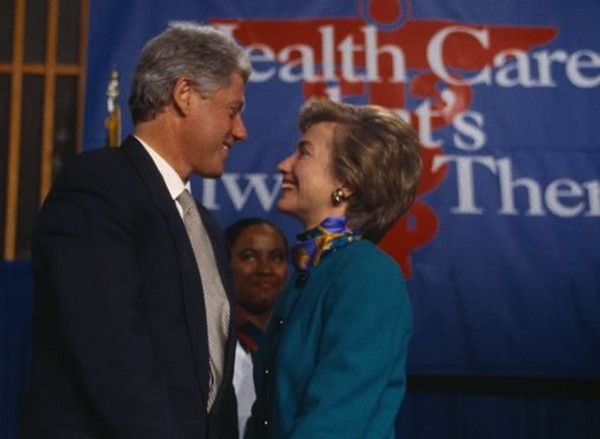
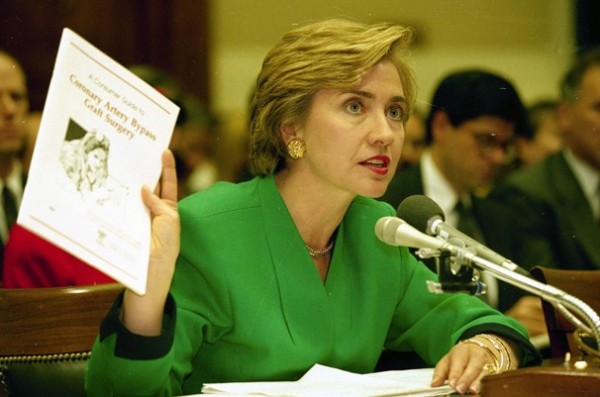
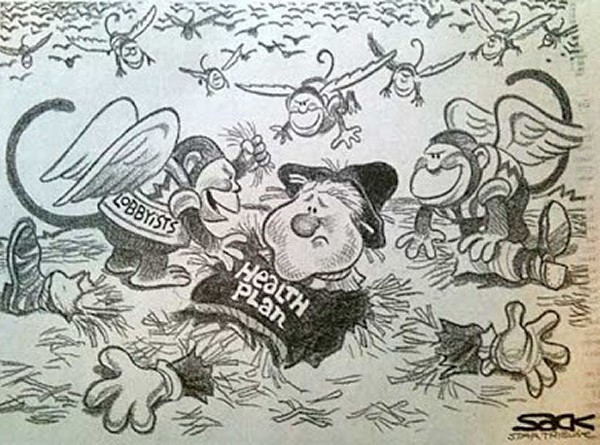
|
|
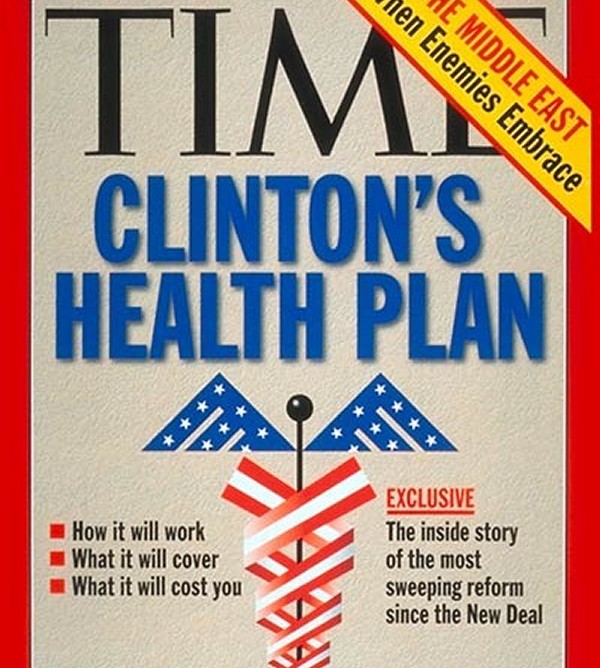
Hillary
Clinton tried her best to get America to accept Universal
Health Care.
|
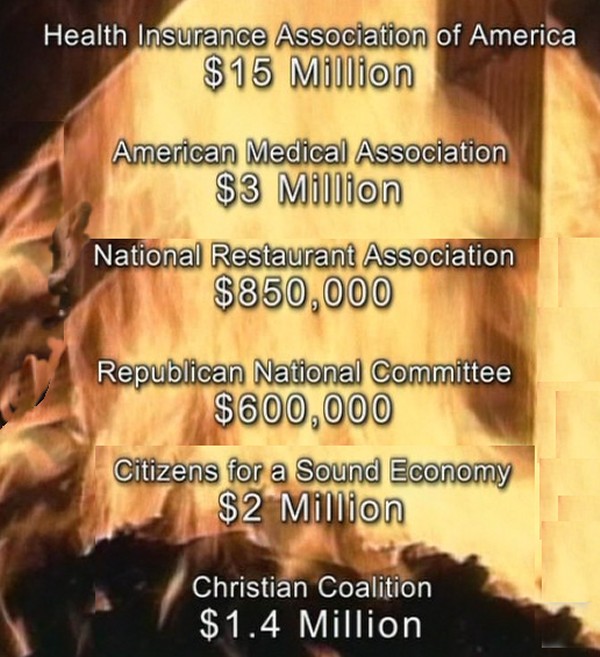
This
is just a partial list of the opponents. The overall tab of the people
lined up to defeat Hillary Care approached $100 million.
|
| |
|
The Twisted Golden Rule,
Example 5
Bush
Care -
The Medicare
Modernization
Act
|
Rick Archer's
Note:
Put on your seat
belts and maybe have a drink to calm your nerves. This story is a doozy.
Earlier
in my article I wrote:
"The chart shows
quite clearly that something badly went wrong with our
health system starting around 1978. The chart also
shows that things really began to spiral even more out of
control in
2004.
Although the chart ends at
2007, we all know that things have only gotten worse since
then.
It is beyond
pathetic for American citizens to pay the most money of any
society in the world and yet have our system ranked among
the most mediocre.
How could things have gotten this
bad?"
You are
about to get a direct answer to that question.
|

As one
can readily see, health costs in the USA are rising much
faster than in other countries.
Wikipedia
|
In his 60
Minutes segment titled Under the Influence, Steve
Kroft opened with this statement:
"If
you have ever wondered why the cost of prescription
drugs in the United States are the highest in the world
or why it's illegal to import cheaper drugs from Canada
or Mexico, you need look no further than the
pharmaceutical lobby and its influence in Washington,
D.C."
Kroft went on to expose a series of highly questionable
moves on the part of several Congressman in regards to the
passage of a controversial pharmaceutical drug bill in 2003.
If you had any doubt before,
this story will make it perfectly clear that our government
is run by certain people with highly questionable integrity.
Let me say this again -
Whoever owns the gold
makes the rules.
Before we
discuss the Medicare Modernization Act (MMA)
of 2003, I want everyone to know that I voted for George W.
Bush in the 2000 Election. Previously I voted for
Reagan. And I voted for Bush over Clinton. Now
that we have that issue cleared up, I prefer not to be
characterized as a left-leaning Democrat.
When it comes to
politics, I call it like I see it. And in this case,
the way I see it, the politics involved in passing this bill
were beyond shameful.
The initial part of
the following account is taken from an
article about the passage of the bill written by
Jake Tapper and Dan Morris for ABC
News and Nightline.
In addition, I used material from a
Wikipedia article on the same story to help with
narration.
Then I concluded
this story using the amazing article
Under the Influence as seen on CBS' 60 Minutes
with credit to correspondents Steve Kroft and Michelle
Singer.
........
The Medicare Bill of
2003
The MMA,
or 'Medicare Bill' as I will refer to it, was
signed by President George W. Bush on December 8, 2003,
after passing in Congress by a close margin.
The bill was debated and negotiated for nearly six months in
Congress. In the end,
it barely passed amid
highly unusual circumstances.
Several times in the legislative process the bill had
appeared to have failed, but each time it
was saved when a couple of Congressmen
conveniently switched positions on the bill
at the last minute.
In the days leading up to this bitterly contested vote,
Bush and Republican leaders said the
price tag for the new law would cost $400 billion.
It would provide drug benefits to seniors beginning
in 2006, as well as subsidies to insurance companies and
HMOs. It would also allow the first steps to allow private
plans to compete with Medicare.
The Curious Story of the Price Tag
According to Robert E. Moffit, director of the Center for
Health Policy Studies at the Heritage Foundation, the GOP
leadership of the House and Senate said, "Look, we're going
to have a financially responsible drug benefit. That's what
we're going to have, and it's not going to
cost any more than $400 billion
over 10 years."
And the conservatives in Congress were saying,
"Wow, that
price is really steep, but OK, all
right. You know, we budgeted that, but
the price tag can't
go any higher
than that!"
Robert Moffit said
that due to the level of the protest over
the cost, the supporters of the
bill became locked into a position where they had to
hold to that line. Conservatives
like Rep. Pat Toomey, R-Pa., thought
that even the Republican
leadership's $400 billion price tag was too high,
too expensive. Toomey and
others were ready to vote 'no' if the price tag rose even
slightly.
Without any cost containment mechanism, Toomey said,
he was concerned the Medicare bill
would exceed the promised cost.
Toomey told ABCNEWS:
"There is no mechanism to contain the cost of this bill. And
you know in the history of every entitlement program in
American history, they end up costing far more than the
initial projections."
The events that followed bore Toomey's dire prediction out.
Unbeknownst to Toomey,
there was a serious doubt raised
about the program's looming cost by Medicare actuary
Richard Foster.
Richard Foster
was a 30-year veteran of
the Medicare process. An
independent man known his integrity, Foster was
relied upon by both Democrats and Republicans for
his unbiased accounting.
Foster
calculated the cost of the bill and the number he
came up with it was much higher than the $400
billion touted by the Bush administration and the
Republican leadership.
Compared to the $400 billion
price tag touted by the White House, Foster "had
projections that were between $500 and $600 billion
over 10 years for the drug benefit,"
according to Robert Moffit.
Cybele Bjorklund, a top health-care staffer for
House Democrats, had relied on Foster's numbers for
years. At least until last June.
"I had asked [Foster] for information on the effect
and cost of particular proposals," Bjorklund told
ABCNEWS, "and he said that he had at least part of
the information ready, but that he was not allowed
to give it to me. I asked him why, because under the
law we are entitled to access this information and
he had prepared it, and he was clearly unhappy with
telling me that he couldn't give it to me.
And he said that he'd been threatened."
|

Richard Foster knew that Congress
was being misled on the cost of this bill, but he
was silenced by his boss, Thomas Scully, a Bush
appointee.
|
Bjorklund said Foster told her that Medicare Administrator
Thomas Scully — a Bush political appointee — had
called him into his office and told
Foster he could not give
cost estimates to Congress anymore without Scully's prior
approval.
"I was not happy about that," Foster told a congressional
committee Wednesday. "I could ignore orders, but I knew I
would be fired."
That night, Bjorklund said, she caught up to
Thomas Scully and confirmed
Foster's story.
Bjorklund:
"I said to Scully, 'How can you do
that? You need cause, he's protected'. And
Scully
replied, 'If he gives that
information to you, I will fire him so fast his head
will spin.' "
"It struck me as a political basis for making that
decision," Foster said Wednesday. "I considered that
inappropriate and, in fact, unethical."
Thomas Scully has denied this
story.
However, no one believes him. Richard Foster had a 30
year career with impeccable credibility. His story is
corroborated by Cybele Bjorklund. Furthermore,
Scully left government
shortly after to work for a law firm and investment
bank with major health-care industry clients.
As they say, actions speak louder than words.
Why Foster's calculations may have been withheld soon seemed
clear. A few weeks after the Medicare bill was
signed into law, the bill's estimated cost began to rise.
Now that it didn't matter any more, the
Bush administration began admitting
publicly it would cost $534 billion for the next 10 years —
about $140 billion more than it had
promised Congress the bill
would cost.
"Within the Republican caucus there were a number of
senators who were very uneasy about this, just from the
dollar figure alone," said
Chuck Hagel, R-Neb.
"The $400 billion number was critical because that fit
within the budget which most of us voted for."
With costs now far exceeding that
figure, the bill's outcome was far from assured passage.
Now members of Congress on both
the left and right began to ask: When did the Bush
administration know that the bill would probably cost more
than $140 billion more than it had
said?
On 30 January
2006 of
this year, Bjorklund got a hint. "One Friday afternoon,
working in my office, I heard a fax come in.
When I checked the machine, it was a table that was
unattributed. It had come in
anonymously and it showed an estimate performed by Foster's
office last June 11.
It was an estimate of a package that was similar to
what passed the Senate and it showed a score of $551
billion."
According to this fax, therefore, around the time Foster
was allegedly being silenced, the Bush administration
already possessed evidence that the numbers it was touting
to Congress were far too low.
"They said that there were nuclear weapons in Iraq and that
Iraq was involved in 9/11, and that was false," argued Sen.
Edward Kennedy, D-Mass. "They had indicated that this bill
was going to cost $400 billion, and that was wrong.
And
they misrepresented the figures
here. They not only deceived the Congress, they
basically lied."
Rachel Maddow on
Thomas Scully
Mr. Scully's career in
government took a turn for the infamous after he
ordered another government official to withhold
information from Congress. That
information was how much President Bush's Medicare
prescription drug benefit would cost.
Publicly, the Bush
administration was saying it would cost no more than
$400 billion. Privately, they knew it was more like
$600 billion. But Thomas Scully made sure that
Congress never knew that.
A Bush administration
investigation found that Mr. Scully threatened to
fire the actuary who came up with the real cost
figures if that actuary gave those real cost numbers
to Congress. And while he was doing that, Mr. Scully
was also busy getting himself a special waiver that
would allow him to get a job as a health industry
lobbyist as soon as he left government.
So, think about this for
a second. He helped that prescription bill get
passed by hiding its true costs, then he immediately
went to work for companies who stood to make a mint
from the fact that he got that bill passed. It's
nice work, if you can get it, right? You know, it is
technically legal to interfere with a federal
employee who's trying to communicate with Congress.
But Mr. Scully was never
charged. Instead he
left his job to become a
lobbyist and started raking in the D-O-U-G-H, dough.
Ha, ha, ha, suckers!
(source)
|
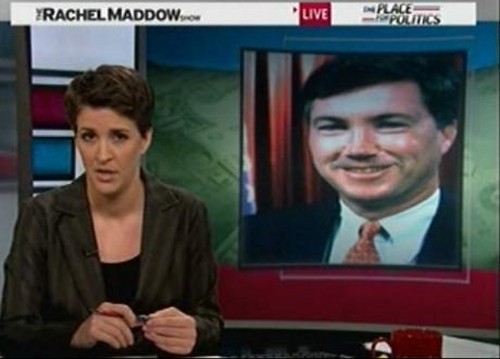
Medicare Administrator Scully
received an ethics waiver so he was able to
negotiate the Medicare bill and simultaneously
negotiate with various companies for his next job -
companies representing health-care interests that
stood to make millions from the bill.
|
How
the First Vote Went
The bill was introduced in the House of Representatives
early on 25 June 2003 by Speaker
Dennis Hastert. All that day and the next the bill was
debated, and it was apparent that the bill would be very
divisive. In the early morning of June 27, a floor vote was
taken. After the initial electronic vote, the count stood at
214 yeas, 218 nays.
Three Republican representatives then changed their votes.
One opponent of the bill, Ernest J. Istook, Jr. (R-OK-5),
changed his vote to "present" upon being told that C.W. Bill
Young (R-FL-10), who was absent due to a death in the
family, would have voted "aye" if he had been present. Next,
Republicans Butch Otter (R-ID) and
Jo Ann Emerson (R-MO) switched
their vote to "aye" under pressure from the party
leadership. The bill passed by one vote, 216-215.
On June 26, the Republican-controlled
Senate passed its version of the bill, 76-21. The
bills were then unified in
conference.
How
the Second Vote Went
On November 21, the bill came back
to the House for final approval.
Things were far from normal from
the moment the Medicare bill was called for a vote in the
House of Representatives. The
voting was done at 3:01 a.m. on Saturday, November
22, 2003.
After 45 minutes, the bill was losing, 219-215, with David
Wu (D-OR) not voting.
Speaker Dennis Hastert and Majority Leader Tom DeLay sought
to convince some of dissenting Republicans to switch their
votes, as they had done previously back
in June.
In the speaker's crosshairs were several of the 12
Republicans who had signed a letter organized by Toomey
complaining about the bill's flaws and pledging their
opposition. But by the end of the night, nine of those
principled 13 — Republican Reps. Sue Myrick of North
Carolina, Marsha Blackburn of Tennessee, Joseph R. Pitts of
Pennsylvania, Roscoe Bartlett of Maryland, Trent Franks of
Arizona, David Vitter of Louisiana, and Joe Barton, Jeb
Hensarling, and John R. Carter of Texas — voted for the
bill.
Only Pat Toomey
of Pennsylvania, Tom Feeney of Florida, Gresham
Barrett of South Carolina, and Scott Garrett stuck to their
guns.
Istook, who had always been a wavering vote, consented
quickly, producing a 218-216 tally. In a highly unusual
move, the House leadership held the vote open for hours as
they sought two more votes.
At this point, Representative
Nick Smith (R-MI) claimed he was offered campaign funds
for his son, who was running to replace him.
This offer would be in return for a change in his
vote from "nay" to "yea."
After controversy ensued, Smith backed
down a bit. He clarified tht
no explicit offer of campaign funds was made, but that he
was offered "substantial and aggressive campaign support"
which he had assumed included financial support.
About 5:50 a.m., Hastert convinced
Otter and Trent Franks (R-AZ) to
switch their votes. With passage assured, Wu voted yea as
well, and Democrats Calvin M. Dooley (D-CA),
Jim Marshall (D-GA) and David
Scott (D-GA) changed their votes
to the affirmative.
The vote had been scheduled to last only 15 minutes.
However, the Speaker made sure to keep the vote until he got
what he wanted.
Finally, at 6 a.m. — nearly three hours after the 15-minute
vote began — the gavel came down and the triumphant
Republican chair announced that the Medicare bill had
passed. The bill passed
220-215.
The Democrats cried foul, and Bill Thomas, the Republican
chairman of the Ways and Means committee, challenged the
result in a gesture to satisfy the concerns of the minority.
He subsequently voted to table his own challenge; the tally
to table was 210 ayes, 193 noes.
"The three-hour vote will enter the realm of dark legend,"
Robert Moffit said. "This was not
good government's finest hour, shall we say."
Added Norm Ornstein: "There is
simply no question here that what Speaker Hastert did in the
name of winning at all costs stained his speakership and
stained the House of Representatives in a way that will last
for a very long time."
The Senate's consideration of the conference report was
somewhat less heated, as cloture on it was invoked by a vote
of 70-29. However, a budget point of order raised by Tom
Daschle, and voted on. As 60 votes were necessary to
override it, the challenge was actually considered to have a
credible chance of passing.
For several minutes, the vote total was stuck at 58-39,
until Senators Lindsey Graham (R-SC), Trent Lott (R-MS), and
Ron Wyden (D-OR) voted in quick succession in favor to pass
the vote 61-39. The bill itself
was finally passed 54-44 on November 25, 2003, and was
signed into law by the President on December 8.
The Saga of Nick Smith
by
Jake Tapper
Strong-arming is one thing, but the extreme measures
employed on the floor that night have triggered an
investigation by the House Ethics Committee.
Investigators are focusing on the tactics used
against Rep. Nick Smith, R-Mich., who refused to
buckle and voted no on the bill.
In December, Smith — who has largely kept away from
the media since then — described the scene to a
local Michigan radio station, WKZO-AM in Kalamazoo.
"The arm-twisting was probably as strong as I've
ever seen it," Smith said. "They threatened — here's
what they did. They started out by offering the
carrot." Smith is retiring this year, with his son
Bradley running to replace him, "so the first offer
was to give him $100,000-plus for his campaign and
endorsement by national leadership. And I said no,
I'm gonna stick to my guns on what I think is right
for the constituents in my district."
|
 |
The carrot having failed to work, Smith said, out came the
stick. "They said, well, if you don't change your vote —
this was about 4 a.m. Saturday morning — then some of us are
going to work to make sure your son doesn't get to
Congress." Smith says he "told them to get the heck out of
there and I mighta used a different word besides heck."
Norm Ornstein of the American Enterprise Institute
said "that, by any reasonable standard, is a bribe, and
we're now in the middle of investigating it."
In December, after the Justice Department said it would
review the bribery allegations, Smith issued a statement
that contradicted some of his earlier claims, insisting no
specific money amount had been cited.
Billy Tauzin
-
From Congress to Lobbyist
One of the stranger tales to
come out of this fracas was the role of Billy Tauzin (R-LA).
Tauzin was the key player in the passage of the Medicare
bill. Then one month after the bill was passed, Tauzin
resigned his post to work for Big Pharma. His switch
from regulator to lobbyist was widely noted. In fact,
how could anyone not notice? After all, Tauzin
practically flaunted his lucrative reward for switching
sides.
According to Jason Linkins of the
Huffington Post, Billy Tauzin is an example
of a former Legislator who managed to get
staggeringly rich by peddling influence.
Linkins stated that after Tauzin quit his post in
Congress to become a drug lobbyist, he made
$19,359,927 in 4 years shilling for Big Pharma.
In 2010 alone, Tauzin was paid $11.6 million by the
pharmaceutical industry.
Tauzin originally worked his way to become Pharma's chief
lobbyist when he played a key role in shepherding the
Medicare Prescription Drug Bill through Congress. This
was a bill which had been criticized by opponents for being
too generous to the pharmaceutical industry. In fact,
the bill was so generous to Big Pharma that a great deal of
opposition arose to its passage. That's when Tauzin
stepped up his efforts.
What exactly did Tauzin do to become so instrumental to the
passage of this bill? Two months before resigning as
chair of the committee which oversees the drug industry,
Tauzin did everything within his power to steer the drug
bill through Congress.
In his position as chairman of the House Energy and Commerce
committee, Tauzin wrote the law creating Medicare’s
prescription drug benefit, a boon to the pharmaceutical
industry. When it time to pass the bill, there were a
lot of votes that changed sides at the last minute.
Rumor has it that Tauzin did most of the serious
arm-twisting.
Walter Jones
(R-NC) commented that the final vote was the "ugliest night"
he had "ever seen in politics in 22 years".
When asked
to comment by Steve Kroft, Tauzin replied, "Getting bills
passed is just a messy process. I mean, the old adage
about if you like sausage or laws, you should not watch
either one of them being made is true. It's a messy
process."
As for arms being twisted? "People were being talked
to," Tauzin says.
The
3 am - 6 am Vote
The unorthodox 3 am roll
call on one of the most expensive bills ever placed
before the House of Representatives began in the
middle of the night, long after most people in
Washington had switched off C-SPAN and gone to
sleep.
The only witnesses were congressional staffers,
hundreds of lobbyists, and U.S. representatives,
like Dan Burton, R-Ind., and Walter Jones, R-N.C.
"The pharmaceutical lobbyists wrote the bill," says
Walter Jones. "The bill
was over 1,000 pages. And it got to the members of
the House that morning, and we voted for it at about
3 a.m. in the morning," remembers Jones.
Why did the vote finally take place at 3 a.m.?
"Well, I think a lot of the shenanigans that were
going on that night, they didn't want on national
television in primetime," according to
Dan Burton.
Too Close to Call
The
2002 political campaign was particularly critical
for the pharmaceutical industry. 2002 saw an
explosion of the drug industry’s political activity.
The drug industry had raised its political donations
up for two election cycles in a row. Now front
groups poured millions of dollars into advertising
campaigns in tight races around the country.
Not surprisingly, the industry’s preferred
candidates won race after race.
In 2002, the Republican Party retook control of the
Senate and expanded its small advantage in the House
of Representatives.
But when it came time to cast ballots, the
Republican leadership discovered that a number of
key Republican congressmen had defected and joined
the Democrats, arguing that the bill was too
expensive and a sellout to the drug companies.
Dan Burton and Walter
Jones were among the men
who felt that way.
The bill was defeated in the first vote. That
should have been it; turn out the lights, go home.
But that wasn't it. They kept the vote open.
"They're supposed to have
15 minutes to leave the voting machines open and it
was open for almost three hours,"
Dan Burton explained.
"The votes were there to defeat the bill for two
hours and 45 minutes, but they
had leaders going around and gathering around
individuals, trying to twist their arms to get them
to change their votes."
Steve Kroft
asked Billy Tauzin, one of the main arm twisters, why a vote
that was scheduled to last a maximum of 15 minutes was kept
open for three hours. Tauzin replied that the voting
machines were kept open for three hours "because the vote
wasn't finished."
Which in
Kroft's opinion meant that the vote wasn't going to be over
until Tauzin got the vote he wanted. Tauzin just
smiled.
|
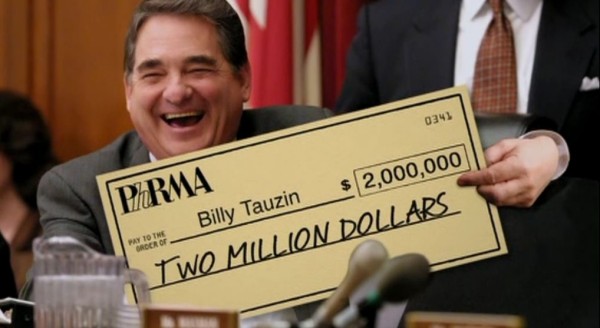
Shortly
after Billy Tauzin successfully steered the
controversial drug bill through the House of
Representatives, he chose not to run for
re-election. Instead just months later Tauzin
went to work for the pharmaceutical industry as
their chief lobbyist. As the picture
indicates, Tauzin wasn't shy about displaying his
compensation.
They say a picture is worth a thousand words.
Well, the message underlying this picture is worth
two million dollars.
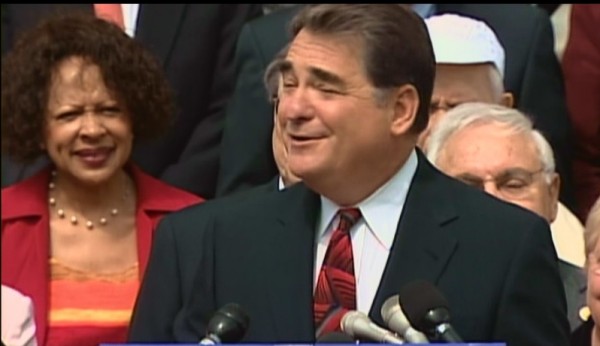
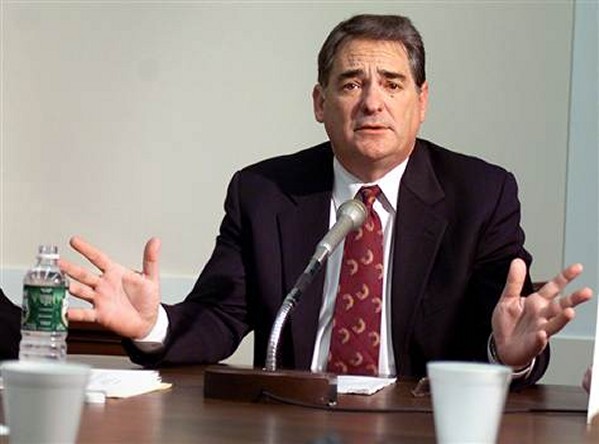
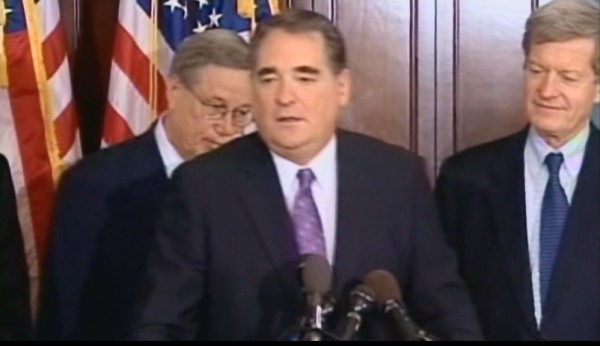
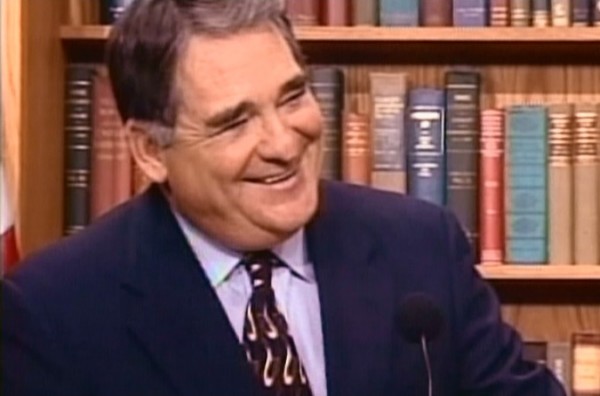 |
| |
BUYING A
LAW: Big Pharma’s Big Money and
the Bush Medicare Plan
Rick Archer's
Note: The entire purpose of my article has
been to demonstrate that money equals power and Whoever has
the Gold Makes the Rules. If the reader still has any
doubt about just how true this concept is, but wishes to be
persuaded a bit more, then please
continue reading. The following excerpts are taken directly
from a PDF posted on the Internet by
Paxil Progress.
These pictures
appeared in the documentary Sicko. The numbers reflect the
contributions given by the drug industry to the men and
woman mainly responsible for getting the bill passed.
Now keep in mind
these are merely donations. They say these donations in no way
obligate our elected representatives to look favorably on
any legislation put forward by the donors. But isn't
funny how the votes of these politicians so frequently seem to favor their benefactor?
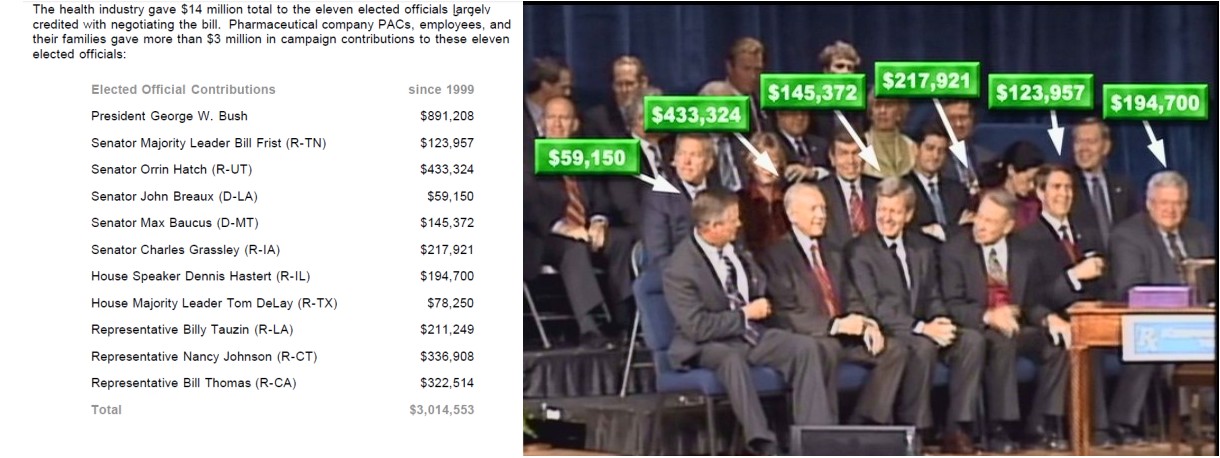 |
SHARING
THEIR WEALTH: PHARMACEUTICAL CAMPAIGN CONTRIBUTIONS
|
In compiling this report, Public Campaign Action Fund and
its Campaign Money
Watch program used
investigations and research done by several
organizations, as well as other research reports,
that preceded this analysis.
In a period from
1999 to 2004,
Pharmaceutical companies gave $44
million in political contributions.
78% went
to Republicans and 22% to Democrats.
They
spent millions more hiring an army
of lobbyists that physically outnumber the 535 members of
Congress.
The drug lobby
spent $544 million on lobbying Congress, federal agencies,
and the White House between 1997 and 2002. They hired 675
lobbyists – more than one for every one of the 535 members
of Congress.
They
funneled still millions of dollars more in additional funds
to front groups to do their
bidding under politically-palatable sounding names like
Citizens for a Better Medicare and
United Seniors Association.
Under the Influence
A 60
Minutes
Segment narrated by Steve Kroft
If you have ever wondered why the cost of prescription drugs
in the United States are the highest in the world or why
it's illegal to import cheaper drugs from Canada or Mexico,
you need look no further than the pharmaceutical lobby and
its influence in Washington, D.C.
According to a report by the Center for Public Integrity,
congressmen are outnumbered two to one by lobbyists for an
industry that spends roughly $100 million a year in campaign
contributions and lobbying expenses to protect its profits.
One reason those profits have exceeded Wall Street
expectations is the Medicare prescription drug bill.
It was passed more than three-and-a-half years ago, but
its effects are still reverberating through the halls
of Congress, providing a window into how the lobby works.
"I can tell you that when the bill passed, there were better
than 1,000 pharmaceutical lobbyists working on this," says
Rep. John Dingell, D-Mich.
Dingell said the bill would not
have passed without the efforts of the drug lobby.
"There is probably a lotta truth in it that the bill was
stacked in their benefit. And it's probably also true that
it was written by their lobbyists,"
Dingell says.
Said Dan Jones: "You couldn't even
walk to the steps of the Capitol without having somebody,
maybe one or two, coming up to you to say, 'Can't you change
your vote? Can't you vote for this bill?' "
What was the Payoff for the Drug Industry?
Why was the drug lobby was so interested in this bill and
what did it have to gain? Ron
Pollack, the executive director of Families USA, a
nonpartisan health care watchdog group, said
it all boiled down to a key provision in the legislation.
This provision prohibited Medicare
and the federal government from using its vast purchasing
power to negotiate lower prices directly from the drug
companies.
"The key goal was to make sure there'd be no interference in
the drug companies' abilities to charge high prices and to
continue to increase those prices," says Pollack.
Pollack says there's no question that this was prompted by
the pharmaceutical lobby.
"They were the ones who wanted to make sure Medicare could
charge high prices and to continue to increase those prices."
The drug industry says that competition among private
insurance plans that service the Medicare program help keep
prices low. But Families USA
contradicted that assertion. They
reported in a January study that Medicare patients
were being charged nearly 60
percent more for the top 20 drugs than veterans pay
under a program run by the U.S. Department of Veterans
Affairs. (source:
Families USA report)
Ron Pollack says the VA
prices are lower because it
successfully negotiates with the drug companies on price.
"Medicare could do the same thing,"
he says, "but
Medicare is prohibited from doing that as a result of this
new Medicare legislation."
Steve Kroft: "What was the logic?
Or what was the idea, the
rationale behind not giving the government the ability to
negotiate drug prices?"
Rep. Dan Burton: "The drug
companies didn't want it. They wanted to make as much as
money as possible. And if there's negotiation, like there is
in other countries around the world, then they're gonna have
their profit margin reduced."
Cashing
Out
According to Melanie Sloan, executive director of
Citizens for Responsibility and Ethics, it is alarmingly
common for members of Congress to depart for highly paid
lobbying jobs. Sloan says, “This practice feeds the
public perception that members are doing big industry’s
bidding so they can cash out. It seems like being a
member of Congress is just a way-station on the path to a
highly paid lobbying job.”
This
practice is hardly limited to Tauzin. For example,
Bloomberg News reported that companies founded by Republican
presidential candidate Newt Gingrich, a former House
speaker, grossed $55 million from 2001 to 2010 for
consulting services and memberships in a health-policy
center. (Bloomberg
News)
Gingrich was
the man given most of the credit for derailing Hillary
Clinton's health reforms back in the Nineties. It
would seem apparent that people like Gingrich and Tauzin are
well-rewarded by the health and drug industry for their
success.
Steve Kroft: Tauzin and Scully
weren't the only public officials involved with the
prescription drug bill who later went to work for the
pharmaceutical industry.
• John McManus, the staff director
of the Ways and Means subcommittee on Health. Within a few
months, he left Congress and started his own lobbying firm.
Among his new clients was PhRMA, Pfizer, Eli Lilly and
Merck.
• Linda Fishman, from the majority
side of the Finance Committee, left to become a lobbyist
with the drug manufacturer Amgen.
• Pat Morrisey, chief of staff of
the Energy and Commerce Committee, took a job lobbying for
drug companies Novartis and Hoffman-La Roche.
• Jeremy Allen went to Johnson and
Johnson.
• Kathleen Weldon went to lobby
for Biogen, a Bio-tech company.
• Jim Barnette left to lobby for
Hoffman-La Roche.
In all, at least 15 congressional staffers, congressmen and
federal officials left to go to work for the pharmaceutical
industry, whose profits were increased by several billion
dollars.
Dan Burton:
"The drug companies have
unlimited resources.
When they push real hard to get
something accomplished in the Congress of the United States,
these companies
will lobby till they get it done."
|

December 8, 2003. The time has come for President Bush
to sign his 2003 Medicare Modernization Act into law.
So first they have a parade of the various people who helped
push this bill through Congress. These are
people who promised to serve the public good. Let's see what
their price tag is.

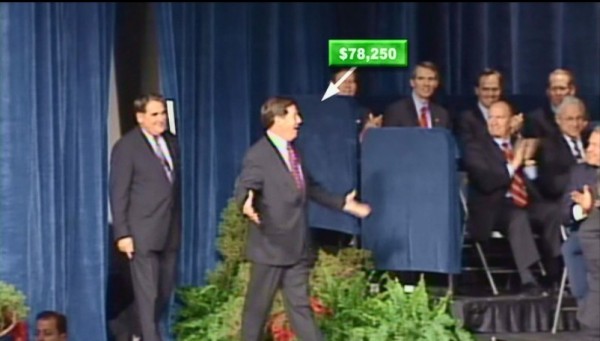
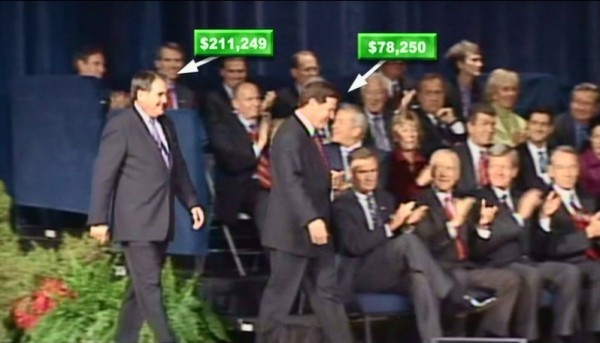


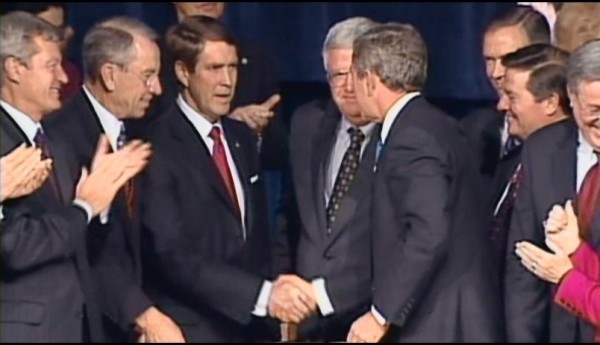
 |
| |
The
Rich Get Richer
Rick
Archer's Note: As I said earlier, Steve Kroft
began his 60 Minutes
segment with these words:
If you have ever wondered why the cost
of prescription drugs in the United States are the
highest in the world or why it's illegal to import
cheaper drugs from Canada or Mexico, you need look no
further than the pharmaceutical lobby and its influence
in Washington, D.C.
Congressmen
are outnumbered two to one by lobbyists for an industry
that spends roughly $100 million a year in campaign
contributions and lobbying expenses to protect its
profits.
So one might
ask: Does the pharmaceutical industry get any sort of
return on this sort of investment? Let's find
out.
As Drug Prices Continue To Soar, Big Pharma Reaped
$84 Billion In Profits in 2012
(Think
Progress,
Tara Culp-Ressler, 2013)
The price of
brand-name drugs has skyrocketed over the past several
years, leading increasing numbers of Americans to switch
over to cheaper generic drugs. But even those generic drugs
are also increasingly costing Americans more money, as chain
pharmacies across the country hike their prices to charge up
to 18 times the drugs’ original cost.
There’s one
clear winner in this equation: the giant pharmaceutical
companies that are raking in the profits.
|
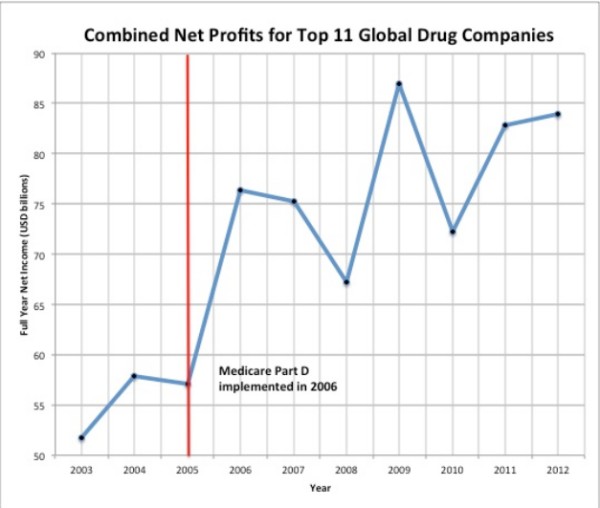
It
should be noted that drug company profits soared following
the passage of the Medicare Bill signed in late 2003.
Note in particular the year 2006 when the "consequences" of
that bill finally kicked in. Hmm. Steve Kroft
said the drug companies pay the lobbyists $100 million a
year.
In
2006, the net income of the drug companies jumped over 20
BILLION DOLLARS. I would say that's a nice return on
investment.
Source:
Think Progress
|
Over the past decade, the 11 largest global drug companies
reaped about $711 billion in profits, according to a new
analysis from the Health Care for America Now (HCAN)
advocacy group. In 2012 alone, the drug companies’ annual
profits totaled nearly $84 billion. The organization’s
analysis credits much of these profits to the federal policy
that prevents Medicare from negotiating directly with drug
companies — which allows Big Pharma to price gouge the
government program’s prescription drug benefit, known as
Medicare Part D:
Medicare’s prescription drug coverage is essential for
seniors — and since Obamacare has helped ensure that more
prescription drugs are now covered under Medicare Part D,
millions of seniors have saved $6 billion on the medication
they need. But, since Medicare is unable to negotiate bulk
purchasing discounts, Big Pharma continues to overcharge the
federal program for those drugs. HCAN points out that
pharmaceutical profits soared around 2006, when Medicare
Part D was first put in place.
Pharmaceutical companies often claim their huge profits are
necessary because that money goes toward innovative drug
research and development. But one recent study found that
drug companies actually spend 19 times more on advertising
their products than they do on investing resources to
develop new ones. And some areas of scientific research,
like the development of new vaccines to replace some old
antibiotics that have become increasingly less effective
over time, have largely stalled because Big Pharma isn’t as
willing to invest money in less-profitable ventures.
While companies should obviously make some kind of profit
from their products, HCAN points out that Big Pharma’s
prices far exceed what people in other countries are paying
for the exact same drugs. The United States’ per capita drug
spending is about 40 percent higher than in Canada’s, 75
percent higher than Japan’s, and nearly three times higher
than Denmark’s.
Rick
Archer's Note: I say the people with the gold make
the rules.
Now you know
how they do it and now you see how the rich grow richer.
However, in
life, for every winner, there has to be a loser.
Or losers.
|
|
|
|
Wealth Inequality in
America
Are you curious
who the "losers" are? The 2000s have been termed a
"Lost Economic Decade" for America. Due to the Great
Recession and continued high unemployment, there has been a
substantial deterioration in Americans' economic security.
These substantial income losses for middle and working-class
Americans has resulted in a sharp increase in Americans
without health insurance.
However, not
everyone suffered. In 2012, the incomes of the Top 1%
rose nearly 20 percent compared with a mere 1% increase for
the remaining 99 percent. 1 in every 4 dollars earned went
to the Top 1% as compared to 1 in every 10 dollars in 1976.
[source]
At this point,
the Top 1% owns 42% of the nation's wealth and the Top 10%
has now captured a record 48% of total earnings.
Corporate
profits hit a record in 2012 as share of U.S. economic
output. Even though unemployment remained at a
high 7.2% and economic growth was sluggish, these economic
changes have helped many employers by reducing costs.
Yale economics
professor Robert J. Shiller, a Nobel prize winner for
economics in 2013, believes that rising economic inequality
in the United States and other countries is "the most
important problem that we are facing now today".
One should note
the last time the wealth disparity between the Rich and the
Not So Rich was this bad was 1928, the year before the Great
Depression began.
America is
creeping closer and closer to being a land of Have's and
Have Not's. Although things aren't quite as
bad as the period before the notorious French Revolution,
nevertheless this
unfortunate situation has set the stage for potential class
warfare.
|
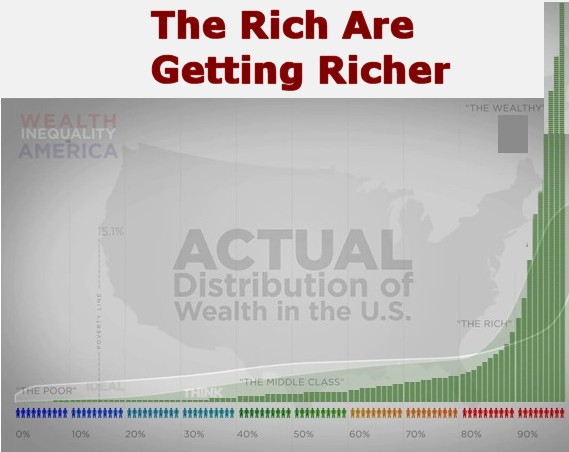
•
The
Top 1% owns 42% of the nation's wealth
•
The
bottom 80% owns less than 7% of the nation's wealth
•
Back
in 1974, one dollar in every 10 went to the Top 1%
•
Today one
dollar in every 4 earned goes to the Top 1%
•
From 1992
to 2007 the top 400 U.S. earners saw their income
increase 392% and their average tax rate reduced by 37%.
In other words, the Rich are Getting Richer (source)
|
It is
to be regretted that the rich and powerful too often
bend the acts of government to their selfish purposes.
In the full enjoyment of the gifts of Heaven and the
fruits of superior industry, economy, and virtue, every
man is equally entitled to protection by law; but when
the laws undertake to add to these natural and just
advantages artificial distinctions, to grant titles,
gratuities, and exclusive privileges, to make the rich
richer and the potent more powerful,
the
humble members of society
— the farmers, mechanics, and laborers — who have
neither the time nor the means of securing like favors
to themselves,
have a
right to complain of the injustice of their Government.
- President Andrew Jackson
|
|
The Twisted
Golden Rule, Example 6
The
Rich Get Richer and Richer and Richer
Rick
Archer's Note: There is a man named Wade
Frazier
who is a brilliant writer. I could read his stories
all day long.
Mr.
Frazier's anecdotes are so vivid that I think I am starting
to understand just how crooked, dog eat dog, and cutthroat
our American business practices are. I am left
wondering if things could actually be worse than the story I
am about to share. If so, we are all in very deep
trouble.
A few years
ago I read not one, but two books on the Enron Scandal.
While I understood what happened on a certain level, it was
not until I read Mr. Frazier's first person account of the
Savings and Loan Scandal in the mid-Eighties that I finally
"got it". I finally knew without a doubt how Andy
Fastow and friends got away with what they did - people
on the inside looked one way AND Enron's accounting firm looked
the other way - and then thousands of innocent people
lost their life savings.
Please read
this remarkable account. I have trimmed it down a bit,
but you can read the entire account here:
My
Adventure by Wade Frazier. Any time you wish,
feel free to substitute "Enron" for "Savings and Loan".
Wade Frazier:
I
did not know what auditing was when I graduated from
college.
When the busy season was over, there was a one-week
training class for the new junior auditors. Near the
week's end we had a “quiz the partner” session. A
partner came to class and answered any question we had.
We put our anonymous questions in a basket.
Among the standard questions for the partner was mine:
"How does auditing increase the world's real wealth?"
In reply to my question, the partner put on a straight
face and gave the standard answer that auditing helps
provide reliable financial information for the business
community, so better investment and business decisions
could be made. Note the key word here is
"reliable".
A
couple of years later I was on an audit with the same
man. That is when I saw how he really felt.
I was with him on a savings and loan (S&L) audit.
He talked about an audit our firm had performed that
exploded in our faces.
As
auditors, we issue "opinions" on our client's financial
statements. Our opinion is published on the
client's annual report and their filings with the SEC
(Securities and Exchange Commission). The opinion
approximately reads: "We audited XYZ Corporation’s
financial statements and found them to be fairly
presented in accordance with Generally Accepted
Accounting Principles."
In
other words, we audited them and told the world that we
had found them playing by the accounting rules. We
gave our word that our report was "reliable".
In return, we received a million or so dollars, which
was the standard fee for a large corporate audit in
those days. Today, it is several times more.
The audit opinion can state that the client played
fairly, while the financial statements themselves show a
company in peril. That is not an audit failure, but if a
company gets close to failing, there is a "going
concern" principle that states if the company appears
that it may soon fail, the auditors should qualify their
opinion. A "qualified opinion" is always bad news and
auditors rarely issue them.
Basically, if a company is close to failing and it
receives a "qualified opinion", then the company is
doomed because our audit guarantees no one will take a
chance on them. It becomes a death sentence.
An audit "exploding in our face" means that the
auditors issued their standard unqualified
opinion implying the company was "reliable", but
then the company soon capsized.
It is conceivable to miss something.
Auditors are not fortunetellers. However,
if a company fails a few months after issuing
"healthy" financial statements, and there is an
unqualified audit opinion accompanying their
statements, this raises eyebrows.
There is a strong implication that we lied.
At this point, the auditors are often sued for a
negligent audit.
(Note:
Arthur Anderson, Enron's auditors,
were put out of business by their failure).
|
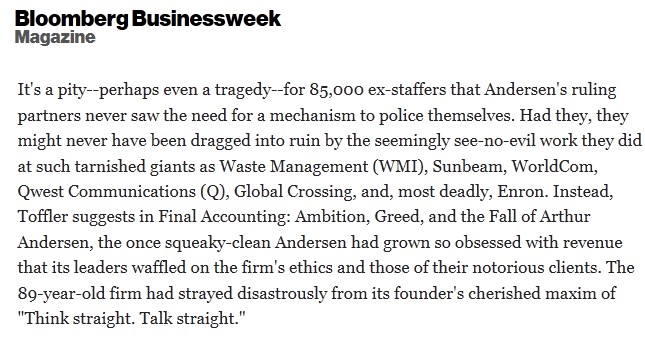
How Arthur Andersen Turned
to the Dark Side,
March 16, 2003
|
In
some ways an audit is a crapshoot, because a future
event that nobody foresaw can capsize the company, but
the "deep pocket" theory means that shareholders and
others left holding the bag will try extracting money
from somebody for the business failure. That is
the risk of being an auditor.
As
auditors, we theoretically rendered independent opinions
on our client's financial statements. However, there was
a catch. After our clients paid our fee, they
could choose another auditor if they wished. This
was important, but I did not understand that situation's
implications in my early days. I was just trying to
survive.
In
1984, something happened that eventually made it clear.
I helped audit one of the world's largest savings and
loan (S&L) institutions. We had been brought in to
audit the S&L immediately after the previous auditors
had been fired. We were on a "high exposure"
audit. "High exposure" meant that the likelihood of the
previous auditors being sued was high.
The previous several months had seen this highflying S&L
run out of money. Here they were posting record revenues
and profits, then suddenly one day they were unable to
pay their creditors and depositors. Then it all came
crumbling down. Suddenly, those record profits appeared
illusory.
There was a 1930s-style bank run, and the federal
government stepped in to keep the S&L’s doors open.
Meanwhile the S&L's shareholders filed a huge lawsuit
against the previous auditors. I was the junior auditor
on that "high exposure" audit. On such audits, my firm
flew in real estate and banking experts from our offices
across the nation, and now our important managers and
partners did the work usually reserved for the lambs
like me.
I
was relegated to coordinating hotel rooms, rental cars
and the audit’s administrative logistics. I was also the
right hand of the partner running the audit. The senior
manager who worked for him (who made partner a couple of
years later) was my direct supervisor. Those two men
were some of the nicest human beings I ever encountered
in public accounting. The reason they were on that audit
was probably because they were such nice guys. People
were not exactly volunteering for the job, so they were
the only ones with enough guts to accept the thankless
task.
I
was a lost waif in the office when I was assigned to
that S&L audit. Although I was low man on the audit's
totem pole, they treated me as if I were a peer - better
than I was ever treated in the LA office.
On my first day there, my manager briefed me. He said, "As
usual, you can make the numbers say whatever you want to
until the money runs out." I had heard that
phrase before, but did not really understand it.
This particular S&L became one of the highest profile
and earliest meltdowns of the entire Savings and Loan
Scandal. The S&L had concocted bogus transactions to
hide their losses. By itself, that was not the
crime of the century, but it was unfortunately a common
corporate activity.
Our job was making sure that practice did not happen on
our watch. We were hired to apply Generally Accepted
Accounting Principles (called GAAP in the profession) to
their books. As we began our audit, it became obvious
that our predecessor auditors had allowed their client
to bully them into signing off on fictitious financial
statements.
The gist of the problem was this:
the Holy Grail of capitalism is profits.
Corporations only exist to make profits for their
owners.
I
have seen numerous instances of corporate executives
making this sagacious statement: "Gentlemen, you must
not forget that we are not in the business of blah
blah blah, we are in the business of making money."
As for blah blah blah, fill in the blank; I have seen
everything from "treating cancer patients" to "making
efficient cars".
That phrase has been repeated endlessly in corporate
halls as a motto to never forget.
With the profit drive being the ultimate reason for a
corporation's existence, corporate managers have
incentive to report the largest possible profits.
There have been principles of accounting, such as the
conservatism principal, the revenue realization
principal, the objectivity principle, the matching
principle and many others that supposedly guide
accounting practices, so profits are not overstated.
The very existence of the Big Eight accounting firms
depended on laws passed during the 1930s in the wake of
Wall Street's collapse and the Great Depression.
These laws were designed to ensure those events would
never be repeated.
On paper, our job was keeping corporations honest in
reporting their profits. Off the record, our job
was to make profits for our own firm. These two
goals were often in direct conflict.
I can remember my idealism. At the university, my
auditing professor told us why the Big Eight partners
made so much money. He said it was because sophisticated
professional judgment was required to render an
independent audit opinion. My professor said that such
highly qualified professionals, with their sophisticated
auditing practices, which entailed numerous levels of
review, did not come cheaply. He said if the government
took over the auditing profession, they would create
bureaucratic guidelines so that a monkey could do an
audit. They would produce substandard audit results and
the profession would be ruined. With no other frame of
reference, I believed it.
Now I saw the truth. On that S&L audit, even an
inexperience lamb like me could see that our predecessor
auditors had signed off on ridiculous accounting
practices. So if it was effortless for an
inexperienced beginner like me to spot, then how could a
highflying Big Eight firm, with its highly paid,
pin-stripe-suited auditors, approve such phony financial
statements? This question rattled around in
my head. It was more baffling than the Riddle of
the Sphinx.
After a month on that audit, the partner in charge, my
manager and I went to lunch. The partner said to me, "If
you look at what (our predecessor auditor) approved, it
is shocking. Yet, if we had been in their shoes, I doubt
we would have done any differently."
My
mouth dropped open. Did he just say we would have
done the same thing?
He
was the nicest partner I ever knew, and his candor that
afternoon helped me figure it out. This partner
said that the predecessor auditors had been bullied into
approving bogus financial statements. How could
they be bullied, with all those accounting standards,
levels of review, and highly honed professional
judgment?
To
put it bluntly: They were bullied by a million-dollar
audit fee.
If
an auditor proved too stubborn in applying GAAP to the
S&L's financial statements, the S&L would merely hire
a more pliant auditing firm.
Meanwhile, the partner who lost the million-dollar
account because he refused to "see" the financial
statements the client's way had probably just seen his
career ruined.
The pressures to look the other way were intense.
This explanation did not fully sink in until years
later, when the entire Savings and Loan Crisis became
headline news in 1988.
A
few years before that audit, the CPA profession was
partly deregulated. The "free market" ideology of the
time, exemplified by Ronald Reagan and his
administration, created the acceptability of doctors,
lawyers and CPAs to begin getting "competitive,"
advertising and taking business away from each other.
Theoretically it brought capitalistic principles to the
professions, but calling off the watchdogs was a crime.
The notion of CPA firms rendering "independent,
reliable" audit opinions became a farce. Those were the
go-go years for Reagan's boys. Greed was a virtue in
1984. Michael Milken, Ivan Boesky, Donald Trump and
other capitalistic heroes dominated the scene. By 1984,
only two brief years after Reagan deregulated the
savings and loan industry, the eventual outcome was
evident for those with eyes to see.
What I had witnessed at my S&L audit was merely one of
the first institutions to run out of money. What I
experienced on our firm's re-audit of the crooked S&L
would go on to become typical throughout the industry.
What my manager said was true:
"As long as a company has money, it can get
compliant auditors to sign off on virtually any
financial statement. For a million-dollar audit fee,
independence disappears."
Capitalism, profits and market discipline are nice
ideas, but when a corporate giant is imperiled, our
government rescues them with taxpayer money. This
is known as the "Too Big Too Fail" theory, a concept
which is hardly capitalist doctrine. The
government bailouts of Lockheed and Chrysler were
notorious in the 1970 and 1980s. USA government
interventions have also propped up industries such as
steel and semiconductors. In 2008, dramatic
interventions are attempting to prop up the USA’s
financial industry, yet once again.
In
theory, shareholders take the risk if the business
fails. In banking however, with deposit insurance,
the government, which is ultimately funded by taxpayers,
guarantees the bank’s liabilities. Banking is a
regulated industry, where the government has assumed
a great deal of the risk.
Bank and S&L liabilities are essentially guaranteed by
public money, i.e. taxpayers like you and I.
The deal in return for that protection was the promise
to adhere to certain regulations.
Banks and S&Ls were limited in the kinds of loans they
could make, the interest they could pay on their
deposits, etc. The public was ultimately the rock that
stood behind the bank, making that $100,000 of deposit
insurance per account mean something.
If anything, the public accounting profession had a
larger duty to perform independent audits
on regulated corporations such as banks and S&Ls because
a bank’s failure would ultimately risk taxpayers' money,
not just rich shareholders' money. They were the
watchdogs entrusted by the public.
In
a regulated industry, there is an extra level of
auditing and accountability, in theory. Along with fancy
Big Eight auditors were also governmental auditors
(federal and state) looking over the bank's shoulders,
making sure the public's interest was being looked after
and banks were acting prudently.
However, that all ended when Ronald Reagan, in the
interest of "getting the government off of the public's
back," began gutting the government agencies that
regulated industries such as banking.
The nature of Reagan's deregulation was insane (or
diabolically sane) and ushered in the S&L scandal.
Reagan "deregulated" the prudence side of the industry,
letting S&Ls invest in almost anything they wanted,
while letting them give out whatever interest rate to
depositors they wished, while raising the deposit
insurance from $40,000 to $100,000. Those acts
dramatically shifted the risk from the S&Ls to the
taxpayer.
It
let the S&Ls "go to Vegas" with speculative real estate
deals, giving out whatever interest rate they wanted,
and increased the size of the bag the taxpayer would
hold if it all came crashing down. Organized crime
rings avidly watched the deregulation bill make its way
through Washington, rubbing their hands with
anticipation. It was obvious where Reagan's
"rescue package" was headed.
If my profession had been honest and the auditing
profession structured to eliminate the conflict of
interest of corporations being able to hire any auditor
they wanted, the S&L crisis would have never happened.
The alarm bells would have been going off back in 1983
throughout the industry, and something would have been
done. The S&L industry was already doomed because of
1970s inflation related to OPEC’s oil price shocks.
Increasing computer technology also eliminated much of
the reason for S&Ls to exist. The price tag to
responsibly sunset the industry would have been less
than $10 billion in 1983. The number did not start
growing large until about 1986.
What happened was avoidable. The Big Eight was not
responsible for creating the S&L crisis, which was the
result of global political-economic factors, corrupt
politicians, greedy S&L executives and the landowners
who made the big money from the scandal. Many books have
dissected the scandal. Although my profession did
not create the crisis,
our prostitution for the audit fee, which was
profession-wide, helped a $10 billion problem become a
nearly $200 billion disaster.
When it came time to protect the public’s interest,
which was the only reason our profession existed, we
were busy kissing our clients' backsides. As it stands
today, the public accounting profession is worthless.
More than half of the Big Six's (now Big Four) revenues
come from those audits. Back in 1984, the annual
USA-based auditing revenues of the Big Eight were a few
billion dollars. In 2004 they were about $10 billion.
The inherent conflict of interest that existed in 1984
is still there. Minor reforms were enacted, but auditors
cannot render independent audit opinions if the auditee
pays their fee and can choose another auditor if they
come up with the “wrong” answer. I have no confidence
that when the next financial scandal looms, the Big Six
will sound the early alarm (again, the Enron Scandal
happened four years after this was originally drafted,
and now it is the “Big Four”, and the current global
financial scandal related to real estate hysteria will
have the auditors accepting at least some
responsibility). If they are financial cops,
they are cops on the take.
Money does not evaporate in such scandals. It goes into
somebody's pockets. The S&L crisis was a defrauding of
the public from beginning to end, and a great deal of
criminal activity was engaged in, in addition to all
those riverboat gamblers running S&Ls, lighting cigars
with $100 bills and funding "see through" office
buildings. There were S&L execs who went from one S&L to
the next, looting it until it went under, then another
S&L would hire them where the pattern was repeated, the
CIA laundering drug money through them, and sheer Mafia
gangsterism.
Rick Archer's Note: It doesn't take much of an
imagination to connect the dots. These business
practices caused the Great Depression of the 1930s.
-
In the Thirties, laws and
regulations were put in place to ensure this would not
happen again.
-
Reagan lifted restrictions
in the Eighties... the S&L scandal followed.
-
Clinton lifted restrictions
in the Nineties... the Enron scandal followed.
-
Bush lifted restrictions in
the 2000s... the Wall Street Crisis of 2008 followed.
I am sorry to say this, but
it is my conclusion that human nature cannot be trusted to
do the right thing when someone isn't looking.
In the dog eat dog culture of American
business, it takes a certain type of cunning, amoral person
to rise to the top... the kind of person who seems smiles
and seems decent on the outside, but turns into a killer
when no one is looking.
As I said earlier, for every winner,
there is a loser... or losers.
As Wade Frazier said, "Money
does not evaporate in such scandals. It goes into somebody's
pockets."
So whose pockets get lined?
|
Winners and Losers
We started this article with a story
about Sean Recchi. His story is important because Mr.
Recchi's misfortune could happen to anyone who gets sick.
As for Mr. Recchi, we probably could
use a quick review:
Because Stephanie and her
husband had recently started their own small technology
business, they were unable to buy comprehensive health
insurance. For $469 a month, or about 20% of their
income, they had been able to get only a policy that
covered just $2,000 per day of any hospital costs.
"We don't take that kind of
discount insurance," said the woman at MD Anderson when
Stephanie called to make an appointment for Sean.
Stephanie was then told by a billing clerk that the
estimated cost of Sean's visit - just to be examined for
six days so a treatment plan could be devised - would be
$48,900, due in advance. Stephanie got her mother to
write her a check.
"You do anything you can in a
situation like that," she says.
I would define Mr. Recchi as one of
the "losers" in American health care system. In this
case, his money went into the pocket of MD Anderson,
theoretically a non-profit hospital.
"Non-Profit"?!?!? Are you
kidding me?
It just boggles the mind, doesn't it?
|
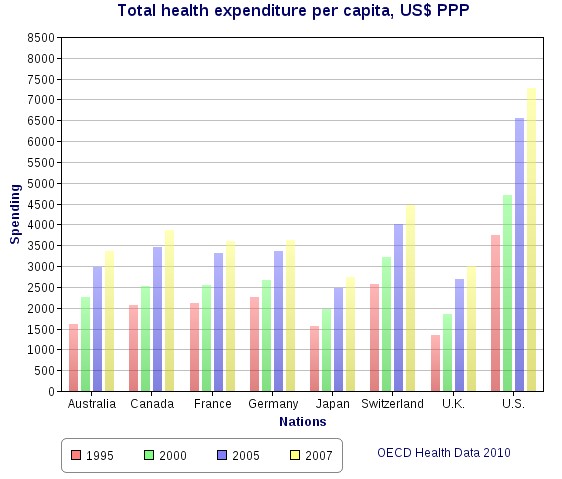 |
Those Americans citizen who
can actually afford health insurance pay a
ridiculous amount of money in premiums. Take
me for example. My $830 per month policy is
close to 25% of my income.
And for what? The
United States has the highest infant mortality rate
among high-income countries. We rank dead last
in terms of life expectancy among 17 affluent
nations.
source
• In 2013 the American
people will spend approximately 2.8 trillion dollars
on health care. There is no "cap" in sight.
• Unless changes are made, it is being
projected that Americans will spend 4.5 trillion
dollars on health care in 2019
• If the U.S. health care system was a
country, it would be the 6th largest economy on the
entire planet
• The Twisted Golden Rule: The U.S.
health care industry has spent more than 5 billion
dollars lobbying our politicians in Washington D.C.
since 1998
• Overall, Americans pay 50% more than other
countries for identical drugs as the result of laws
and regulations preventing the US government from
reining in drug prices like other countries do.
• The U.S. ambulance industry makes more money
each year than the movie industry.
Personal note: My
mother once could not get a friend to drive her
to a cancer radiation treatment appointment.
So the hospital sent over an ambulance billed at
$750.
And here is one more fact:
Nearly 60 percent of all personal bankruptcies in
the United States are related to medical bills.
|
This article is not just about the
poor who rely on the public hospitals supported by our tax
dollars.
This article is not just about
vulnerable, helpless patients dumped by the hospitals.
This article is not just about some
unlucky family with "pre-existing conditions" who cannot get
insurance at any cost.
There are actually
people like Sean Recchi who HAD health insurance, but it
wasn't "good enough"!!
Recchi's insurance did not
even begin to cover the exorbitant costs of his
cancer treatment. The industry calls these
people "underinsured".
Recchi paid $469 a month and
he was UNDERINSURED. I pay $830 a month.
Am I underinsured? Are you underinsured?
Are any of us safe from the
predatory practices of these hospitals and insurance
companies?
Think about that. Just one
accident, just one illness, and a decent, hard-working
American can see his entire life savings ruined by the
cutthroat business practices of America's hospitals and
insurance companies who work hand in hand.
The story of Sean Recchi was
just one very sad example in this mushrooming
phenomenon.
I believe that none of us are safe.
Here are
some more eye-opening examples.
|
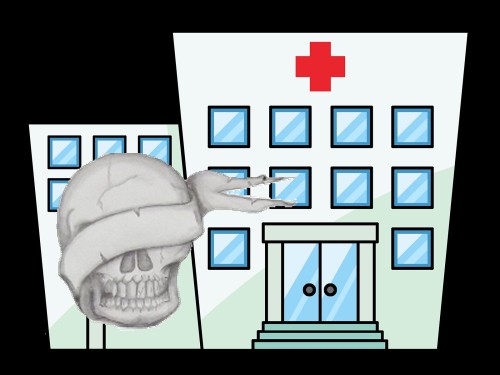 |
Hospital Charges Grow Like 'Compound Interest' In Opaque And
Irrational U.S. Health Care System
Source:
Huffington Post
Why would
Orange Park Medical Center in Florida charge $117,445 to
place a stent into a patient's artery, while the Mayo
Clinic half an hour away in Jacksonville charges less
than 45 percent of that amount?
The answer, in short, is because the U.S. health care
system doesn't operate according to the standards of
competition that govern other industries.
Hospitals often rule local fiefdoms using their own
idiosyncratic price-setting conventions, and the health
insurance companies that pay the bills have little
incentive to wage risky wars against prominent local
institutions.
The prices in the above example are drawn from a
database of charges at thousands of hospitals released
this month by the Centers for Medicare and Medicaid
Services. Variation of that level isn't out of the
ordinary among U.S. hospitals, which maintain detailed
price lists called "charge masters" for thousands
of services.
American hospitals are locked in a vicious cycle that
results in erratically inflating charges, which
increasingly bear little relation to the cost of medical
care or the amount actually paid. In practice, hospitals
set prices as if they have no competition at all --
something that's reflected in the Centers for Medicare
and Medicaid Services data.
Hospitals
tend to charge as much as they are able, knowing it's
nearly impossible for patients to determine what local
competitors charge or what health insurers pay.
The fact
that the system isn't affected by typical competition
metrics is a major reason why Americans often pay higher
health care prices than citizens of other developed
nations.
Bob and Becky
Weinkauf
A Family
Fights a $474,000 Hospital Bill
"We owe
nearly a half million dollars.
If we sold our
house and everything we own, we might be able to pay
maybe a quarter of the bill."
|
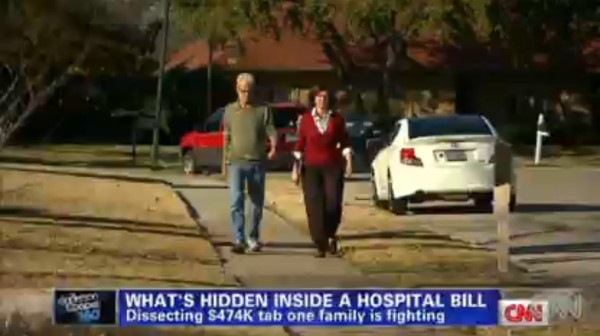 |
Rick Archer's Note: Bob Weinkauf's story is a prime
example of how a random medical incident can ruin a person
for life. While you read this story, don't ever lose
sight of the fact that this man had health insurance.
Of course, the industry would say he was "underinsured".
How about you? How about me?
Faced with these ridiculous costs, how can any of us believe
we are safe from the predatory practices of the American
hospital system who mercilessly exploit their incredibly
vulnerable patients?
You can see the
videotape version of this story on the CNN website.
Here is the transcript of the same story.
DREW GRIFFIN, CNN INVESTIGATIVE
CORRESPONDENT (voice-over):
Bob Weinkauf is finally healthy enough to make a short
walk from his front door to his mailbox, but it's a walk
he dreads because he knows what's waiting, medical
bills.
You might think you've heard this story
before, but not this one because the health care
industry has managed to keep this largely a secret. This
story is about what's actually in Bob Weinkauf's bills
and why he, and maybe you, are getting completely ripped
off.
BOB WEINKAUF, RECOVERING
PATIENT:
This full drawer
here and this drawer here are nothing but
medical bills.
GRIFFIN:
Last March, a sudden hacking cough put Bob in a
hospital intensive care unit. He was having
trouble breathing.
BOB WEINKAUF: I did
at some point, you know, make some kind of
reference to the nurses that I wanted to breathe
and so they put me on a ventilator, and that's
where it all started. I don't remember it.
GRIFFIN:
It was the bill that could eventually bankrupt
Bob and Becky Weinkauf.
(Nearly 60 percent of
all personal bankruptcies in the United States
are related to medical bills.)
|
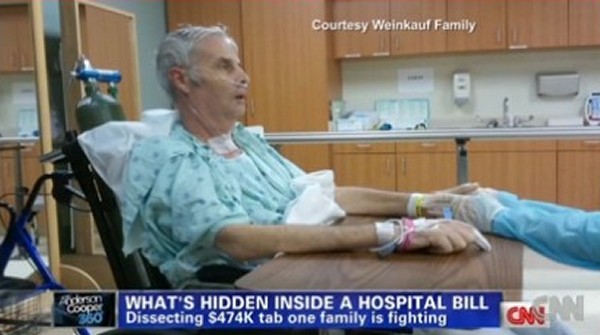 |
GRIFFIN:
At 60 years old, struggling to
keep a small business going, Bob had just switched to a
discount insurance company. After just four days of
treatment, the hospital was telling Becky her husband's
insurance would not even come close to covering the
costs.
BECKY WEINKAUF:
She said the bill is up to $80,000
already, and she said, Mrs. Weinkauf, I hope you realize
that you're responsible for this bill, and I got in the
car. My mother-in-law was with me. I think she was
scared to ride with me. I was just hysterical. I thought
what am I going to do? I've worked my whole life. Is
this how my life is going to end?
GRIFFIN:
The $80,000, it turns out, was
only the very beginning.
BECKY WEINKAUF:
Altogether I did total them up,
about $400,000.
GRIFFIN:
Well over, in fact, $474,016.60.
This is the summary of those charges, broad categories
with few details. Becky and Bob Weinkauf decided ask a
few questions and began to see just why health care in
America is so expensive.
Everything Bob touched, used, or was given came with a
whopping charge. Nurses pricked his finger to check his
glucose levels, 190 times, $39 a piece, the total bill?
$7,410 just for that.
Asking for that ventilator because he was having trouble
breathing? Thirty two separate billings, total cost,
$65,600. If he had been five years older and qualified
for Medicare, all of these items would have been a tiny
fraction of what he was billed. As it turns out, even
asking for a urine bottle cost him extra.
BOB WEINKAUF:
I'm just surprised they even
charge you for that? Isn't there a charge for the room
itself? Yes. There's a flat rate charge. I don't know
what's included. I guess, it's just a room and a bed and
everything else is -- because everything they brought
in, whether it be Kleenexs, urinal bottle, some kind of
tubing I needed for the iv or whatever, all of that was
an extra charge every time they did it, they changed it.
GRIFFIN:
Think that's outrageous? Take a
look at this little white cup. You probably last used
one of these getting ketchup for French fries. If you
have been hospitalized, you probably recognize it too.
It's that little white cup the nurse carries on a tray
to bring your aspirin.
Well, I want you to remember this little white cup
because in a minute I'm going to tell you a little
hospital billing secret about these little cups that you
will never forget.
Does anything surprise you anymore as to what
particularly a hospital will bill?
PAT PALMER, MEDICAL BILLING
ADVOCATES:
No, absolutely not.
GRIFFIN (voice-over):
Pat Palmer has made a career battling hospitals over
outrageous invoices. She's now battling for the
Weinkaufs. She and her two daughters run medical billing
advocates from her basement outside Roanoke, Virginia,
and each time the phone rings, it's most likely a newly
discharged hospital patient suffering sticker shock.
PAT PALMER, MEDICAL BILLING
ADVOCATES: Just
flabbergasted of the cost that's involved in the
treatment that they had. They never dreamed it would be
that high.
GRIFFIN:
So where in the world do the hospitals come up with
these prices? That, too, is shrouded in mystery.
Hospitals determine their own pricing off a master list
called the chargemaster. Journalist Steven
Brill, reporting for "Time" magazine says the Charge
master
is basically a way any hospital can charge any amount
for anything.
STEVEN BRILL, SPECIAL
CORRESPONDENT, "TIME" MAGAZINE:
It's a price list, and nobody can
really explain how this price list happened, and more
important, nobody wants to try to explain what the costs
are behind it because it's totally irrational. It varies
from hospital to hospital.
GRIFFIN:
A box of tissues becomes a mucous
recovery system, a teddy bear to cuddle? That's billed
as a cough suppression device.
PALMER:
Certainly as a patient you think
that's a nice gesture, a great gift. Not knowing that
you could be charged $128 to $20 for that teddy bear.
GRIFFIN:
Remember the little white cup?
It's billed as oral administration fees.
PALMER:
I've had a patient that had $5,000
worth of charges just for the little white cup to hand
you your medication three, four times a day.
GRIFFIN:
How do they get away with it?
Mostly they don't. In very stark terms, only the
uneducated, unrepresented or under or uninsured get
charged full price. Big insurance companies negotiate
discount rates. Medicare goes even further determining
preset prices, maximums a hospital can charge. For
people like Bob and Becky Winekauf, hospitals can charge
whatever they want.
GRIFFIN (on camera):
Can they ruin you?
BECKY WEINKAUF:
Well, of course they could. And the worry about
this bill is driving us insane.
BOB WEINKAUF:
Absolutely. There's no way in the world. If we
sold our house and everything we own, it would be maybe
a quarter of the bill. There's just no way. It would
kill us, literally.
(END VIDEOTAPE)
Summary
GRIFFIN:
Bob and Becky are still fighting
that bill, and they have asked us for now not to name
the hospital fearing it could damage any hope they would
have of a settlement, but they agreed to tell this story
really as a warning because this one illness of an
otherwise healthy guy will literally be costing them for
the rest of their lives.
JAKE TAPPER:
So where does all this profit end
up?
GRIFFIN:
Yes, it is flowing right into the
hands of hospitals and the insurers.
$474,000: "If
we sold our house and everything we own, it would be
maybe a quarter of the bill."
Rick Archer's Note:
As Wade Frazier said, "Money
does not evaporate in such scandals. It goes into
somebody's pockets."
And I asked the question:
So whose pockets get lined?
I think we have our answer.
|
Bob Weinkauf lives in a very
comfortable suburban home in Dallas. He is an
intelligent, well-educated, responsible man.
Bob, 60, was self-employed and bought the best
insurance plan he could afford at the time.
Then he simply got sick.
Weinkauf started coughing and couldn't breathe.
He landed in a hospital. Days later Bob was cured.
Then came the bad news: Bob
Weinkauf was in debt for a half million dollars
according to the hospital's "charge master".
Bob Weinkauf's story could
easily be your story or my story. After all,
don't we all get sick at some point? Isn't
that why we have insurance to protect ourselves from
financial ruin?
The way this system is
rigged, what is to keep any of us from losing our
entire life savings? No one
is safe.
The Mysterious Charge
Master
About the only defense for the
chargemaster rates Stephen Brill was able to get was
that it has to do with "charity". John Gunn,
chief operating officer of Sloan-Kettering
offered this preposterous explanation to Brill:
“We charge those rates so
that when we get paid by a [wealthy] uninsured
person from overseas, it allows us to serve the
poor.”
If this strikes you as
nonsense, you’re not alone. Brill found two major
holes in that argument. The first one is the most
obvious: The hospital is not only charging those
rates to wealthy medical tourists or “Saudi Sheiks,”
as Brill puts it, but to average American citizens
as well.
These chargemaster rates are
billed to average uninsured Americans who aren’t
poor enough to qualify for the hospital’s financial
assistance program, and don’t qualify for Medicaid.
[In other words, people like Bob Weinkauf]
So in essence, middle-class
Americans are being bankrupted to help pay for the
poor and the elderly while still allowing the
hospital to rake in massive profits and paying their
executives some rather astounding salaries.
For example, at Montefiore
Medical Center, a large nonprofit
hospital system in the Bronx, its chief executive
has a salary of $4,065,000, the chief financial
officer of the hospital makes $3,243,000, the
executive vice president rakes in $2,220,000, and
the head of the dental department makes a
not-so-shabby $1,798,000 per year.
Similarly, 14 administrators
at New York City’s Memorial Sloan-Kettering Cancer
Center are paid over $500,000 a year, including six
who make over $1 million.
[For every winner there
has to be a loser... or losers. Who do you
suppose pays the salaries of these men?]
|
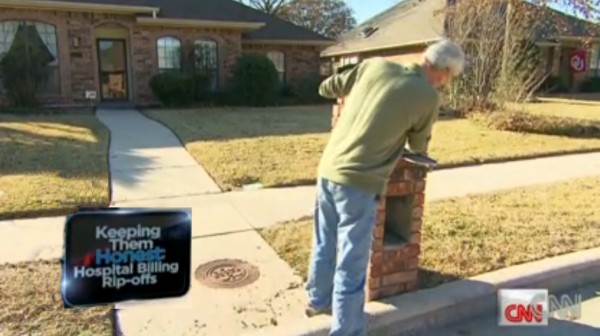
Bob Weinkauf
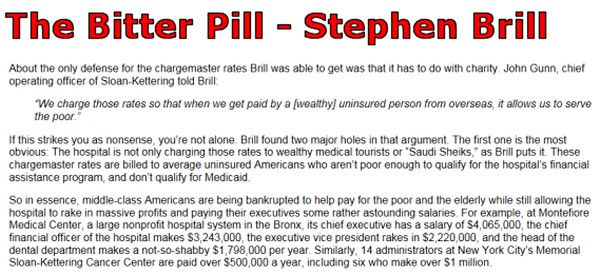
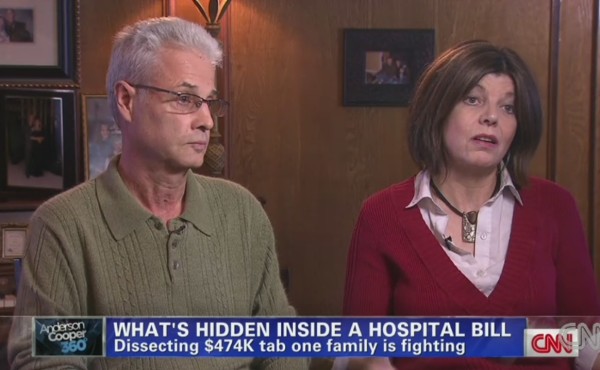 |
Here are a two more anecdotal stories
to further illustrate my point. These are stories that
were told to me by friends.
Rick's Story One:
One night a doctor's wife
whispered to me that her daughter had hurt her knee in
some freak accident while visiting Las Vegas. The
girl had to visit the emergency room for stitches.
The bill was $13,000.
Mind you, this is a doctor's
child. This man is a heart specialist who
theoretically should have good insurance.
But somehow this doctor ended up
paying much of that $13,000 out of his own pocket.
I was so incredulous that the next
morning I wondered if I had imagined the price tag.
Surely I misunderstood something.
How on earth could stitches cost
$13,000?
So I asked the woman via email to
confirm her story.
From: Rick Archer
[mailto: dance@ssqq.com]
Sent: Monday, November 11, 2013 5:13 AM
To:
Subject: RE: Dance teacher for salsa.
Hi there, hope your Salsa party worked out okay!
I am writing because my wife thinks I am nuts.
I told her you were billed
$13,000 for your daughter's 5 stitches in Vegas.
Then the more I thought about, the more I decided I
was confused. I can't believe it either.
Would you mind setting me straight? It has been
bugging me for days.
Rick Archer
I never got a response. So I
assume she did not want to see this information and her
name in print. However, based on the stress in the
woman's voice during our conversation, I think she was
telling the truth.
Rick's Story Two:
Another night I asked my friend
Jane how she has been coping with the loss of her
boyfriend to pancreatic cancer a year ago. She
replied that it still hurts every day. She lost
him just one month after diagnosis.
Then she began to cry. What
bothered Jane the most is that he had been complaining
about a pain in his stomach for the entire two years she
had known him. His doctor kept saying it was 'acid
reflux'. The poor man chewed TUMS around the
clock.
Meanwhile his body withered away.
When the pain got too great, her boyfriend went to see
someone else. That is when he got the bad news.
Angry, the boyfriend went back and
confronted his doctor.
Boyfriend: 'Why didn't you test
for cancer when I first came to you? If we had
caught this thing when I first complained, I might have
longer to live.'
Doctor's Reply: 'The test you
needed was not covered by your health plan.'
Boyfriend: 'Well, how much does
that test cost?'
Doctor's Reply: '$500.'
Boyfriend: ' I pay $1,000 a
month in premiums with one of the best insurance plans
in the country and they wouldn't even approve the damn
test?
What do I even
have insurance for?'
Doctor's Reply: 'No. It's not
covered.'
Boyfriend: 'I carry $500 in cash
on a regular basis and you didn't think to even mention
the test to me?'
Doctor's Reply: 'No.'
Each of
these stories could just as easily be your story or
my story.
Sean
Recchi DID have insurance. Bob Weinkauf DID have
insurance. But the hospital jacked up the
prices so much that it didn’t cover their bills.
Based on
our current medical insurance system, none of us is
safe, NOT EVEN RICH PEOPLE like Jane's boyfriend or
the doctor's daughter.
Look, I
don't give a damn if you are Democrat or Republican
and I don't care if you are rich or poor. I am
telling you we are all in this fix together.
The
health industry is soaking us blind. It is
completely out of control. There are
absolutely no competitive "market forces" to rein it
in.
Thanks
to the Twisted Golden Rule, the politicians and the
CEOs have seen to that.
Conclusion: None of us is safe.
|
 |
|
|
|
Need
for Health Reform
Rick Archer's
Note: The stories I have told are being
repeated across the nation on a regular basis today.
Study the chart.
Our medical costs are skyrocketing. In the six years
since that chart stopped in 2013, the gap has increased!
The reason we
have Obamacare is obvious - We need reform.
And yet the moneyed interests in our country are fighting
its implementation tooth and nail.
While the decade
of the 2000s may have been absolutely wonderful for the
rich, I am very skeptical that our nation as a whole is
better off today.
We have already
discussed the problems in the Health Industry. But
that is just the tip of the iceberg. There are other sectors
of our country that are equally suspect.
|
 |
Banking
Thanks to
deregulation and curbing the watchdogs, the banking industry
has seen a horrifying series of meltdowns. We had the
Savings and Loan Crisis in the Eighties, the Enron Crisis in
2001, and the Wall Street collapse in 2008. When it
comes to acting in the public interest, time and time again
the banking industry has shown a callous disregard for the
public good in its frenzy to maximize profits.
Detroit and the Electric Car
The documentary
Who Killed the Electric Car? made it very clear that
the Detroit car companies and the energy industry worked
hand in hand to defeat the electric car in the early 2000s.
The first electric car was called the EV1. It was made
by GM in response to a California law put in place to help
solve California’s severe smog problem. The law stated that
if a car company wanted to sell cars in California, at least
ten percent of the cars sold had to be electric.
The EV1 turned
out to be a pretty good car. At the time, the EV1 was fast,
quiet, and and spewed absolutely no smog into the air. It
required no gasoline and had a range of 100 miles. You
simply plugged it in to an electric outlet in the garage and
the next day it was good to go for another 100 miles.
In the late
Nineties, there was a two year period where several thousand
people test-drove the cars in California on a daily basis.
The people who had these cars loved them. But then
mysteriously Detroit killed its own car!
Why?
Detroit claimed
these cars were not for everyone due to their limited range
and dependency on special outlets.
|
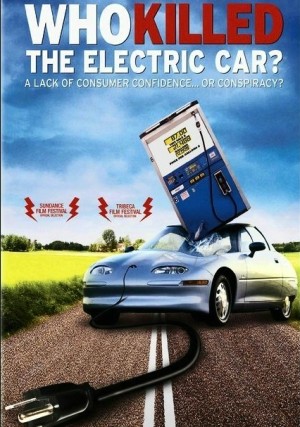 |
Detroit's claim
was roundly disputed. The people who had
been using the cars shot back that for 95% of the normal
uses of the electric car, 100 miles a day would have been
more than sufficient. Yes, an afternoon round trip
from LA to Vegas might be out of the question, but for the
daily commute to work, 100 miles got the job done cheaply
and without despoiling the air. And everyone pointed
out these cars were perfect for Los Angeles which could use
a break when it came to its smog problem.
So Detroit's
stated reason was just a smoke screen.
Energy
You will never
get the truth out of Detroit, but the writing on the wall
suggests these little cars were so darn effective that
someone got scared. So you have to ask who would
suffer the most if "electric cars" took off? You
guessed it - the oil companies.
The next thing
you know, the Bush Administration began to support a repeal
of the California law that had spawned these cars in the
first place. Then President Bush began a campaign to
allow more offshore drilling for oil and drilling in the
ecologically vulnerable Alaska. On paper, based on the
constant damage to the environment caused by burning fossil
fuels, the 180% U-Turn on the electric car made no sense at
all. But when you realize who the biggest loser would
be if the new technology succeeded - Exxon, BP, etc - you
understand why these powerful companies used their influence
to orchestrate a shutdown.
After all, there
was still plenty of oil in the ground; why end the party
before it was necessary?? However, the crazy weather
attributed to global warming caused largely by the continued
carbon dioxide emissions darkly suggested this attitude was
about as stupid and selfish as it could possibly be.
Wade Frazier,
the man who shared his experience in the Savings and Loan
collapse, also wrote in great detail how he watched advances
in "free energy", techniques such as wind power, fusion and
solar energy, be suppressed over the past 40 years. In
a manner very similar to how the medical world erases
potential "natural cures" for cancer, the oil companies do
the same thing to energy advances more efficient and cleaner
than oil. If you believe Frazier, the oil companies
have worked overtime in past years either killing any energy
invention or delaying its progress.
Medicine, cars,
energy: The stories all have a similar thread.
Whenever a technological advance threatens a
well-established industry, that industry acts in its own
self-interest to suppress any progress that might threaten
its bottom line.
The result of
all this greed is well-documented. We all know the
story. Thousands of cancer victims die because there
is no cure, the economy is stifled with one banking crisis
after another, and the environment becomes increasingly
threatened thanks to senseless energy policies.
However, out of
all the problems in America, health care absolutely belongs
at the top of the list.
It is time we
had health care reform.
|

Obamacare

|
Ads Attacking Health Law Stagger Outspent
Democrats
|
By CARL HULSE
15 January 2014
Source:
New York Times
WASHINGTON —
Democrats are increasingly anxious about an onslaught of television
ads hitting vulnerable Senate and House candidates for their support
of the new health law, since many lack the resources to fight back
in the early stages of the midterm campaign.
Since September, Americans for Prosperity, a group financed
in part by the billionaire Koch brothers, has spent an estimated $20
million on television advertising that calls out House and Senate
Democrats by name for their support of the Affordable Care Act
(Obamacare).
The unusually aggressive early run of television ads, which has been
supplemented by other conservative initiatives, has gone largely
unanswered, and strategists in both parties agree it is taking a
toll on its targets.
|
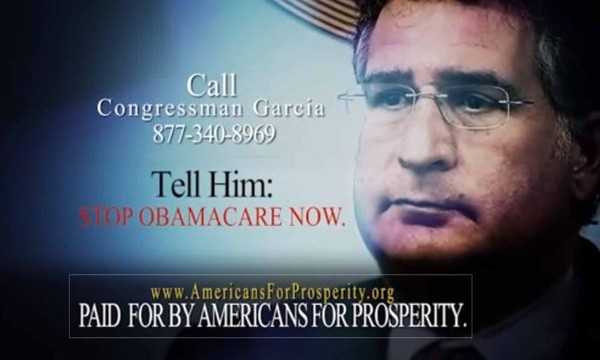
Americans for
Prosperity. Interesting name. Whose prosperity?
|
|
Is
Obama Care as bad as they say it is??
|
Rick Archer's Note:
I have to ask myself
this question: Why would anyone spend $20 million out of their
own pocket to defeat this bill?
Patriotism? I
doubt it.
We have seen before.
This sounds exactly like how they beat back Hillary Clinton's health
care reform 20 years ago.
This entire article has
been written with one purpose in mind:
I have tried to explain
the Twisted Golden Rule.
We have seen one example
after another of how the rich spend ridiculous amounts of money to
continually get their way.
And now here we go
again. For people my age, this fight over Obamacare is pure
déjà vu.
|
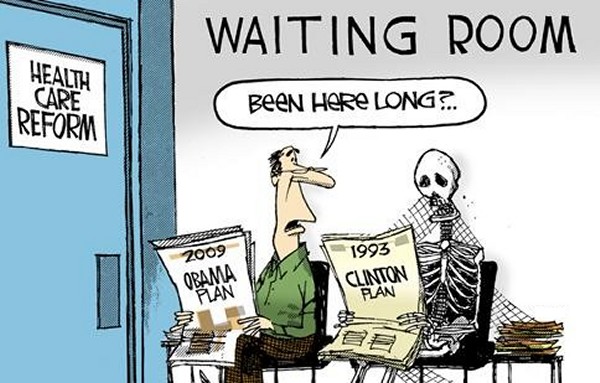 |
 |
Back in 1993, after all the various contributions were added up, the
health care industry had spent $100 million to defeat Hillary's
plan.
And how was Hillary Care
defeated? With attack ads like we are seeing again now.
The vicious fight in 1993 showed that people with money would stop
at nothing to get their way.
And they did get their
way.
Now it looks like
someone is spending exorbitant money to defeat Obamacare as well.
If you accept that the Twisted Golden Rule makes sense, then
you understand that moneyed interests know they need to spend money
to protect the insane profits that constantly flow into their
pockets from America's current broken health care system. In
the long run, they will always get their money back.
People with money can
get out their message. And it is no surprise that it is
effective. The uproar over Obamacare caused by the attack ads
is so intense that people who have little money barely stand a
chance of being heard.
The major point of my
article has been to demonstrate beyond the shadow of a doubt that
Washington AND Big Business are in bed together. Big business spends
millions to influence Washington. And Washington goes along with it.
The connection must be
broken or we will all continue to suffer.
|
|
Is Obamacare
any good?
I personally
have no idea whether Obamacare is any good or not.
I am not even remotely knowledgeable
about the inner workings of Obamacare.
Like every other American, I am worried. Neither my wife nor
I have the guts to trust Obamacare.
- I wonder why the
roll-out was so ridiculously flawed.
- I wonder why
insurance companies are dropping marginal customers like
flies.
- Although my own insurance was not cancelled, my
own monthly premium went up over $200 a month. Now over
20% of my monthly income is spent on health insurance. And yet, due to my fear of the unknown effects of Obamacare, I still pay the premium and feel grateful to have
it.
|
At the same time, there
is a nagging thought at the back of my mind that refuses to go away.
That thought goes like this:
Few of us here in
America have the time or the background to understand the
intricacies of complicated laws like Obamacare. Instead, time
and again we choose to listen to our trusted sources in the media.
This tendency - yes, I
am just as guilty as the next person - allows us to be manipulated
by the interests who have the most money to spend.
Is it possible
that we are being lied to about the Evils of Obamacare?
Could it be possible
that Obamacare might actually correct some of the terrible "wrongs"
in our health care system?
What I do know
that as Obamacare becomes implemented, many
Americans today are breathing a huge sigh of relief.
Previously uninsured, many people who were unable to get
insurance previously are now poised to benefit
from a system in which sickness or injury or pre-existing condition
does not have to subject one to medical deprivation and
financial ruin.
|
 |
Here is my take.
Our health care system is badly broken. Surely the
reader will not argue with me on that point.
We say we want a health system based on capitalist
principles, but that is not even remotely realistic here.
When it comes to
health care, we don't have true capitalism in America; we
have a system based on the Twisted Golden Rule.
Thanks to a
horribly skewed manipulation of laws by self-interest
groups, we now pay twice as much for our health care as most
other developed nations and have one of the worst overall
health systems in the world to show for it.
Here is a simple example of
the kind of crap that explains our current situation:
"Overall,
Americans pay 50% more than other countries for
identical drugs as the result of laws and regulations
preventing the US government from reining in drug prices
like other countries do." (source)
Does that sound
like "Capitalist Principles" to you?
Capitalism, profits,
competition and market
discipline are nice ideas, but
Capitalism in American Business now
seems like a cord word for "screw the public".
Whenever
a corporate giant is imperiled, our government rescues them
with taxpayer money and some ridiculous
phrase like "too big to fail" when in reality we
are left to wonder if some wealthy
insider is getting a bail out-from a crony after looting the
public.
The 2008 Wall Street
meltdown said it all. In truth, we have a business system that
rewards incompetence, greed and selfishness. The rich grow
richer; business ethics are a thing of the past. Regulators
are hamstrung in the interest of "free enterprise". The rich
spend countless dollars buying off politicians to pass laws that
exploit the working class.
Then the
businessmen - health insurance, pharmaceutical industry,
doctors, and yes even the lawyers - turn around and spend
more countless dollars to prevent reform.
The rich spend more countless dollars on propaganda
that compares Obamacare to socialism and communism.
The Fox News-style media scares us to death with threats
that the industrious middle class will be taxed into
oblivion.
|
 |
No one in my
circle of friends has any
real idea what to make of this highly-complicated Obamacare
reform. All we really know is what we have heard. And you know
what? I readily agree that Fox News is very effective at
putting doubt in our minds. These scare tactics
definitely work. Like everyone else, I am worried to
death that what little savings I have left will be taxed
away.
My email inbox
is bombarded daily with
messages that we are surely doomed if Obamacare takes hold and goes
into effect.
So is Obamacare
any good? As I said earlier, I do not know.
Ultimately I have no choice but to take someone else's word
on it. Unfortunately, at this point, there is so much
uproar and contradiction I don't know who to believe.
I have read articles
pro and con. While I was
researching Obamacare, I found a well-written article by
Jonathan Chait of New York Magazine. In Chapter
Two, Mr. Chait had several words of praise for Obamacare.
If you wish, you can go
read for yourself.
I am
also fairly certain I would not have any trouble finding
articles highly critical of Obamacare. All I have to
do is open one of those killer emails.
So, in the end,
there is so much information AND disinformation on the Internet, it really
boils down to who you trust.
So who do I
trust? Well, that's a tough question.
At this point, I
don't trust anybody. But I will say one thing:
I know exactly who I don't trust.
•
The Republicans defeated Hillary Care
in the Nineties and our health system got worse.
Credibility for Republicans: Minus One.
•
The Republicans passed their own
Medicare bill in the 2000s and our health system got worse.
Credibility for Republicans: Minus Two.
•
In the last election we had
Republicans telling the whole world that Romney was
practically a shoo-in to win; we know how that propaganda turned out.
Credibility for Republicans: Minus Three.
•
Then came that ridiculous Ted Cruz government
shutdown back in October 2013. To me, that was the
final straw.
Credibility for Republicans: Minus Four.
|
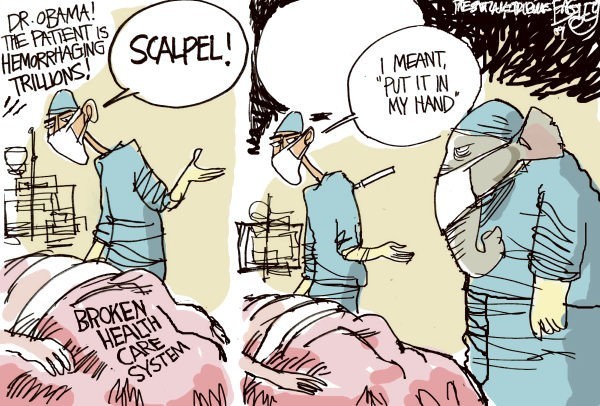 |
At this point, I
don't trust the Republican message. Okay, the
Republicans are screaming at the top of their lungs that
Obamacare is the worst legislation in history.
Got it.
I hear you. Maybe these messages will turn out to be
right, but why should I
listen?
Right now,
Republican credibility is lower than at any point in my
lifetime. It seems to me the Republicans will
say anything their masters bid them to say.
I say give
Obamacare a chance.
|
|
"And one
should bear in mind that there is nothing more difficult to
execute, nor more dubious of success, nor more dangerous to
administer than to introduce a new system of things:
for he who
introduces it has all those who profit from the old system as
his enemies, and he has only lukewarm allies in all those who
might profit from the new system.
This
lukewarmness partly stems from fear of their
adversaries, who have the law on their side, and partly
from the skepticism of men who do not truly believe in
new things unless they have actually had personal
experience of them."
-
Machiavelli in 'The Prince'
|
|
|